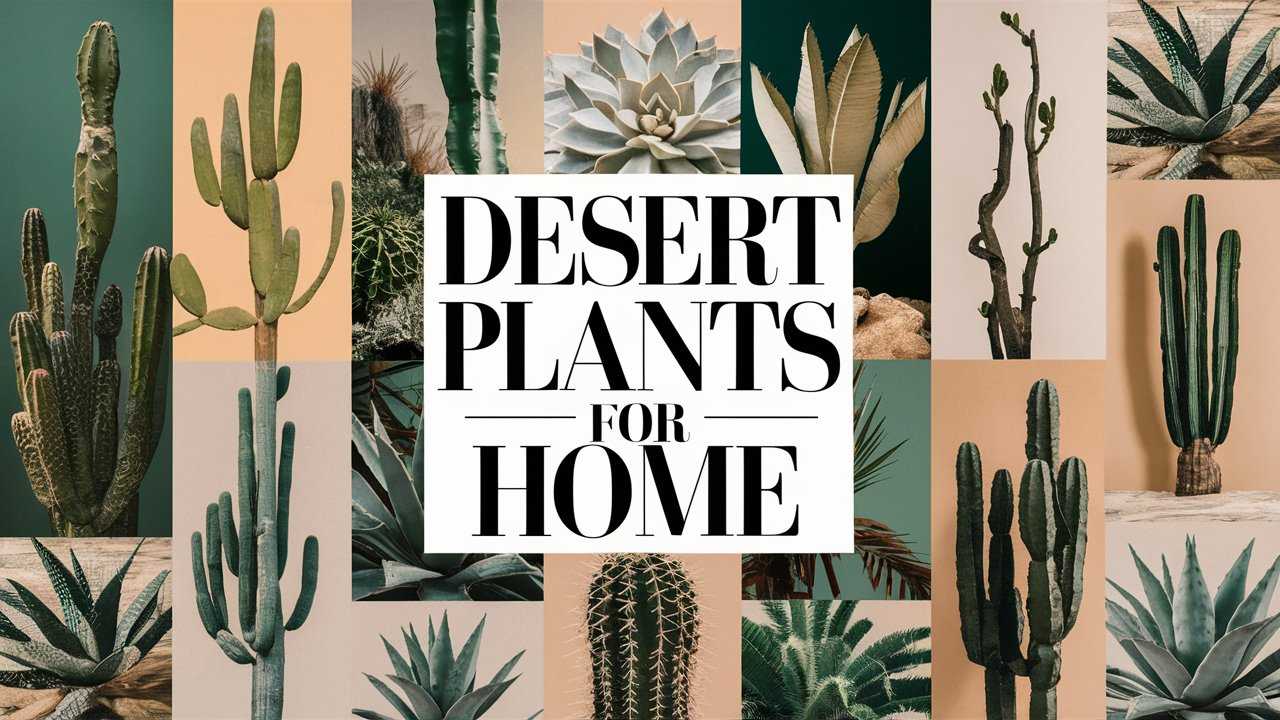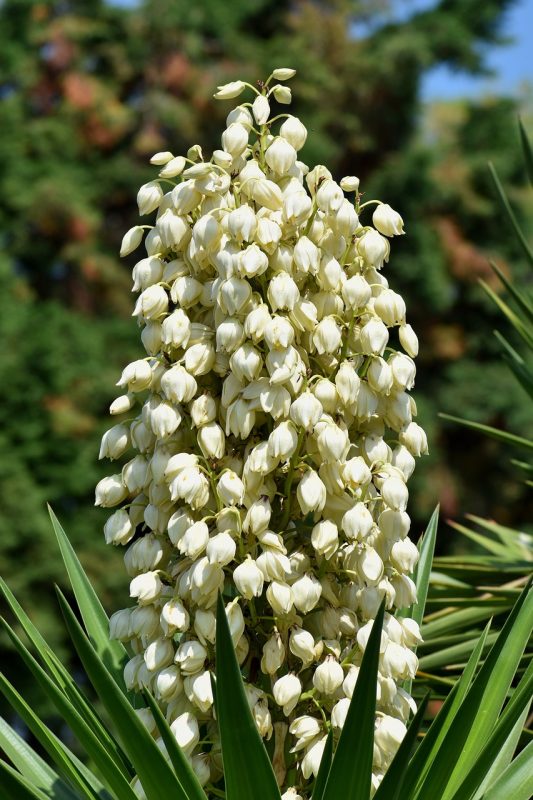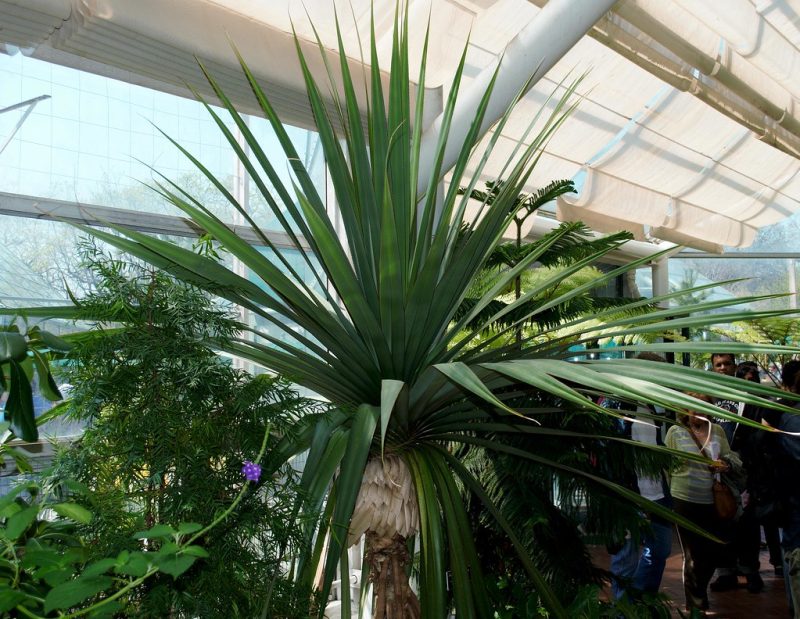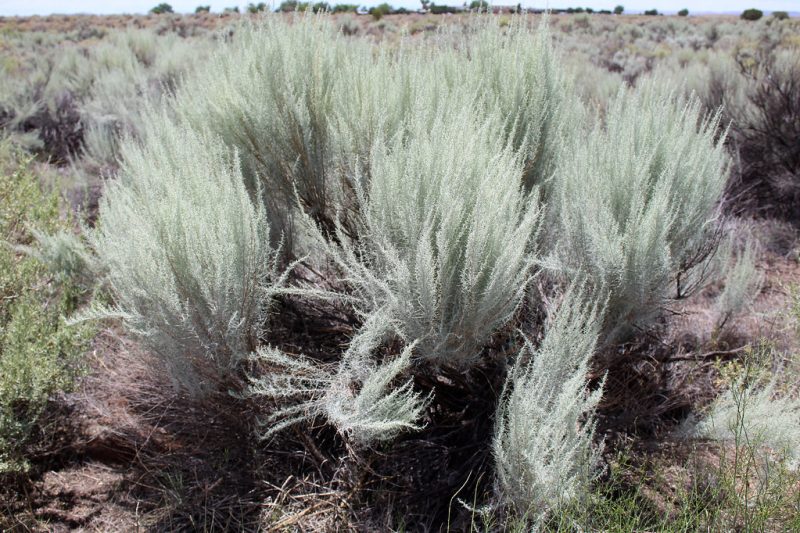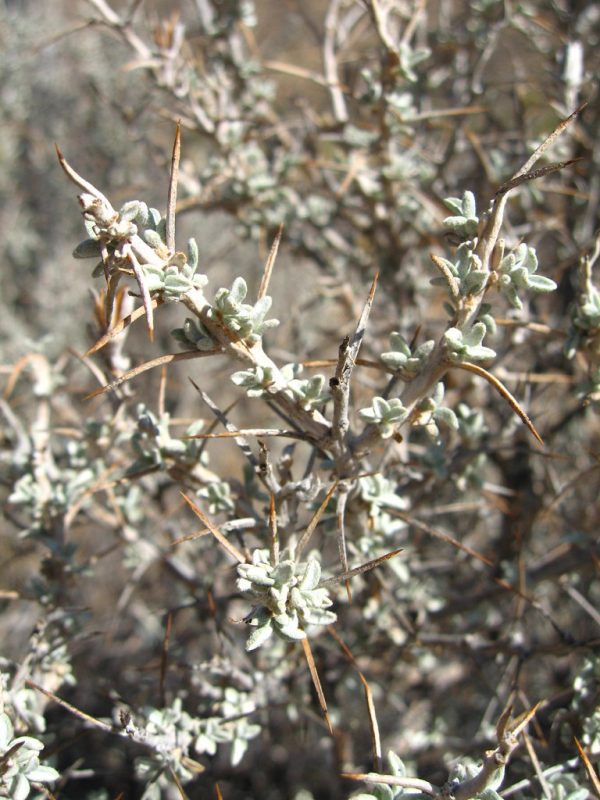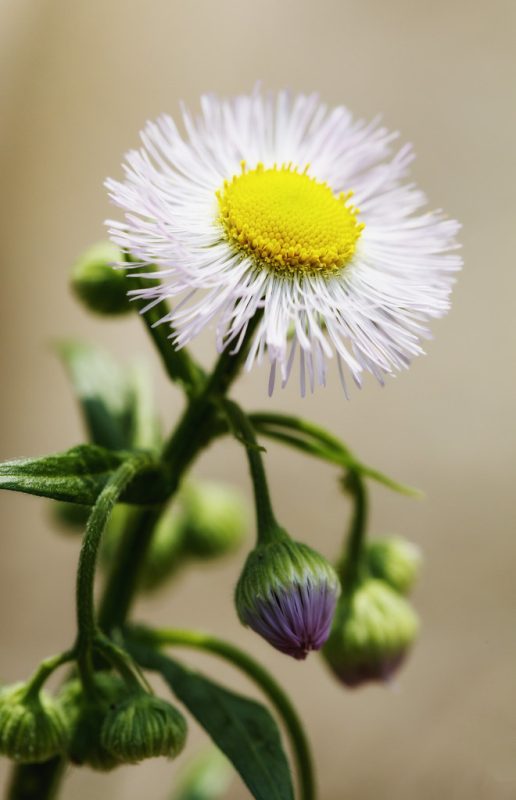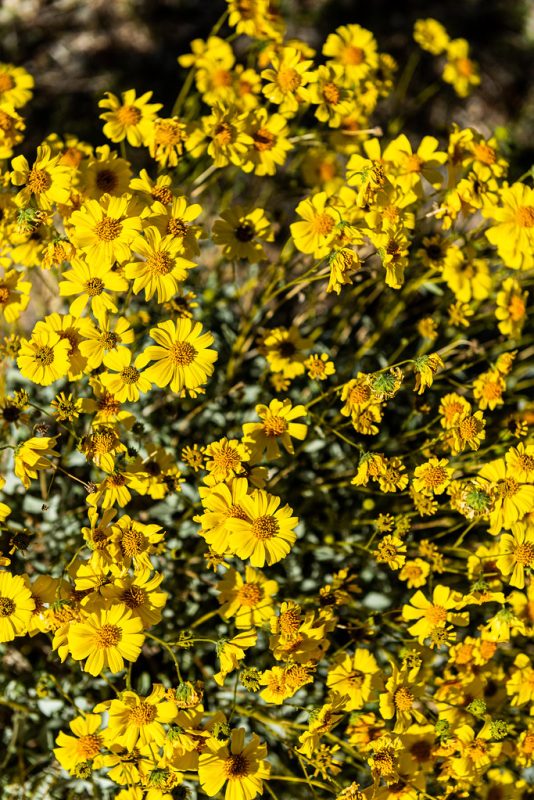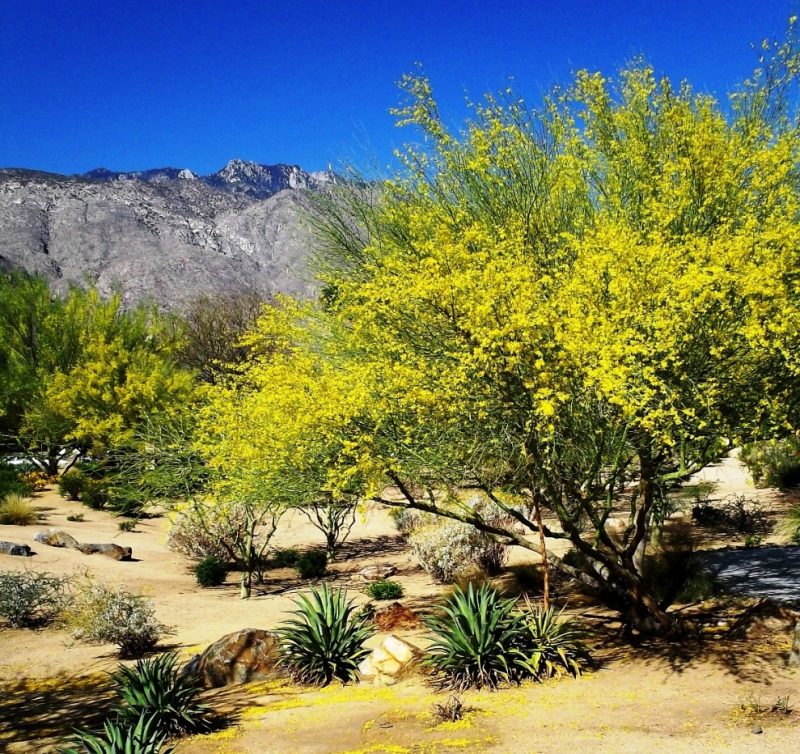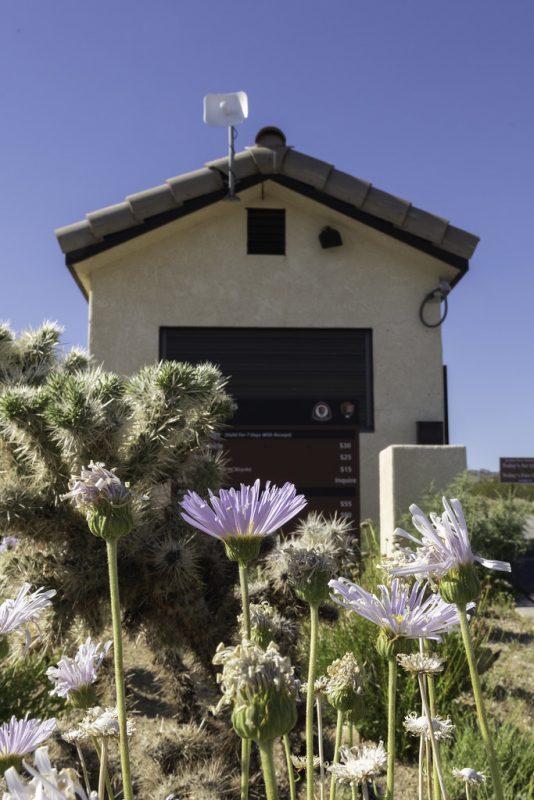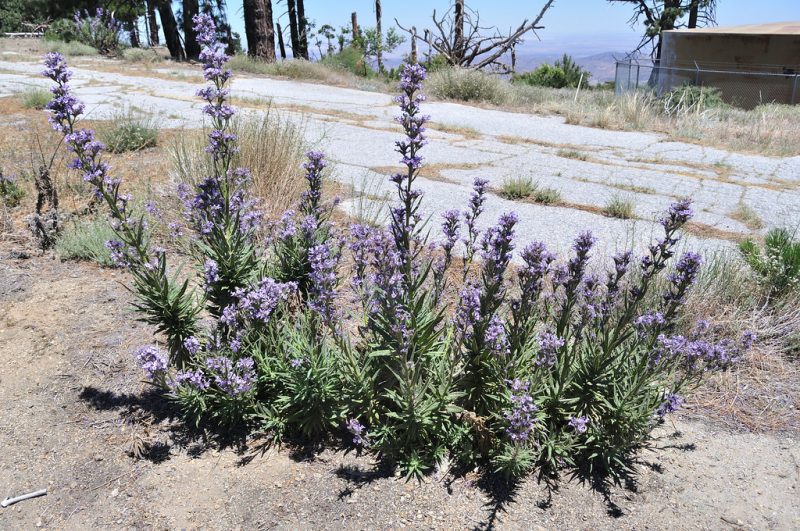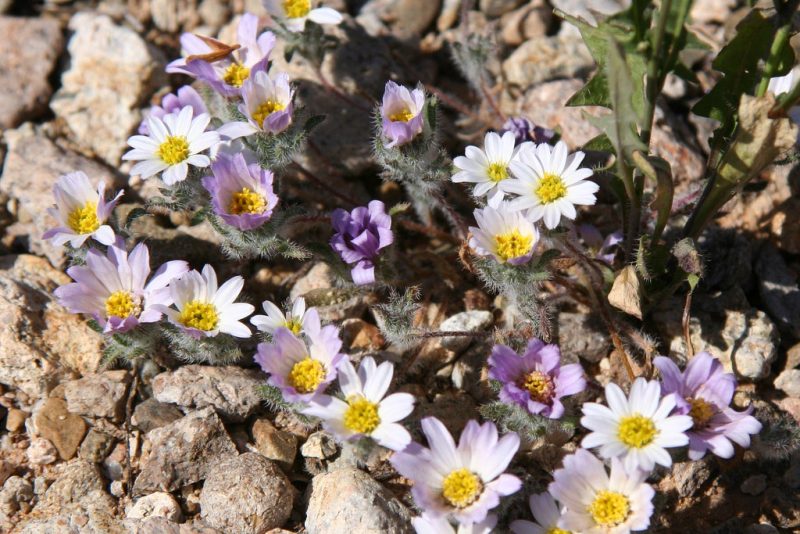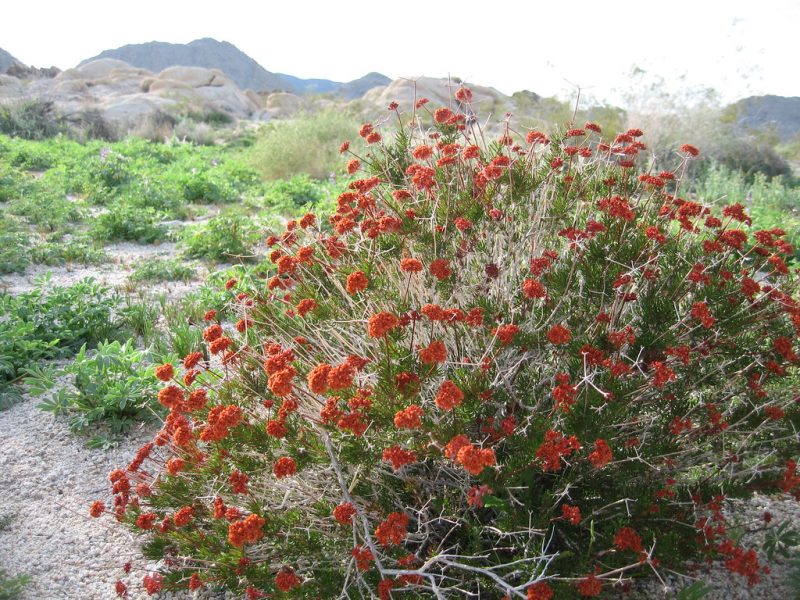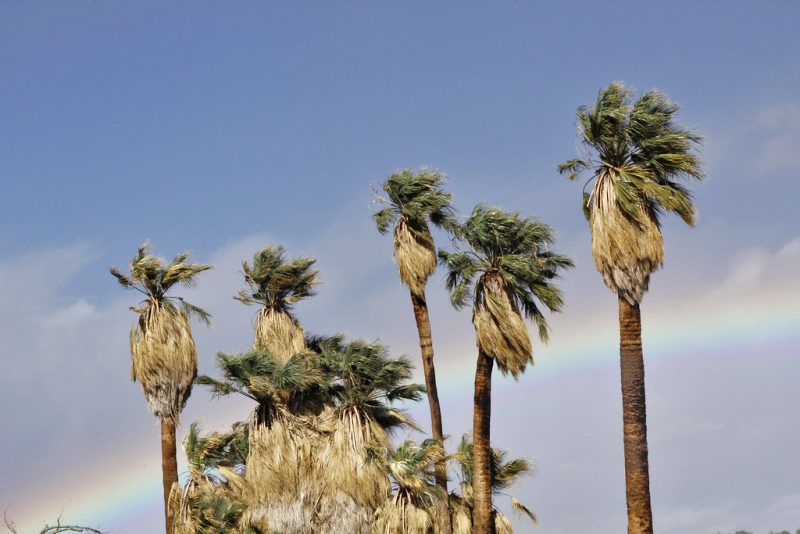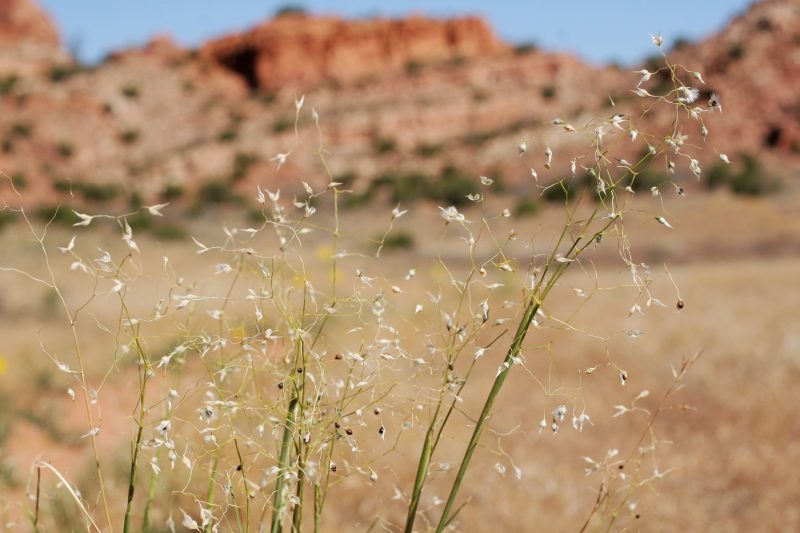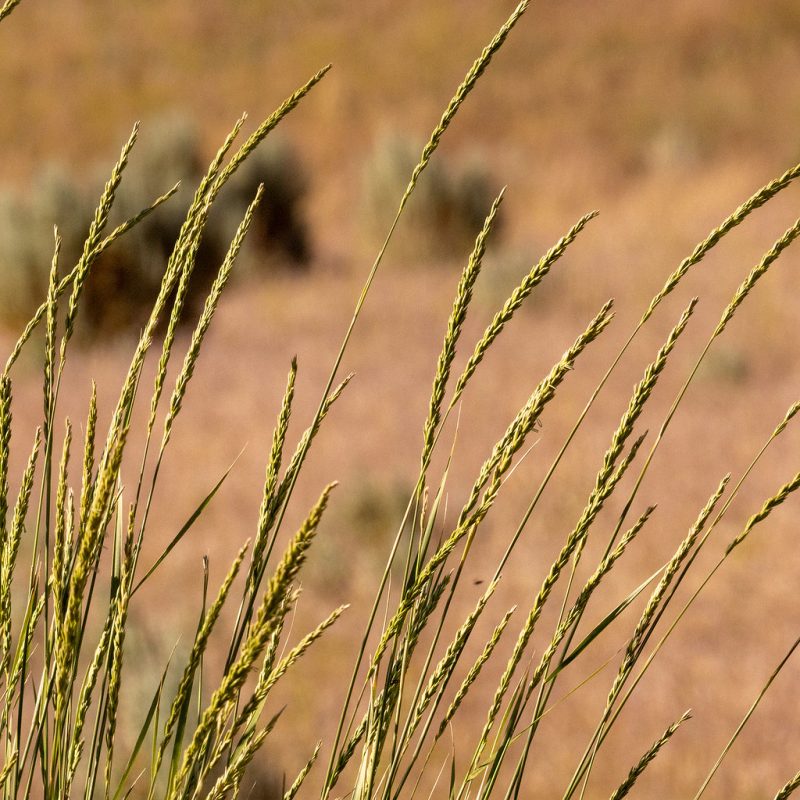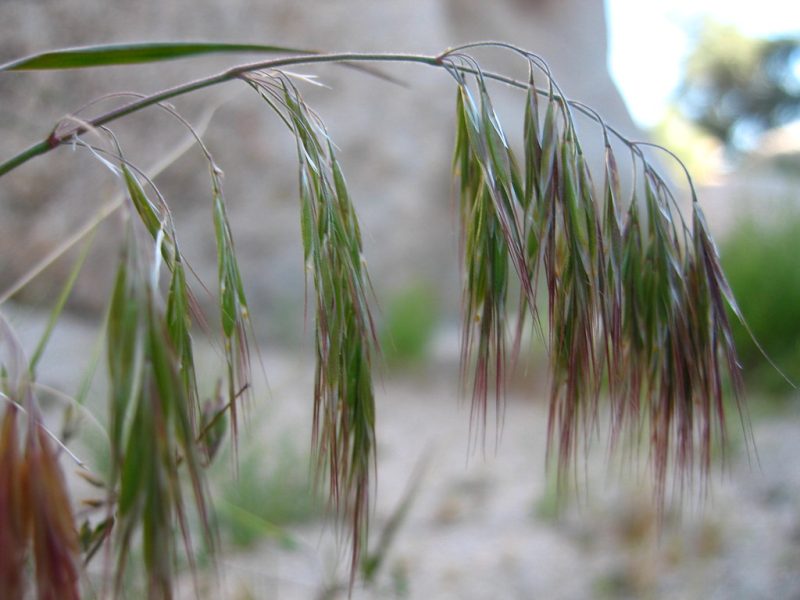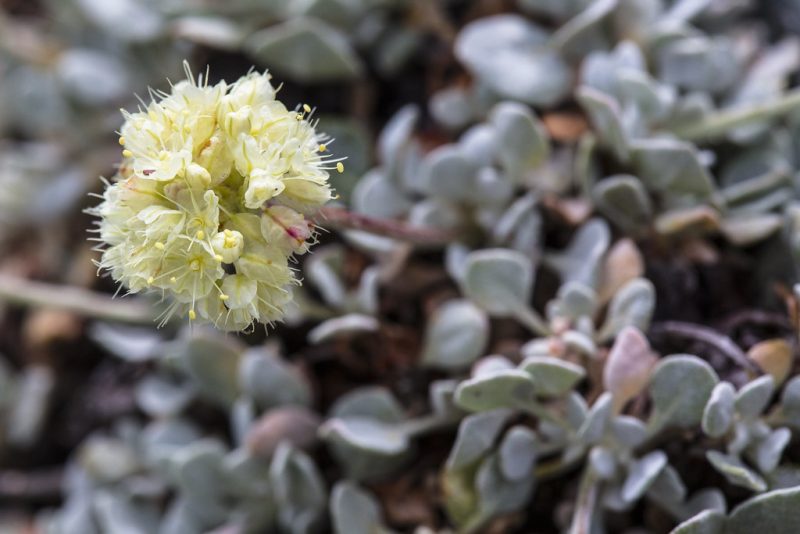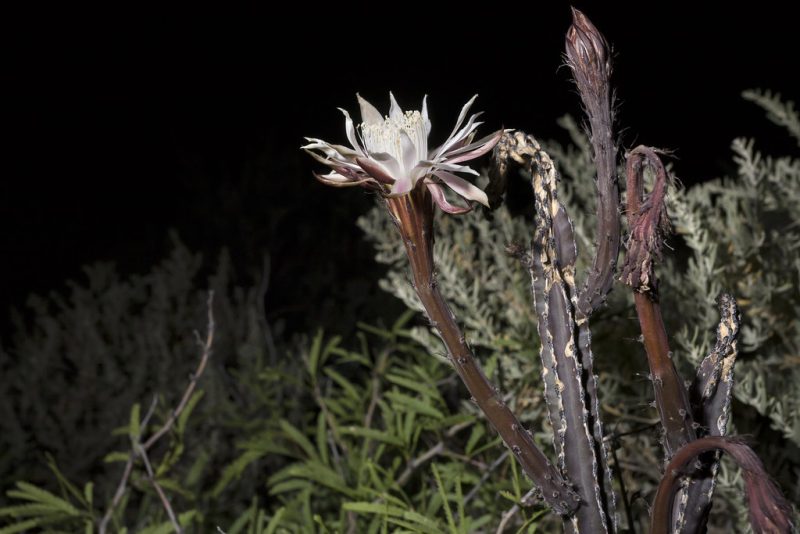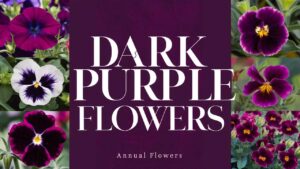In the quest to create a drought-resistant landscape that thrives in arid climates, homeowners often turn to resilient desert plants that not only endure tough conditions but also add aesthetic appeal.
Yucca
Yucca plants are quintessential representatives of desert flora, revered for their architectural form and diverse species. Most commonly recognized for their striking spiky leaves that can reach impressive heights, yuccas contribute a bold statement to any landscape. They are exceptionally hardy, thriving in poor, sandy soils with minimal water. Their drought tolerance makes them an ideal choice for xeriscaping—a landscaping philosophy aimed at conserving water.
One of the most captivating features of yucca is its stunning flower spikes that can rise above the foliage, showcasing clusters of bell-shaped white or creamy flowers during the warmer months. These blooms not only attract moths and hummingbirds but also add a splash of visual interest to your garden. Furthermore, certain species, such as the Yucca filamentosa, are evergreen, providing year-round greenery.
When incorporating yucca into your landscaping, consider strategically placing them in clusters for a dramatic effect. They do best in full sun and require minimal care, making them perfect for busy homeowners. Yucca plants can be integrated alongside ornamental grasses or other succulents, creating a layered, textural landscape that mirrors the natural beauty of desert ecosystems.
Oleander
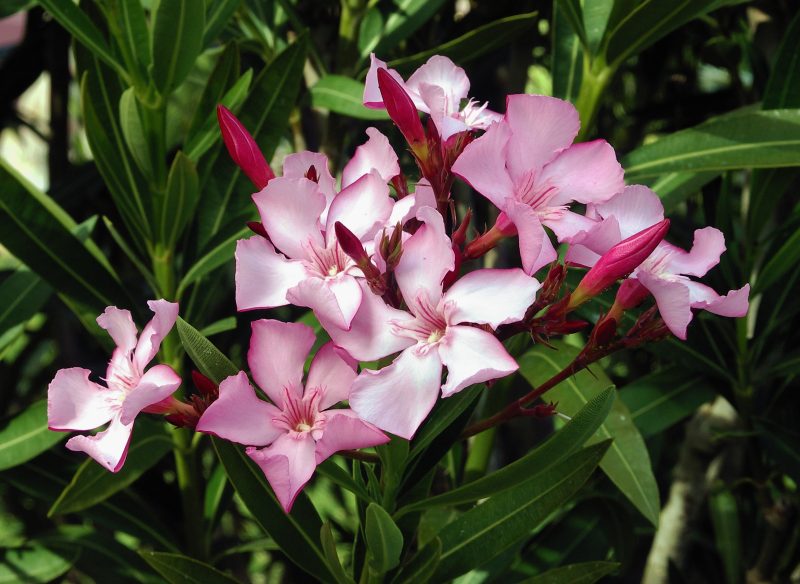
Oleander is often celebrated for its colorful, fragrant flowers and its surprising resilience. This shrub thrives in harsh conditions, making it a popular choice for those looking to introduce vibrant blooms to their desert landscapes. With varieties that showcase hues ranging from deep pink to bright yellow, oleander adds an uplifting contrast against the backdrop of sandy soils and muted greens.
Beyond its beauty, oleander is remarkably low-maintenance. Once established, it requires little watering and can tolerate long periods of drought, although it’s important to provide some irrigation during extreme heat to support flowering. This adaptability makes it an excellent pick for gardeners who prefer a ‘set it and forget it’ approach.
However, it’s important to note that oleander is toxic if ingested, which necessitates caution when planting in spaces frequented by children or pets. To maximize safety, consider situating oleander in more secluded areas of your landscape, where its beauty can be appreciated without concern. Additionally, oleander works well when planted near pathways or patios, as its fragrant blooms can enrich outdoor living spaces with delightful aromas.
Autumn Joy Stonecrop
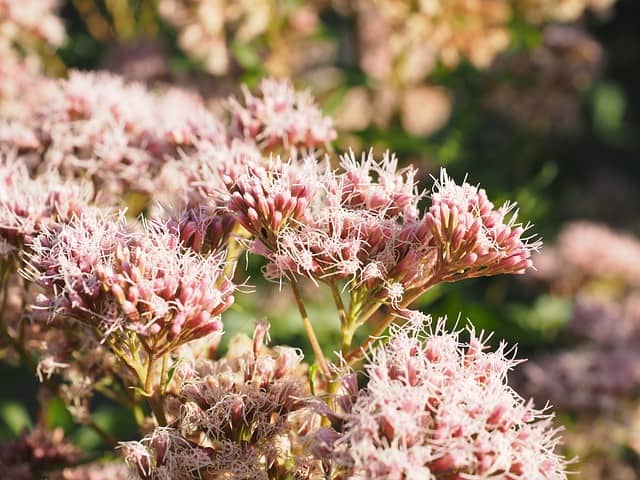
Autumn Joy Stonecrop, or Sedum spectabile, is a standout perennial that flourishes in rocky soils and requires minimal maintenance. Its thick, succulent leaves store water, making it an exceptional candidate for drought-tolerant landscaping. The plant’s ability to thrive in various soil types, coupled with its remarkable resilience to heat and poor conditions, makes it a favorite among gardeners seeking reliable, hardy options.
The true appeal of Autumn Joy Stonecrop reveals itself during late summer and early fall when the plant produces large, flat clusters of star-shaped, pink flowers. As autumn approaches, these blossoms transition to rust, bronze, or dark red hues, creating a warm and inviting palette just as many other plants begin to fade. This color shift provides vital interest in the garden during a season often marked by dwindling blooms.
In addition to its aesthetic appeal, Autumn Joy Stonecrop attracts pollinators, including bees and butterflies, to your landscape. It serves as an essential food source in the fall when many flowering plants have already finished their bloom cycles. When planning your garden design, consider planting this stonecrop in drifts for maximum impact, especially near paths or patios where its late blooms can be enjoyed.
Western Wallflower
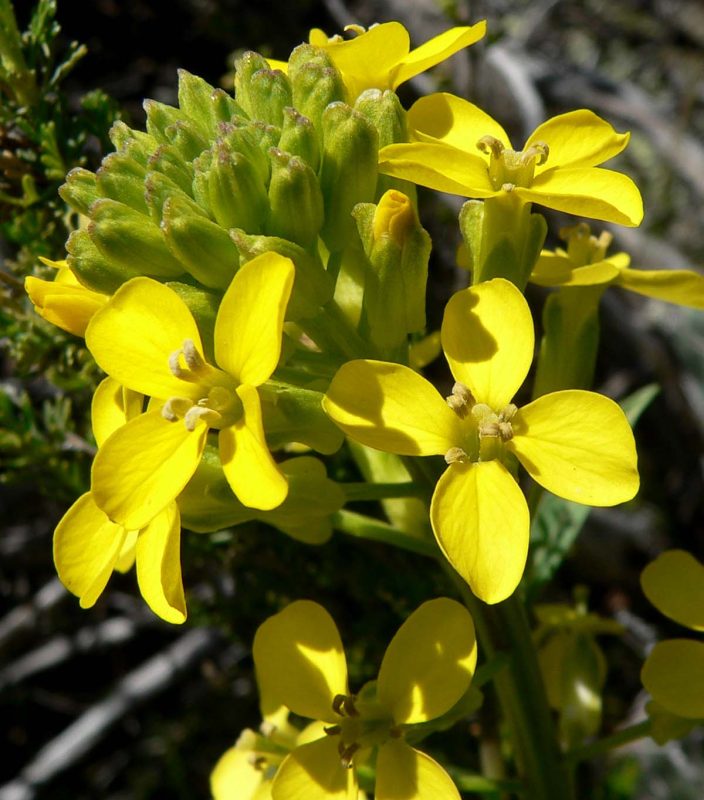
The Western Wallflower (Erysimum capitatum) is a delightful perennial that brings vibrant bursts of color to desert landscapes. Known for its bright yellow to orange flowers, this plant flourishes in a variety of conditions but thrives particularly well in rocky or well-drained soils that mimic its native habitat. The wallflower’s compact growth habit, typically ranging from 12 to 24 inches in height, makes it an excellent option for filling gaps in borders or for use in rock gardens.
One of the standout features of the Western Wallflower is its impressive flowering period, which can extend from early spring well into late summer. This extended bloom time provides a continuous source of nectar for pollinators such as bees and butterflies, thereby supporting local ecosystems. Additionally, the plant has a pleasant, slightly spicy fragrance that adds another sensory layer to your gardening experience.
To incorporate Western Wallflower into your landscape, consider planting it in clusters to create a vibrant focal point. It pairs beautifully with complementary desert natives, such as Agave or various ornamental grasses. Because of its drought resilience, this plant requires infrequent watering once established, making it an ideal choice for eco-conscious gardeners aiming to reduce water usage.
Spiny Aloe
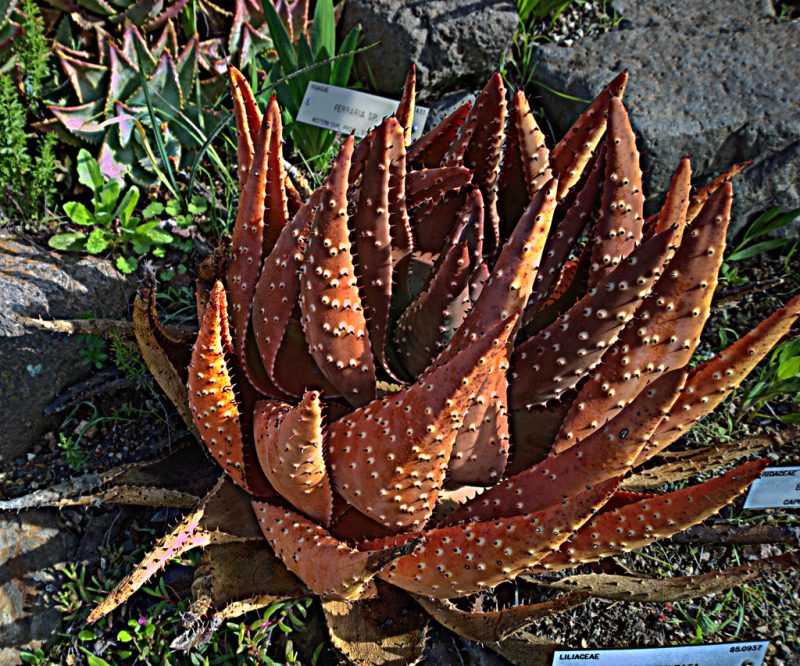
Spiny Aloe (Aloe aculeata) presents a captivating option for those looking to add texture and bold architectural elements to their desert landscaping. Originating from South Africa, this succulent plant features rosettes of spiky, blue-green leaves that are adorned with sharp edges, providing a striking contrast against smoother foliage in your garden. The intense coloration of Spiny Aloe becomes even more pronounced in sunnier locations, making it an ideal candidate for full-sun areas.
In addition to its visual intrigue, Spiny Aloe produces elongated flower spikes adorned with tubular orange to red flowers that attract a variety of hummingbirds and other pollinators. This characteristic not only enhances the plant’s ornamental value but also contributes to the garden’s ecological function by drawing in wildlife.
Maintenance of Spiny Aloe is minimal; it is highly drought-tolerant once established and thrives on infrequent watering. For those diving into desert landscaping, this plant can serve as an excellent focal point in rock gardens or desert-themed beds, where its vertical structure can contrast beautifully with horizontal ground covers. Spiny Aloe looks stunning when mixed with other succulents or set against boulders, providing a unique interplay of colors and textures in your outdoor space.
Broom Snakeweed
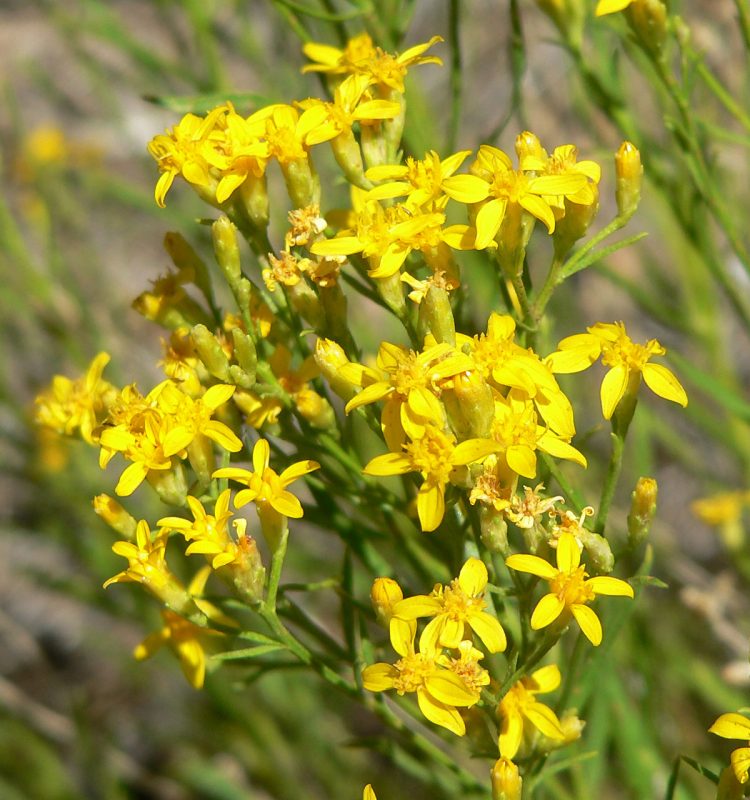
Broom Snakeweed (Gutierrezia sarothrae) is a hardy perennial often found in the wild across the arid southwestern United States. This resilient shrub typically grows to heights of 2 to 3 feet and is easily recognized by its bushy form and fine, threadlike leaves. One of the standout features of Broom Snakeweed is its excellent adaptability to various soil types, particularly disturbed and low-nutrient soils. This resilience enables it to thrive in challenging conditions where other plants might struggle.
In the landscape, Broom Snakeweed serves not only as a visual focal point but also plays a crucial role in the local ecosystem. Its bright yellow flowers bloom in late summer and fall, providing a vital nectar source for pollinators such as bees and butterflies, which are critical for maintaining biodiversity. Furthermore, Broom Snakeweed has a deep root system that helps prevent soil erosion, making it a valuable addition to slopes or areas with loose soil.
When designing a garden, consider grouping Broom Snakeweed with other drought-tolerant natives or ornamental grasses. This plant pairs well with plants that share similar water needs, creating a harmonious landscape. Its naturalistic form can also serve as a backdrop for smaller flowering plants, bringing depth and texture to your garden beds while requiring minimal maintenance.
Bluebunch Wheatgrass
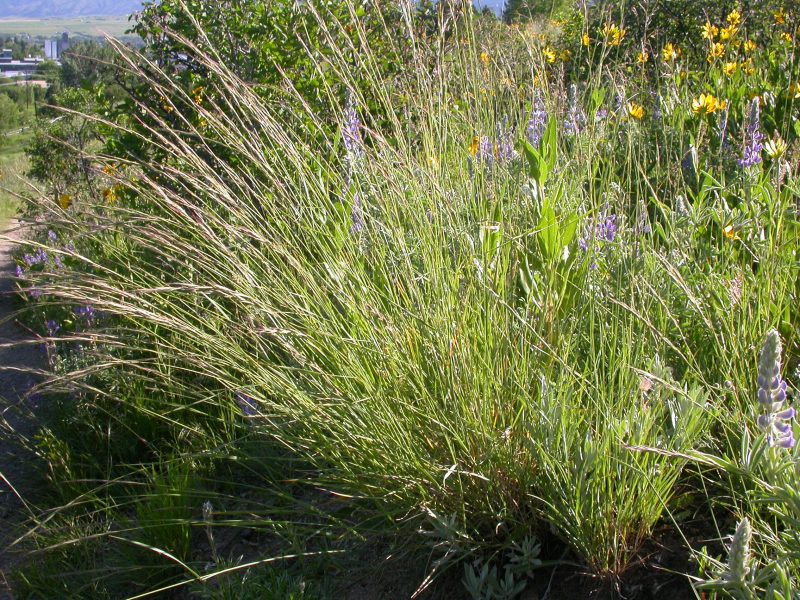
Bluebunch Wheatgrass (Pseudoroegneria spicata) is a perennial bunchgrass that is well-suited to desert landscapes and is often used in restoration projects due to its adaptability and ability to thrive in poor soils. With deep, fibrous roots, this grass excels at preventing soil erosion and improving soil structure, making it an outstanding choice for more environmentally responsible landscaping.
This species features upright stems that grow to heights of 2 to 3 feet, with attractive, fine-textured foliage that turns a pleasing blue-gray color. In late spring and early summer, Bluebunch Wheatgrass produces striking flower spikes, which add an elegant touch to the landscape. The flowers are not only aesthetically pleasing but also serve as a food source for various insects and wildlife, enhancing the ecological value of your garden.
Incorporating Bluebunch Wheatgrass into your landscape design can be done in several ways. It works beautifully as a transitional plant between different garden zones, or can be used to create sweeping drifts that mimic the natural look of the desert. Additionally, because it remains upright through much of the year, it provides visual interest during the winter months, especially when accented by frost or snow.
Blue Grama Grass
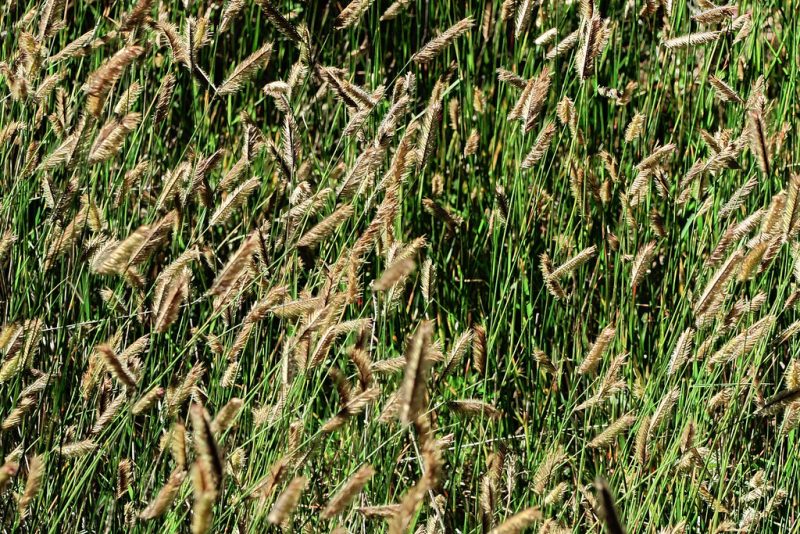
Blue Grama Grass (Bouteloua gracilis) is a beloved staple of the North American prairie, known for its incredible drought tolerance and adaptability. This perennial grass forms dense clumps that can reach heights of 1 to 2 feet and is notable for its unique seed heads, which resemble small, arching flower spikes that add a distinctive texture to the landscape. The plant’s robust growth makes it a wonderful choice for home gardens in arid climates, where it requires minimal irrigation.
The beauty of Blue Grama Grass extends beyond its attractive appearance; it is a vital habitat for various wildlife species. It serves as a nesting ground for birds and provides forage for grazing animals, thus playing a key role in supporting local ecosystems. Furthermore, its extensive root system helps improve soil health, making it a smart choice for eco-conscious landscaping.
When planning your garden, Blue Grama Grass can be used as a standalone feature or combined with other native plants for a cohesive look. It works particularly well in ornamental meadows or prairie-style landscapes, where its graceful seed heads can swaying gently in the breeze. For a vibrant and sustainable garden, consider grouping it with plants like Sagebrush or Desert Marigold, creating a stunning palette that celebrates the desert’s natural beauty.
Autumn Charm Stonecrop
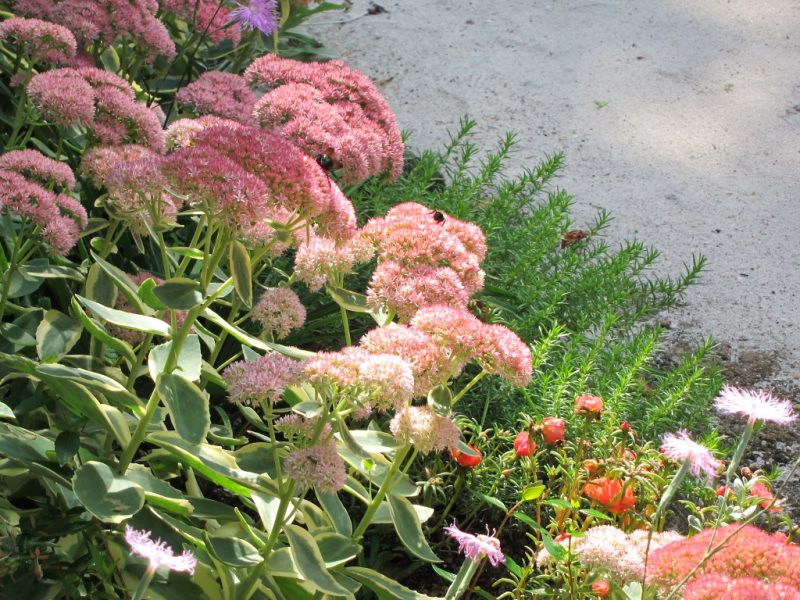
Autumn Charm Stonecrop (Sedum ‘Autumn Charm’) is a stunning succulent that thrives in desert conditions, known for its beautiful foliage and vibrant flowers. This low-growing perennial features thick, fleshy leaves that are frosted with a lovely blend of greens and cream, becoming even more visually striking in autumn when they transition to shades of gold and red. It typically reaches a height of about 12 to 18 inches, making it the perfect choice for ground cover or for filling in garden beds.
One of the standout attributes of Autumn Charm Stonecrop is its adaptability to various soil types, especially well-draining options. This adaptability allows it to flourish even in rocky environments, where traditional garden plants might falter. In late summer and fall, this stonecrop produces clusters of star-shaped pink flowers that not only enhance its visual appeal but also attract bees, butterflies, and other beneficial pollinators to your garden.
For optimal placement, consider utilizing Autumn Charm Stonecrop in mixed perennial gardens, rock gardens, or as a border plant. Its low water requirements and ability to flourish in full sun make it an excellent choice for xeriscaping. Additionally, pairing it with other drought-tolerant plants like Lavender or Yarrow can create a diverse and visually appealing landscape that celebrates the beauty of drought-resilient flora.
Buddha’s Temple

Buddha’s Temple (Crassula perfoliata var. falcata), often referred to as the Propeller Plant, is a captivating succulent native to South Africa that adds an exotic touch to desert landscaping. This distinctive plant is recognized for its striking, propeller-shaped leaves that grow in pairs, creating a unique and architectural appearance. The foliage ranges from a soft gray-green to blue-green and can develop a lovely red tinge under ample sun exposure, enhancing visual interest throughout the seasons.
Buddha’s Temple is not just eye-catching; it is also incredibly low-maintenance, requiring minimal watering once established. This plant thrives best in well-drained soil and should be positioned in full sun to maximize its growth potential. In late summer, you may be rewarded with clusters of small, star-shaped red flowers that bloom atop the plant, attracting bees and butterflies to your garden.
Incorporating Buddha’s Temple into your landscaping design provides not only a versatile plant but also a conversation starter. It can be used as a focal point in rock gardens or succulent displays, providing contrast against its surrounding foliage. Additionally, it works well in container gardens, where its unique shape can draw attention on patios or decks. Its ability to adapt to different conditions ensures that it will thrive in various garden settings, from formal designs to more relaxed, informal landscapes.
Screw Pine
Screw Pine (Pandanus spp.) is a versatile tropical plant that thrives in warm, resonant desert environments. While not a true pine, this fascinating plant is recognized for its spiky leaves and curious root structure, which can add a dramatic flair to any garden. Screw Pines can grow to heights of 10 to 20 feet, depending on the species, and their unique aerial roots can give them an impressive presence in the landscape.
One of the primary attractions of Screw Pine is its resilience and adaptability to a variety of soil types, including sandy and coastal soils. The leaves of this plant are strap-like and can be deeply twisted, creating a striking, architectural effect. In addition to their visual qualities, Screw Pines can produce small, pineapple-like fruits that are edible when ripe, adding an unusual culinary aspect to the landscape.
When planting Screw Pine, it’s best to provide ample space to accommodate its growth. This plant loves full sun and can tolerate drought conditions well, making it perfect for home landscaping in arid regions. Combining Screw Pine with other low-maintenance desert plants, such as Agave or Aloes, can create a stunning tropical-inspired oasis in your yard. Make sure to provide good drainage to prevent waterlogging, which can harm its root system.
Topsy Turvy Echeveria
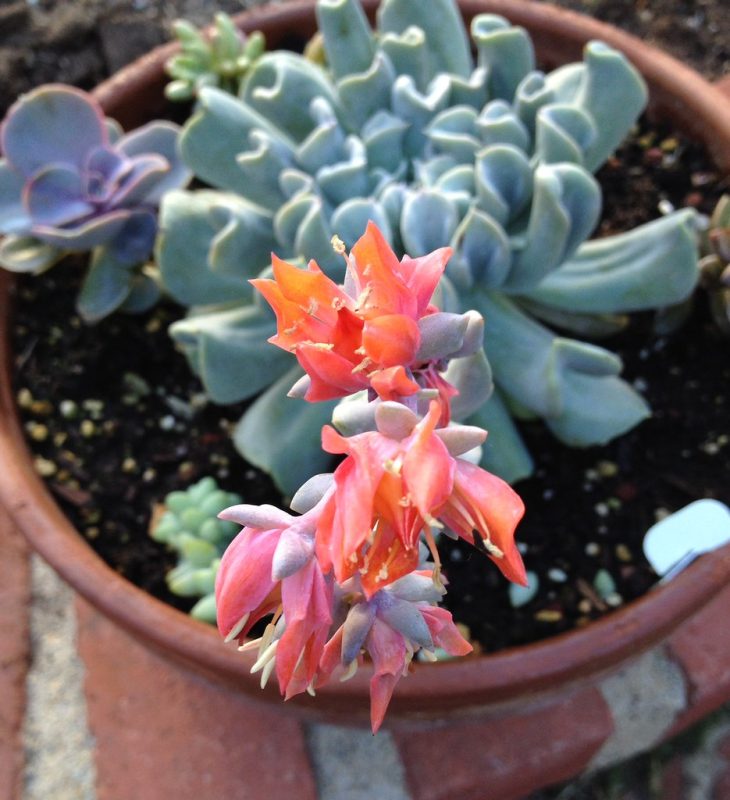
Topsy Turvy Echeveria (Echeveria secunda) is a charming succulent known for its unusual and captivating shape. Unlike many Echeveria species that grow upright, the Topsy Turvy variety presents a distinctive rosette form with leaves that twist downward, giving it a whimsical, almost playful appearance. The thick, fleshy leaves boast a mix of soft blue and green hues, often highlighted with a subtle reddish tint along their edges, making it a vibrant addition to any desert garden.
This succulent thrives in bright sunlight and well-drained soil, preferring conditions that mimic its native arid environments. Its low water requirements make it particularly well-suited for xeriscaping, where minimizing water usage is paramount. Once established, Topsy Turvy Echeveria can tolerate periods of drought, flourishing with minimal maintenance.
In landscaping, Topsy Turvy Echeveria works beautifully in rock gardens, container arrangements, or as part of a mixed succulent display. Its unique leaf formation becomes a conversation piece and attracts attention when placed against contrasting textures like gravel or smooth pebbles. For a dynamic look, consider pairing this succulent with other colorful varieties of Echeveria or ornamental grasses, creating a stunning interplay of shapes and colors that celebrates the beauty of desert flora.
Sand Sagebrush
Sand Sagebrush (Artemisia filifolia) is an aromatic perennial shrub native to the sandy soils of North America’s Great Plains and deserts. This shrub is characterized by its slender, silvery-green stems and fine, feathery leaves that provide not only textural variety to landscaping but also an appealing scent when touched. Sand Sagebrush typically grows 2 to 4 feet tall and is often used for its ornamental and ecological benefits.
One of the significant advantages of Sand Sagebrush is its exceptional drought tolerance, which allows it to thrive in some of the driest conditions. It plays a vital role in preventing soil erosion and providing habitat for wildlife in desert regions. Additionally, the tiny yellow flowers that bloom in late summer provide nectar and pollen, enriching the local ecosystem by attracting various pollinators.
When incorporating Sand Sagebrush into your home landscape, it can serve as an excellent backdrop for wildflower gardens or as part of a native plant palette that promotes biodiversity. Its bushy form creates effective windbreaks, and its delicate structure can soften harsher lines in a garden design. Moreover, the fragrant foliage can add an aromatic element to your outdoor space, making it a sensory delight while requiring minimal care.
Hawksbeard

Hawksbeard (Crepis spp.) encompasses several species native to arid regions, each characterized by their rugged adaptability and striking flowers. This perennial plant forms a rosette of narrow, linear leaves and sends up tall flower spikes that produce clusters of bright yellow blooms, resembling tiny daisies. The flowers typically bloom in early spring to late summer, adding cheerful splashes of color to the desert landscape.
Attracting various pollinators, such as bees and butterflies, Hawksbeard plays an essential role in supporting local ecosystems. One of its most appealing qualities is its ability to flourish in poor soils and withstand drought, making it ideal for homes seeking to adopt a low-maintenance, water-wise approach to landscaping. Its deep taproots enable it to access moisture and nutrients from deeper soil layers, enhancing its resilience in challenging environments.
Hawksbeard can be used in various landscaping applications, including wildflower gardens, native plant beds, and as part of a pollinator-friendly design. Its versatility allows it to blend harmoniously with other native plants, creating a lush and diverse habitat that supports local wildlife. For those looking to enhance the biodiversity of their gardens, incorporating Hawksbeard not only adds visual interest but also contributes significantly to ecological health.
Creeping Oregon Grape
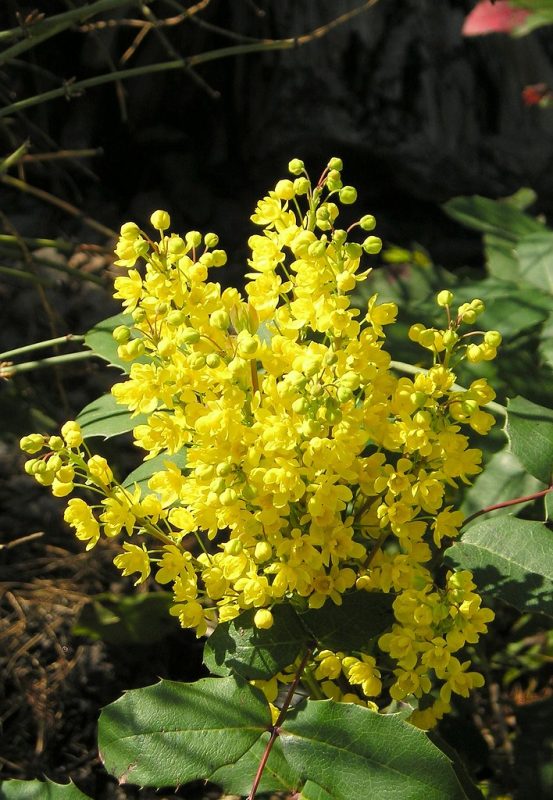
Creeping Oregon Grape (Mahonia repens) is a striking evergreen ground cover that thrives in the arid regions of the western United States. Its leathery, holly-like leaves provide year-round interest, with foliage that turns a brilliant burgundy in the fall. This plant typically grows low to the ground, reaching heights of only about 1 foot while spreading outwards to form a dense mat. One of the standout features of Creeping Oregon Grape is its vibrant yellow flowers that emerge in early spring, followed by blue-purple berries in the summer, which are not only visually appealing but also attract birds and other wildlife.
This hardy plant is well-suited to a variety of soil types, including sandy, rocky, and clay-based soils, making it versatile for landscaping. It prefers partial shade but can tolerate full sun if given adequate moisture. The ability to withstand dry conditions once established makes it a great candidate for low-water gardens.
In landscaping design, Creeping Oregon Grape can be a fantastic choice for erosion control on slopes or as a colorful ground cover that reduces weed growth. Its striking foliage and berries provide seasonal interest, making it an excellent choice for mixed plantings with other drought-tolerant species. Pairing it with ornamental grasses or colorful succulents can create a dynamic look that evokes the natural beauty of the desert.
Spineless Gray Horsebrush
Spineless Gray Horsebrush (Tetradymia stenolepis) is a remarkable shrub native to the southwestern deserts, with adaptations that allow it to thrive in harsh, arid environments. This perennial plant features thick, woody stems covered in silver-gray leaves, which have a unique, velvety texture. While the plant typically reaches a height of 2 to 4 feet, its dense, sprawling habit can effectively fill spaces in landscape design, providing both structure and visual interest.
The Spineless Gray Horsebrush is particularly appealing due to its ability to withstand both drought and frost, making it ideal for regions with extreme weather variations. Its ability to thrive on poor, well-draining soils further underscores its suitability for water-wise gardening. In late summer, this plant produces small, yellow flowers that attract pollinators, such as bees and butterflies, enriching the biodiversity of your garden.
This shrub can be effectively used as a low-maintenance hedge or accent plant in larger desert landscapes, offering year-round visual texture while requiring little to no irrigation once established. It pairs beautifully with other native plants, such as Desert Lavender or Red Yucca, creating a harmonious desert aesthetic. The overall resilience and striking appearance of Spineless Gray Horsebrush make it an essential component of any sustainable desert garden.
Fleabane Daisy
Fleabane Daisy (Erigeron spp.) is an attractive perennial herb that thrives in both desert and mountainous regions. This adaptable plant features slender stems that can grow between 1 to 3 feet tall, adorned with small, daisy-like flowers that vary in color from white to shades of pink and purple. The blooms appear in abundance during late spring and early summer, providing a lovely burst of color that delights gardeners and pollinators alike.
One of the key benefits of Fleabane Daisy is its capability to flourish in poor, dry soils while still adding charm to your landscape. It also exhibits tolerance to drought, making it an excellent choice for maintaining a vibrant garden with minimal watering. The soft, delicate foliage contrasts beautifully with the more rigid, structured plants often found in desert gardens.
Incorporating Fleabane Daisy into your landscaping can add a touch of whimsy and lightness. This plant is perfect for filling in gaps in flower beds or for use in wildflower mixes, promoting a naturalistic, untouched look. It pairs exceptionally well with other native wildflowers, such as California Poppy and Desert Marigold, creating a colorful tapestry that attracts butterflies and bees, fostering a sense of ecological balance in your garden.
Russian Thistle
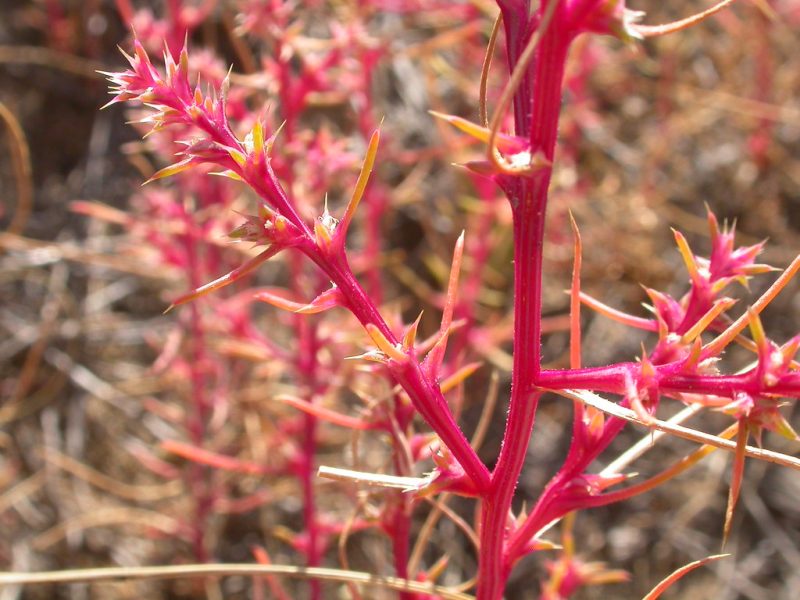
Russian Thistle (Salsola tragus), commonly known as tumbleweed, is a resilient annual plant that has become emblematic of the American West. Its sprawling stems can form dense mats or tumble across the landscape as they mature, making it a fascinating choice for creating a natural look in desert gardens. This plant is well-known for its ability to thrive in poor, sandy soils and its remarkable resistance to drought, making it an ideal addition to low-maintenance landscapes.
Despite its sometimes negative reputation as an invasive species, Russian Thistle can serve as a beneficial part of a sustainable landscape when managed correctly. It provides habitat for various insects and small animals, creating a niche for wildlife in arid environments. Additionally, the plant’s unique, spiky appearance adds an intriguing textural element to gardens when left to grow naturally.
In landscaping applications, Russian Thistle can be used as a filler plant or backdrop to more colorful flower species. Its ability to withstand harsh conditions allows it to prosper in difficult spots within the landscape, such as around pathways or rocky outcrops. For those looking to embrace a more naturalistic approach to desert gardening, incorporating Russian Thistle can add character and promote biodiversity while requiring minimal upkeep.
Dragon’s Blood Stonecrop

Dragon’s Blood Stonecrop (Sedum spurium) is an eye-catching succulent that captivates with its rich coloration and hardy nature. Characterized by its sprawling habit and small, star-shaped leaves that turn a vibrant red or deep burgundy in the summer sun, this succulent is not only beautiful but also highly resilient. In late spring, Dragon’s Blood Stonecrop bursts forth with clusters of tiny, pink flowers, adding a delightful pop of color to the landscape and attracting pollinators such as bees.
One of the key advantages of Dragon’s Blood Stonecrop is its remarkable ability to thrive in a range of soil types, particularly rocky or sandy substrates. It is particularly well-suited for xeriscaping because it requires minimal watering once established, making it an excellent choice for homeowners looking to conserve water.
When planning your desert landscape, consider using Dragon’s Blood Stonecrop as a ground cover plant or in combination with other succulents and drought-tolerant perennials. Its lush foliage creates a striking contrast against gravel pathways or wooden garden accents. Additionally, this stonecrop works beautifully in mixed succulent gardens, where its ground-hugging nature can complement taller plants while providing a soft, colorful carpet that enhances the overall aesthetic.
Brittlebush
Brittlebush (Encelia farinosa) is a beautifully hardy shrub native to the Sonoran Desert, known for its striking yellow flowers and unique, silver-gray foliage. This aromatic perennial typically grows to about 3 to 4 feet tall and produces bright, daisy-like flowers in late winter and early spring, creating a stunning visual impact against the backdrop of the desert landscape. The silvery leaves reflect sunlight, helping the plant to conserve moisture and thrive in hot conditions.
Brittlebush is particularly valued for its ability to flourish in both poor and sandy soils. It is drought-tolerant, requiring little water once established, making it fitting for a sustainable desert environment. In addition to its hardiness, Brittlebush is often used in traditional medicinal practices by indigenous peoples, enhancing its cultural significance.
When integrating Brittlebush into your landscaping, consider its potential as a focal point in garden beds, where it can attract butterflies and bees. It works well in mass plantings or as part of a native plant palette. Pairing Brittlebush with other desert-dwelling species, such as Agave or Red Yucca, can create a vibrant tapestry that enhances both visual appeal and ecological function.
Black Rose Aeonium
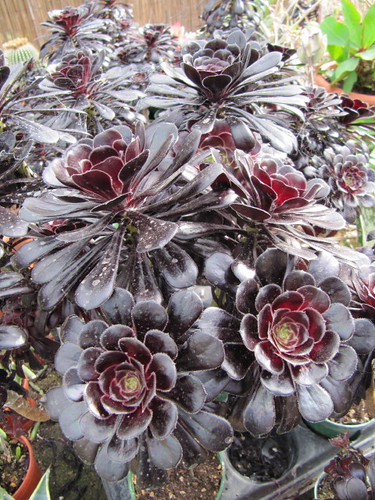
Black Rose Aeonium (Aeonium arboreum ‘Schwarzkopf’) is a stunning succulent that captivates with its deep, dark purple-black rosettes. This unique coloration makes it a standout in any landscape, especially when juxtaposed against lighter-colored stones or gravel. Its rosettes can grow up to 12 inches in diameter and rise on tall, slender stems, giving the plant an elegant, tree-like appearance.
Native to the Canary Islands, Black Rose Aeonium thrives in dry, sunny conditions, making it an excellent option for gardens in arid climates. It prefers well-drained soil and is quite drought-resistant once established, requiring minimal watering. The plant blossoms in the spring, producing tall spikes of yellow flowers that attract pollinators, adding seasonal interest to your landscape.
When designing with Black Rose Aeonium, consider its potential as a focal point within succulent gardens or mixed plantings. Its dramatic color can enhance the visual contrast among other succulents or drought-tolerant plants. Pairing it with lighter green or silver-hued plants, such as Lamb’s Ear or Aloe, can create a visually striking arrangement that draws the eye and enhances the overall aesthetics of your desert landscape.
Creosote Bush
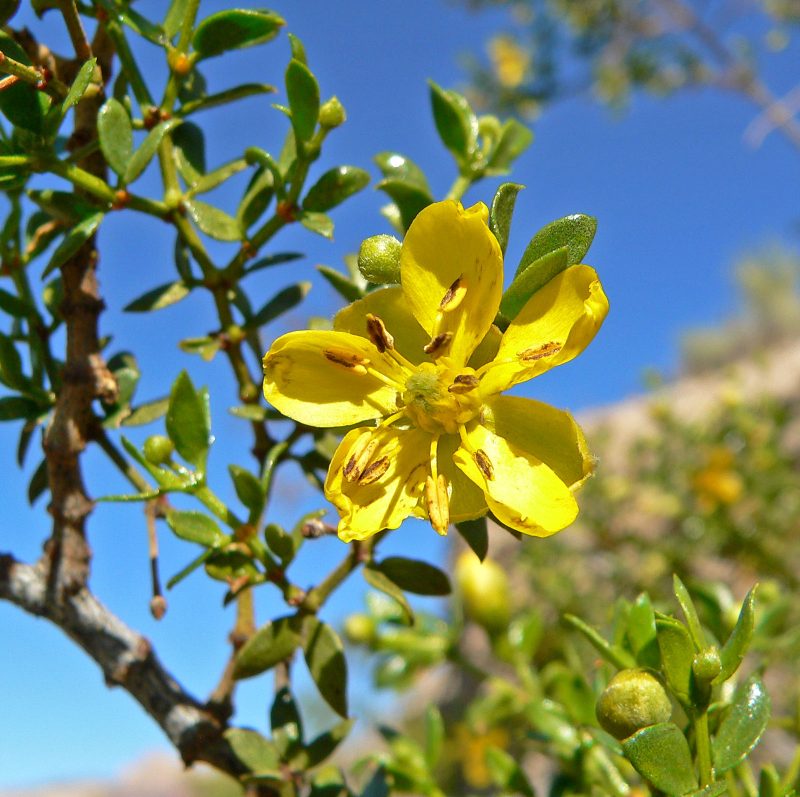
Creosote Bush (Larrea tridentata) is a quintessential symbol of the desert, known for its distinctive appearance and aromatic leaves. This hardy perennial shrub can reach heights of 3 to 10 feet, featuring small, waxy leaves that emit a strong, pleasant scent, particularly after rainfall. For many in the Southwestern United States, the smell of Creosote Bush, often described as “the smell of rain,” evokes a deep connection to the desert landscape.
Ecologically, Creosote Bush plays a crucial role in desert ecosystems, providing habitat for various insects and animals. Its deep root system allows it to access water from great depths, making it incredibly drought-resistant. This plant is also resistant to extreme temperatures, thriving in both blistering heat and cooler desert nights.
In landscaping, Creosote Bush is an excellent choice for xeriscaping, offering both beauty and functionality. Its sprawling form can act as a natural barrier or windbreak, aiding in soil conservation. Additionally, the lush foliage provides ground cover, which can help suppress weeds in arid gardens. Incorporating Creosote Bush into your landscape design not only adds depth and texture but also supports local wildlife and promotes environmental sustainability.
Joshua Tree
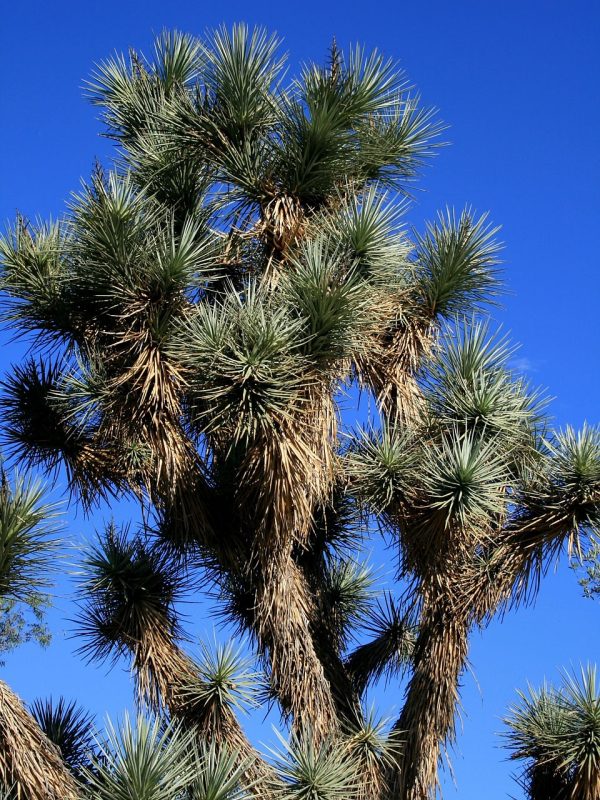
Joshua Tree (Yucca brevifolia) is arguably one of the most iconic plants of the American West, known for its unique silhouette and striking form. Resembling a draped palm or a towering agave, this member of the agave family can grow to impressive heights of up to 40 feet and can live for over a century. Joshua Trees produce long, white flower spikes that bloom in late winter to early spring, attracting a plethora of pollinators, including the yucca moth, which has a symbiotic relationship with the tree.
Native to the Mojave Desert, Joshua Trees thrive in rocky, well-drained soils and endure harsh drought conditions with ease. Their unique structure allows them to capture and store moisture, enabling them to withstand sudden temperature fluctuations in their native habitats. As a result, Joshua Trees are perfect for gardens designed to reflect the rugged beauty of the desert.
In landscaping, the Joshua Tree serves as a stunning focal point or landscape centerpiece, making a bold statement in any garden design. When planted in clusters, it creates a dramatic and visually captivating effect, reminiscent of the natural desert landscape. Consider surrounding Joshua Trees with boulders, native wildflowers, or low-growing succulents to create layers and variation, mimicking the natural habitats found in the wild.
Felt Bush
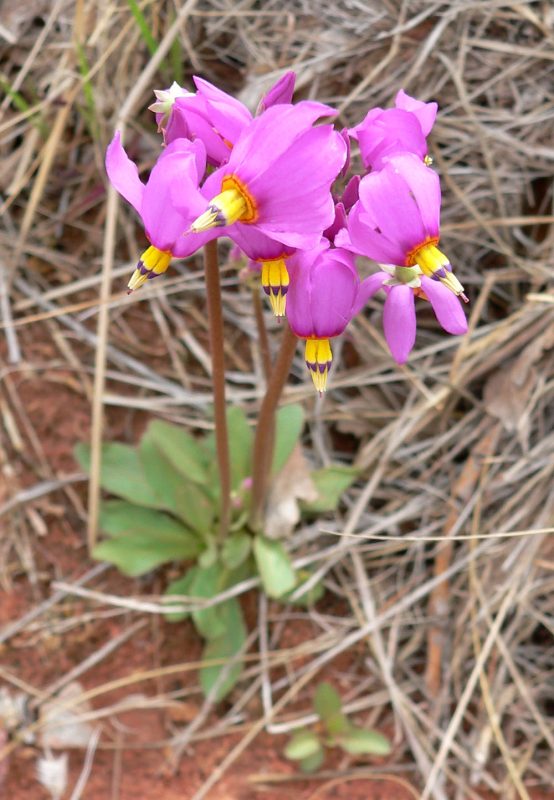
Felt Bush (Dodecatheon pulchellum) is a fascinating shrub native to the deserts of the southwestern United States, characterized by its soft, fuzzy foliage that gives it a distinctive appearance. Its gray-green leaves are covered in fine hairs, which help minimize water loss in the intense heat of the desert, making it exceptionally drought-tolerant. The Felt Bush typically blooms in spring, showcasing clusters of delicate, yellow tubular flowers that can also have orange or pink undertones. These striking blooms are not only eye-catching but also attract various pollinators, including bees and butterflies.
This adaptable shrub can thrive in a range of soil types, but it favors well-draining, sandy soils, and can endure poor nutrient conditions. One of its remarkable features is its ability to recover quickly after being stressed by drought or heat, making it an invaluable asset for low-maintenance landscaping.
In terms of landscaping design, Felt Bush can be utilized as a hedge, border plant, or accent piece in rock gardens. Its unique texture serves as a perfect backdrop for other flowering plants, contributing a soft, muted color palette that enhances the overall composition. Additionally, when planted alongside other native plants, Felt Bush can create a harmonious ecosystem that promotes biodiversity while minimizing the need for irrigation.
California Poppy
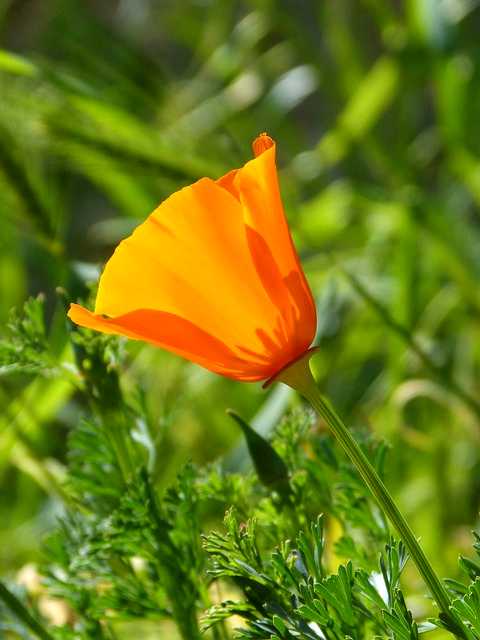
California Poppy (Eschscholzia californica) is not only a quintessential symbol of the golden state but also a stunning addition to desert home landscaping. Known for its vibrant orange blooms that can brighten any garden, this perennial wildflower is perfectly adapted to thrive in hot, dry conditions. California Poppies prefer poor, well-draining soils and are highly drought-resistant once established, making them an excellent choice for low-water gardens.
Blooming from early spring to late summer, California Poppies display cup-shaped flowers that open in the morning and close at night, creating a dynamic visual experience in the garden. The plant’s slightly fern-like leaves provide additional texture and movement, especially in a breeze, which adds to its charm.
Incorporating California Poppy into your landscape can greatly enhance the beauty and ecological richness of your garden. They can be planted in mass for a stunning burst of color or intermixed with other native wildflowers for a natural, meadow-like effect. Additionally, their attraction to pollinators makes them a great choice for creating viable habitat spaces for beneficial insects and other wildlife. With little care required beyond occasional watering during prolonged dry spells, California Poppies are an effortless way to bring vibrant color into arid landscapes.
Red Pancake
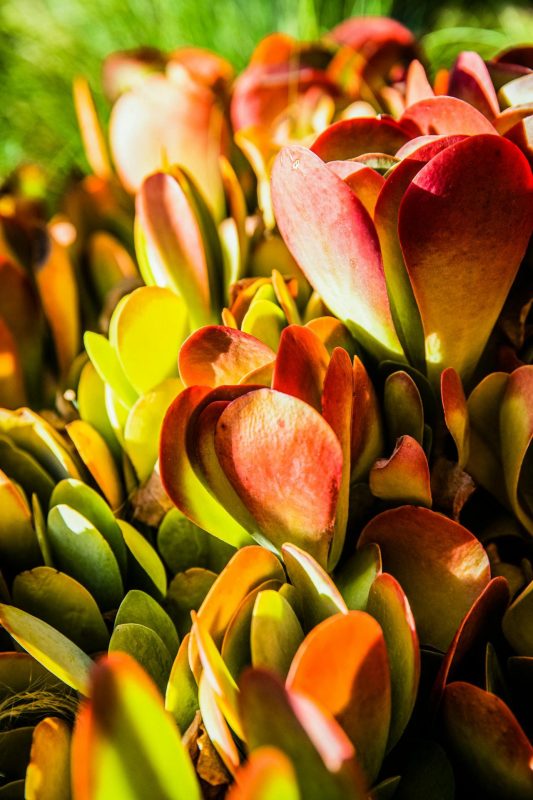
Red Pancake , is an intriguing succulent that stands out due to its unique, disc-shaped leaves and vibrant red flowers. This striking plant typically reaches 1 to 2 feet in height and can thrive in both sandy and rocky soils, making it well-suited for desert landscaping. The leaves of Red Pancake grow low to the ground, forming a rosette that can spread out and create a stunning visual focal point in any garden.
The most captivating feature of Red Pancake is its vibrant, trumpet-shaped blooms that emerge atop tall stalks in late spring, turning heads with their unusual yet appealing shape. The flowers are not only visually stunning but are also known to attract a variety of pollinators, such as butterflies and hummingbirds, adding a dynamic element to your landscape.
In terms of landscaping design, Red Pancake can serve as an outstanding container plant or as part of a mixed border in rock gardens. Its unique form creates an eye-catching contrast when paired with traditional desert plants, such as agaves or other succulents. Furthermore, its low water requirements ensure that it will thrive alongside other drought-tolerant plants, helping to maintain a cohesive water-wise garden aesthetic.
Fox Tail Agave
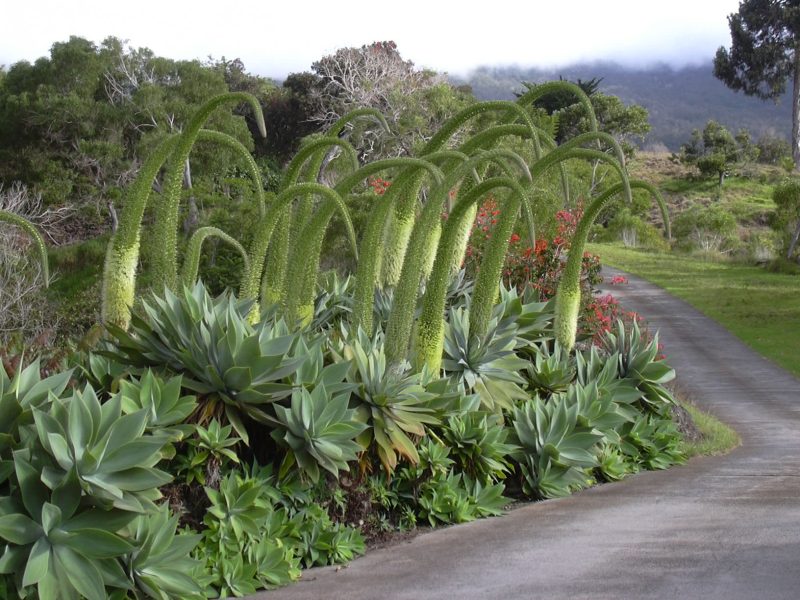
Fox Tail Agave (Agave attenuata) is a visually stunning succulent known for its sculptural form and lush, green, arching leaves that can grow up to 5 feet long. This agave species distinguishes itself with its soft, spineless leaves, creating a more user-friendly alternative to other spiny agaves. The rosette form boasts a graceful elegance, making Fox Tail Agave an excellent focal point in any garden design.
What truly sets this plant apart is its unique flowering behavior. Fox Tail Agave can take several years to reach maturity, after which it produces a remarkable flower stalk that can reach heights of up to 10 feet. The stalk emerges in a dramatic display, bearing clusters of tubular yellow-green flowers that attract hummingbirds and other pollinators during their blooming period. This striking display provides an element of surprise and excitement to the landscape, marking an important lifecycle event within the garden.
In landscaping, Fox Tail Agave can thrive in a variety of soil conditions, although it prefers well-draining substrates, making it a perfect candidate for rocky or sandy gardens. This plant’s drought tolerance allows it to flourish with minimal watering once established, and it can be beautifully paired with other succulents or rustic elements, such as stone walls and gravel pathways, creating a serene desert oasis. Its architectural form makes it ideal for both contemporary and traditional landscapes, allowing for endless design possibilities.
Winecup
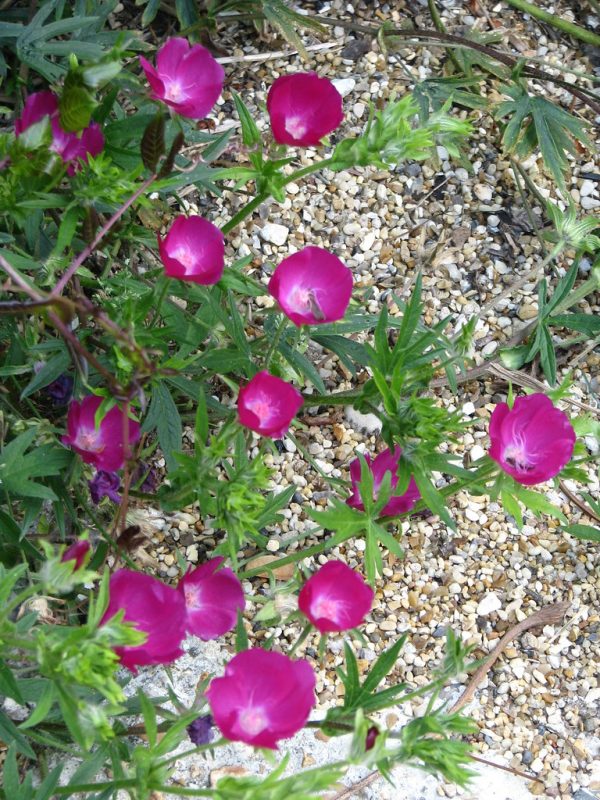
Winecup (Callirhoe involucrata), named for its cup-shaped, magenta blooms, is a delightful perennial native to the prairies and open woodlands of the southwestern United States. With its sprawling habit and delicate flowers, Winecup can add vibrant color to your desert landscape from spring to summer. The blossoms open in the sunlight, inviting bees and other pollinators, and can create a breathtaking display that visually captivates anyone visiting your garden.
This adaptable plant can thrive in a variety of soil types, performing best in well-drained, sandy, or gravelly mixtures. Winecup is drought-tolerant, making it an excellent choice for xeriscaping, while also bringing a splash of vivid color to arid regions. Once established, it requires very little maintenance, allowing gardeners to enjoy its whimsical floral displays without extensive care.
In terms of landscaping design, Winecup can be used as a ground cover or in mass plantings to create a stunning floral carpet that contrasts beautifully with the greens and browns of other desert plants. For added visual interest, consider planting Winecup around rocky outcrops or alongside larger succulents to enhance its free-spirited nature. This plant thrives in full sun and can tolerate occasional foot traffic, making it a great choice for informal pathways in a desert garden while encouraging a sense of natural beauty.
Lantana
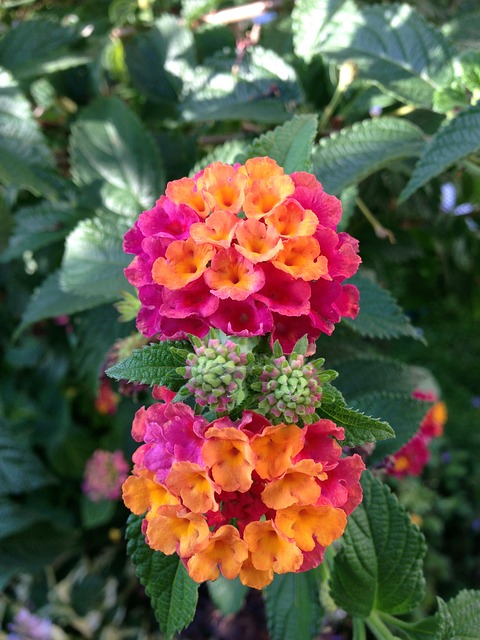
Lantana (Lantana camara) is a hardy, sun-loving shrub known for its colorful clusters of flowers that bloom continuously throughout the growing season. With a diverse palette of colors ranging from yellows and oranges to purples and pinks, Lantana can bring vibrant life to desert landscapes. Not only is it visually appealing, but it also attracts butterflies and other beneficial pollinators, enhancing the biodiversity of your garden.
This resilient plant thrives in hot, dry conditions and is tolerant of poor soil, making it an excellent choice for low-water gardening. Its drought resistance allows Lantana to flourish even in arid months, providing continuous color even when other plants may be struggling. The foliage is also fragrant and can provide a lovely aromatic backdrop to your garden.
In landscaping applications, Lantana can be utilized as a border plant, ground cover, or in mixed perennial beds, where its spreading nature can help fill in gaps and suppress weed growth. This versatility allows gardeners to integrate Lantana into a variety of landscape designs, from more polished, manicured spaces to wildflower gardens. Additionally, due to its ability to withstand drought and heat, it makes an excellent choice for patios, terraces, or other outdoor living areas where color is desired without extensive irrigation.
Whitestem Paperflower
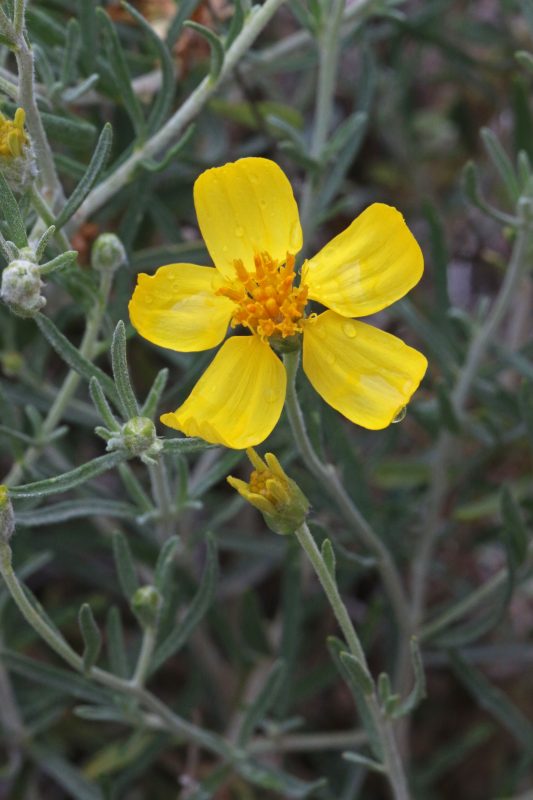
Whitestem Paperflower (Psilocarpus tenuis) is a perennial plant celebrated for its striking display of bright, papery flowers and slender, upright stems that can reach heights of 1 to 2 feet. This native desert plant thrives in sunny, arid environments and adapts well to well-drained soils, making it an excellent choice for rock gardens and xeriscapes. The Whitestem Paperflower flowers primarily in late spring and early summer, producing clusters of long-lasting blooms that stand out in stark contrast against the backdrop of its slender green foliage.
One of the plant’s most notable features is its ability to tolerate prolonged drought conditions once established, making it an ideal candidate for low-maintenance landscaping. The flowers not only attract pollinators such as beetles and butterflies, enriching the biodiversity of your garden, but they also create a beautiful tapestry of color that can brighten up any landscape.
In terms of landscaping design, Whitestem Paperflower can be ideal for use in mass plantings or as individual accents in a desert garden. Pairing it with other flowering natives can create a vibrant, cascading effect, while its delicate structure can lend an air of softness to more robust ornamental plants. Given its adaptability to different soil conditions and its drought resistance, Whitestem Paperflower is an exceptional choice for homeowners looking to create a sustainable and visually appealing outdoor space.
Hen and Chicks
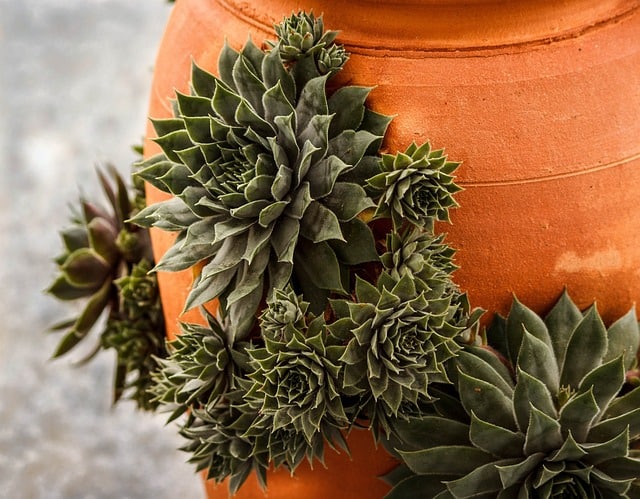
Hen and Chicks (Sempervivum tectorum) is a beloved succulent known for its charming rosettes and ease of care. This hardy perennial is particularly well-suited for desert landscaping due to its drought tolerance and ability to thrive in poor soil conditions. Hen and Chicks derive their name from the way they produce offsets, or “chicks,” around the mother plant, creating dense clusters that can spread beautifully across a garden space.
This plant features rosettes that can range in color from deep green to vibrant hues of purple and red, depending on the sunlight exposure and specific varieties. The ability of Hen and Chicks to adapt and change colors throughout the seasons makes them a dynamic addition to any landscape. When in bloom, the plants send up tall flower stalks adorned with star-shaped flowers, adding an additional layer of interest.
In terms of landscaping use, Hen and Chicks are perfect for rock gardens, container arrangements, or even as ground cover in areas that receive full sun. Their compact size and unique growth habit allow them to fit neatly into small spaces, whether nestled between stones in a pathway or cascading over the edges of pots. Given their attractive appearance and minimal water needs, Hen and Chicks can encourage sustainable gardening practices by reducing the need for irrigation while bringing both texture and color to your desert landscape.
Blazing Star
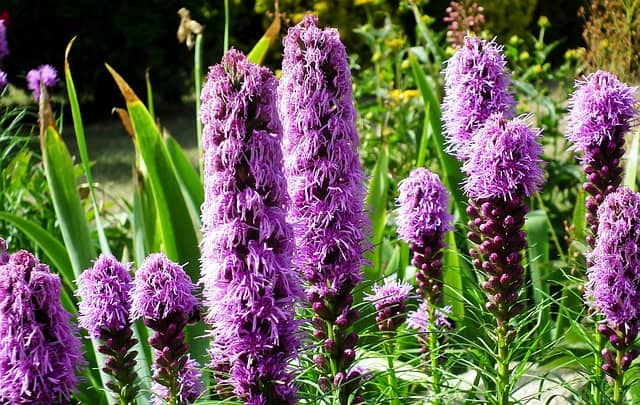
Blazing Star (Liatris spp.), also known as Gayfeather, is an enchanting perennial that truly embodies the spirit of the wildflower. It is distinguished by its tall spikes lined with dense clusters of purple flowers, which bloom from the top downward, creating a dramatic and eye-catching effect in any garden. Blazing Star thrives in well-drained, sandy soil and can withstand the harsh conditions typical of desert climates, making it an ideal choice for arid home landscapes.
Beyond its stunning visual appeal, Blazing Star is commonly appreciated for its role in supporting local ecosystems. The flowers are beloved by pollinators, including bees and butterflies, providing an essential food source during peak bloom periods in late summer to fall. Its ability to attract these beneficial insects will not only enrich your garden’s biodiversity but also help foster a healthy environment for them to thrive.
In terms of landscaping applications, Blazing Star works beautifully in mixed perennial borders, wildflower gardens, or as a standout specimen plant. When planted in groups, the tall spikes can create a striking vertical element, adding layers of height and drama to your garden design. Additionally, their ability to thrive in dry conditions and poor soils makes them an excellent candidate for sustainable landscaping, requiring little maintenance once established.
Rattleweed
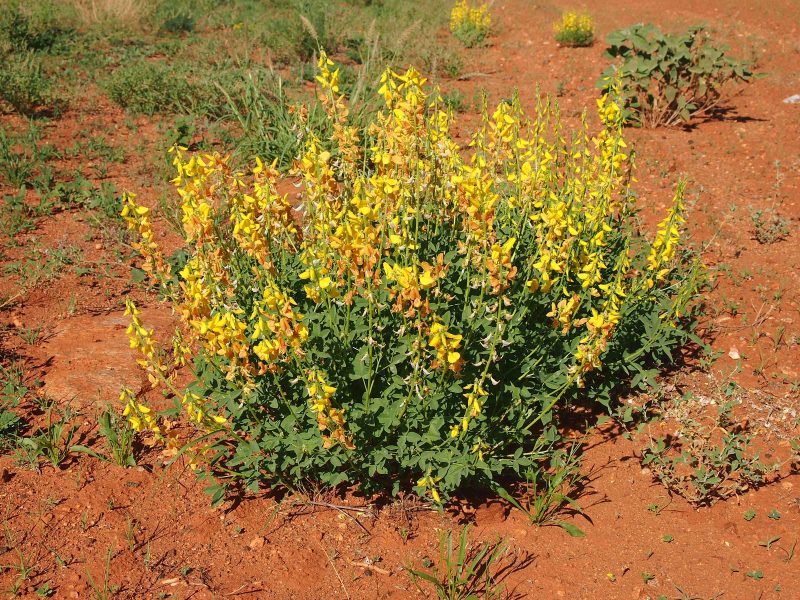
Rattleweed (Crotalaria spp.) is a lesser-known but fascinating plant distinguished by its unique seed pods that rattle when shaken—hence the name. This hardy legume thrives in desert conditions and is highly adaptable, often colonizing disturbed areas with ease. The plant typically produces yellow or cream-colored flowers that bloom in the spring and summer, attracting a variety of pollinators, such as bees and butterflies, which are essential for maintaining ecological health in your garden.
One of the standout features of Rattleweed is its nitrogen-fixing ability. This means that it can improve soil fertility by converting atmospheric nitrogen into a form that is usable by plants. This characteristic can be particularly beneficial in arid landscapes, where soil quality may be poor. By incorporating Rattleweed into your garden, you are not only adding beauty but also enhancing the overall health of the soil, which can positively affect surrounding plant life.
Rattleweed’s drought tolerance makes it a practical choice for low-maintenance landscaping, as it requires minimal watering once established. Its naturalized appearance allows it to blend well into a more wild, organic garden setting. Rattleweed can be planted in clusters along borders or in mixed beds, where its vibrant flowers can provide pops of color throughout the growing season. By choosing Rattleweed, you contribute to a sustainable landscape that benefits both the plants around it and the pollinators that visit.
Bristly Langloisia
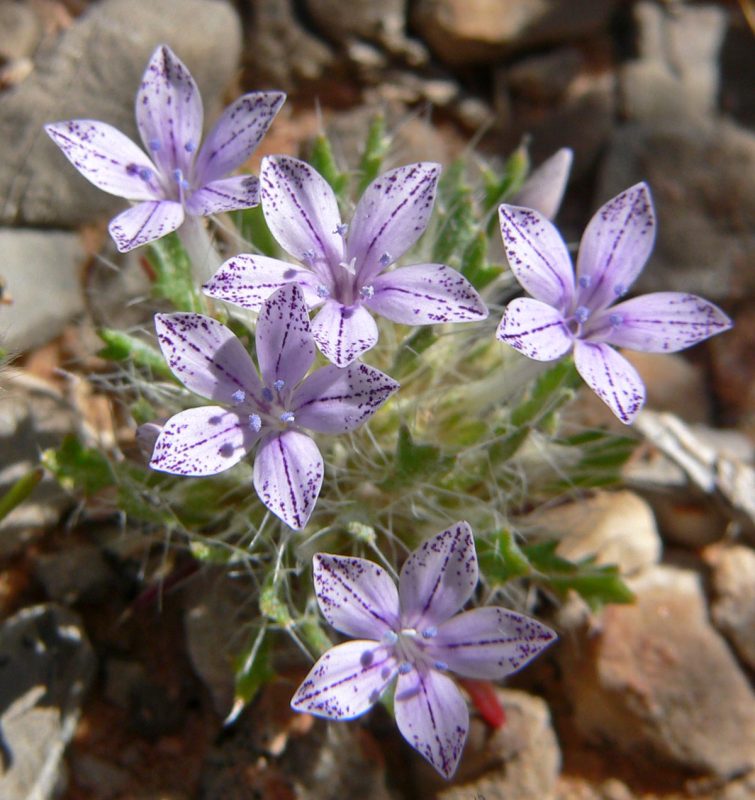
Bristly Langloisia (Langloisia setosissima) is an extraordinary annual wildflower that thrives in the deserts of the southwestern United States. Known for its distinctive, bright yellow flowers surrounded by soft bristles, this charming plant can bring a delightful touch of color to any arid landscape. Bristly Langloisia blooms in early spring, typically between March and May, creating a stunning display that attracts a variety of pollinators, including bees, butterflies, and hummingbirds.
This plant is particularly well-suited for sandy or rocky soils, where it can establish quickly and thrive with minimal water. As a drought-tolerant species, Bristly Langloisia can flourish under challenging conditions, making it an excellent addition to low-water gardens. Its preference for full sun ensures that it will be both resilient and vibrant, contributing to the visual splendor of your landscape.
In landscaping design, Bristly Langloisia can work well in mass plantings, providing a vibrant carpet of yellow across the desert floor. Alternatively, it can be planted alongside other wildflowers or desert perennials for a delightful naturalized meadow effect. This plant is also a fantastic option for those looking to attract wildlife, adding ecological value to your garden while creating a vibrant and colorful display that can transform a barren landscape into a lively ecosystem.
Tumbleweed
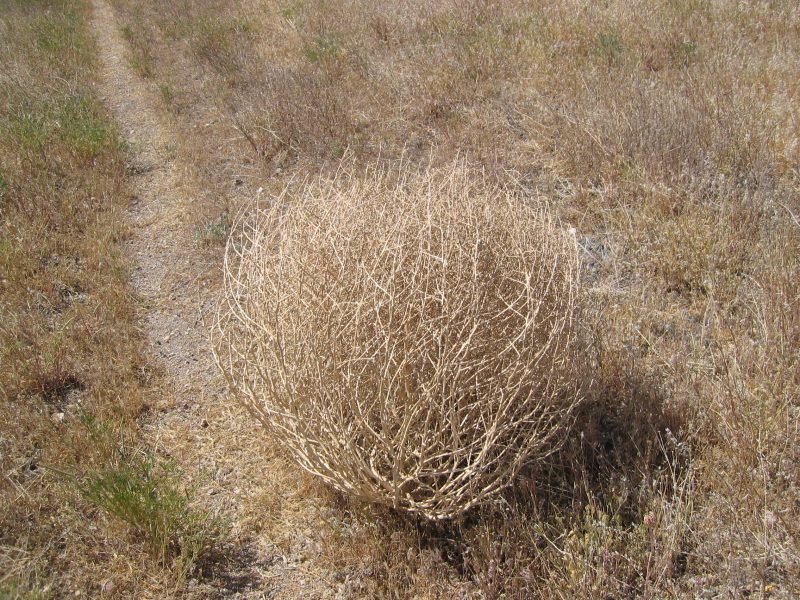
Tumbleweed (Salsola spp.), a well-known symbol of the American West, is recognizable for its round, rolling shape that makes it synonymous with open landscapes and prairie life. While commonly perceived as a nuisance, tumbleweed can also play a unique role in desert gardens. The plant typically produces attractive green foliage that changes to a reddish hue as it matures, adding seasonal interest to your landscape.
Tumbleweed thrives in dry, nutrient-poor soils, making it exceptionally suited to arid environments. One of the intriguing aspects of tumbleweed is its unique life cycle. The plant completes its growth cycle within a single season, dying back and breaking away from its root system when dry, which allows it to roll across the landscape, carrying seeds that can germinate in new locations. This adaptability enables it to colonize vast areas and thrive in challenging climates.
In terms of landscaping potential, tumbleweed can contribute a rugged and naturalistic aesthetic to your garden. It can be strategically placed near pathways, in gravel beds, or around boulders, where its distinct shape and texture can create visual interest and serve as a conversation starter. Incorporating tumbleweed into your garden not only embraces the unique charm of desert flora but also demonstrates an appreciation for plants that are perfectly adapted to their environments and serve a larger ecological role.
Desert Marigold
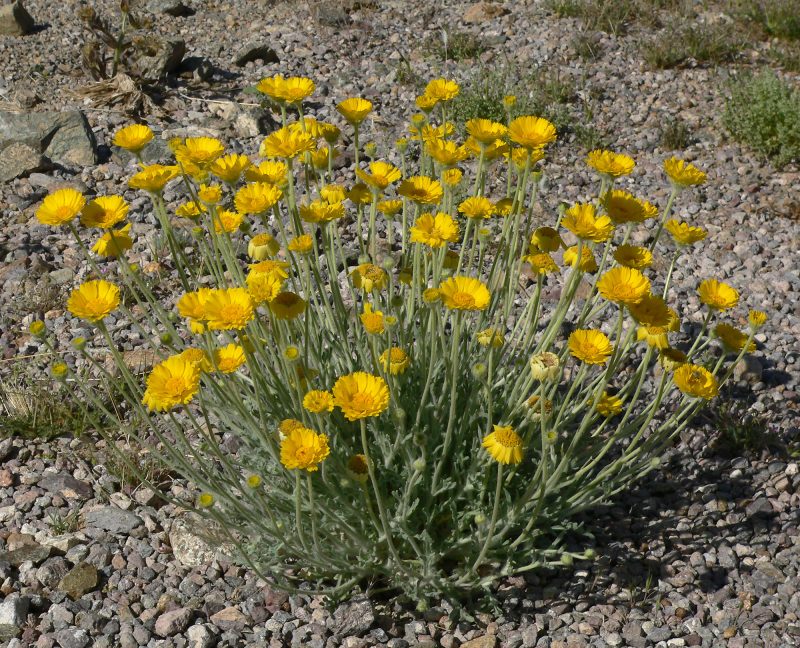
Desert Marigold (Baileya multiradiata) is a perennial wildflower renowned for its vibrant yellow blooms that burst forth throughout much of the warm season, particularly in spring and early summer. This cheerful plant can reach heights of 1 to 3 feet and features gray-green foliage that beautifully complements its bright flowers. The blooms attract various pollinators, including bees and butterflies, playing an essential role in supporting local ecosystems.
Desert Marigold is exceptionally suited to the harsh conditions of the desert, thriving in well-drained soils with low moisture. Its drought resistance makes it a perfect candidate for xeriscaping, providing continuous color with minimal water requirements. One of the remarkable traits of Desert Marigold is its ability to flower profusely in dry conditions, creating a spectacular display even when other plants may struggle.
In landscaping applications, Desert Marigold works wonderfully in mass plantings, where clusters of bright yellow blossoms can create a striking visual impact. Additionally, it can be interspersed among other drought-tolerant plants or in rock gardens to enhance the overall color palette. Because of its manageable size and long blooming period, this plant is an excellent choice for residential landscapes, offering both beauty and ecological benefits while embodying the sunny spirit of the desert.
Rainbow Bitterroot
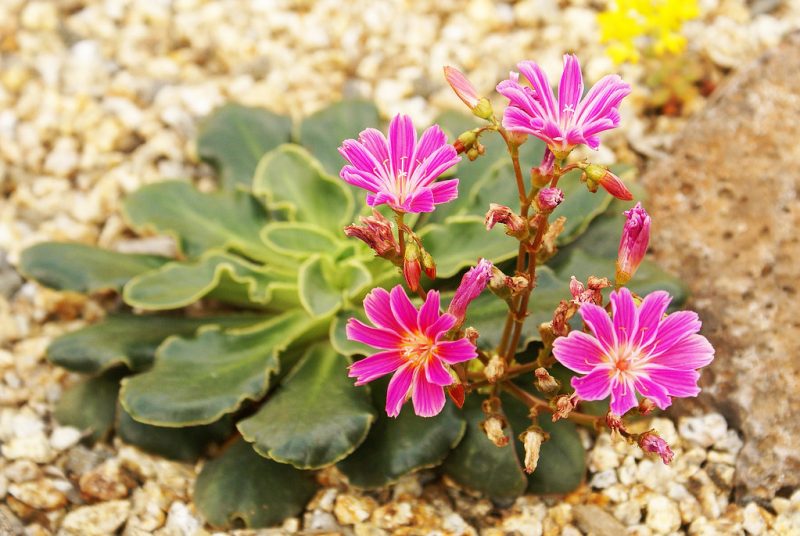
Rainbow Bitterroot (Lewisia cotyledon) is a perennial treasure native to the mountainous regions of the American West. Known for its breathtaking rosettes of succulent leaves and striking flowers, Rainbow Bitterroot thrives in rocky, well-drained soils, making it an ideal candidate for desert landscaping. The plant features clusters of delicate, star-shaped flowers in an array of colors, including pink, white, and yellow, that unfurl in the spring and early summer, bringing vibrancy to your garden as it awakens from winter dormancy.
Beyond its aesthetic appeal, Rainbow Bitterroot is remarkably resilient and drought-tolerant, requiring minimal maintenance once established. Its ability to thrive in harsh conditions makes it perfect for rocky outcrops or areas that receive full sun exposure. The succulent leaves are not only attractive but also provide a critical moisture store, allowing the plant to endure prolonged dry spells effectively.
When incorporating Rainbow Bitterroot into your landscaping, consider using it in crevice gardens, rock walls, or border plantings. Its unique growth habit allows it to cascade over the edges and create visually appealing layers in your landscape. This plant’s compact size, lovely blooms, and adaptability make it a perfect choice for homeowners looking to add depth and color to their arid gardens while promoting sustainability.
Desert Lily
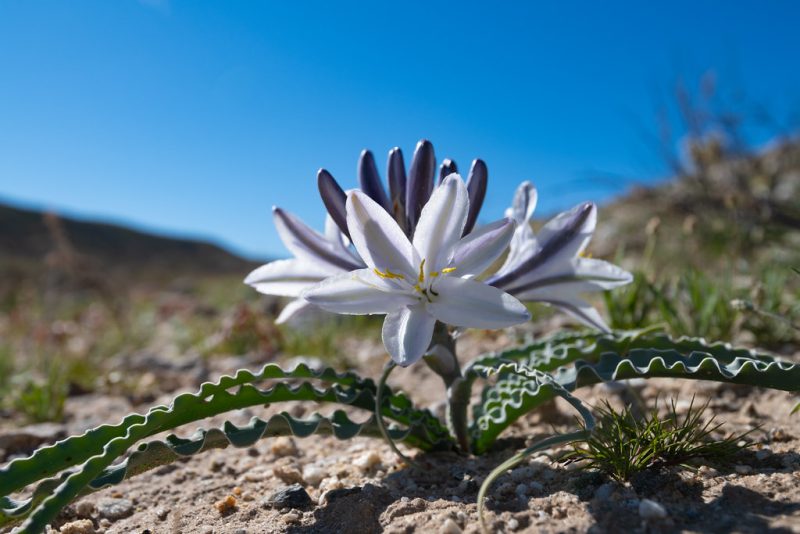
Desert Lily (Hesperocallis undulata) is a truly iconic plant of the American Southwest, characterized by its tall, arching leaves and elegant white flowers that bloom in the early summer months. The large, trumpet-shaped blossoms are often tinged with subtle purple accents, creating a striking display against the desert backdrop. This native lily can grow up to 3 feet tall and is known for its ability to thrive in the challenging conditions of desert environments, such as sandy soils and high temperatures.
One of the most intriguing aspects of the Desert Lily is its unique growth pattern. This perennial plant typically remains dormant during the dry months, emerging dramatically with lush foliage and spectacular flowers after the seasonal rains. The blooms attract various pollinators, including bees, moths, and hummingbirds, making the Desert Lily a beneficial addition to any garden ecosystem.
In landscaping, Desert Lily can serve multiple roles, whether as a focal point in a garden bed or as part of a mixed perennial border. Since it requires minimal water and thrives in dry conditions, this plant is an excellent choice for low-water gardens. Its elegant form and stunning blooms can create a captivating visual impact, elevating the overall aesthetics of your desert landscape. Additionally, the Desert Lily’s ability to thrive in challenging environments makes it an ideal choice for sustainable gardening, where low maintenance and ecological health are a priority.
Cape Aloe
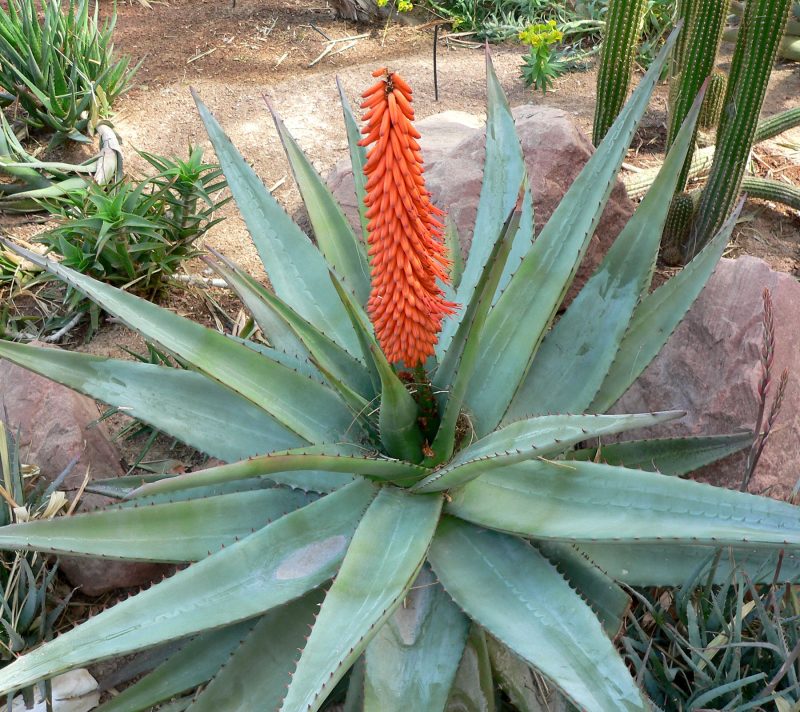
Cape Aloe (Aloe ferox) is a striking succulent that originates from the dry regions of South Africa but thrives exceptionally well in desert landscapes any place that receives plenty of sunlight. Renowned for its rosettes of thick, fleshy leaves, Cape Aloe can grow up to several feet tall, forming a dramatic focal point in any outdoor setting. The serrated edges of its leaves showcase a vibrant green hue that can take on a reddish tint in harsh sunlight, adding a dynamic element to your garden.
One of the most eye-catching features of Cape Aloe is its stunning inflorescence, which rises above the foliage like a graceful torch. In late winter to early spring, tall stalks adorned with tubular, orange-red flowers bloom, attracting pollinators such as bees and hummingbirds. This seasonal display provides not only a beautiful contrast to the lush green leaves but also a critical nectar source for wildlife.
In terms of landscaping, Cape Aloe is well-suited for xeriscaping—requiring minimal irrigation once established. It prefers well-drained soil and can withstand drought conditions, making it an excellent choice for low-maintenance landscapes. Cape Aloe pairs beautifully with other succulents and drought-tolerant plants, enhancing your garden’s desert-themed aesthetic. Additionally, this plant has been celebrated for its medicinal properties, historically used for healing purposes, adding an element of botanical intrigue to your garden as well.
Moss Rose
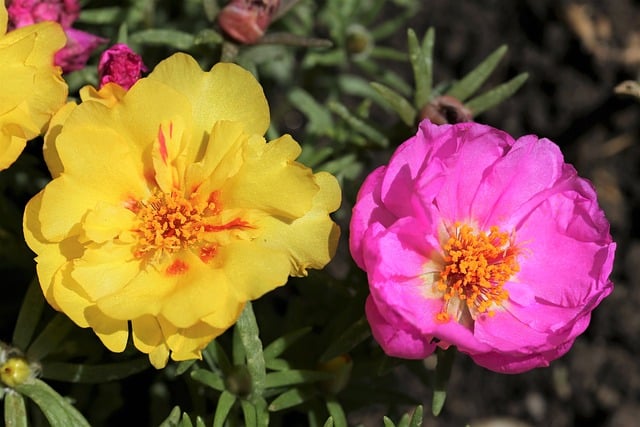
Moss Rose (Portulaca grandiflora), also known as Purslane or Rose Moss, is a vibrant annual succulent that can bring a splash of color to your desert landscape. This hardy plant features rosettes of fleshy, oval leaves that cascade softly over the ground, creating a lush, carpet-like appearance. Its flowers bloom in a variety of hues—ranging from bold yellows and pinks to striking reds and whites—making Moss Rose an excellent choice for adding immediate visual appeal.
One of the distinguishing factors of Moss Rose is its remarkable tolerance to dry and hot conditions. This low-growing plant thrives in full sun and well-drained soil, flourishing in environments where other flowers may struggle. Its succulent leaves allow it to retain water efficiently, which means Moss Rose will continue to bloom even during prolonged dry spells, providing consistent color throughout the growing season.
When considering landscaping options, Moss Rose is perfect for ground cover or as filler in hanging baskets and containers. The vibrant flowers can also create a stunning contrast when planted alongside larger, more rigid succulents or cacti. Its sprawling nature makes it ideal for cascading over the edges of raised beds, enhancing the overall aesthetic of your garden while promoting a low-maintenance approach to landscaping. The ability of Moss Rose to self-seed makes it a resilient choice for ongoing beauty without the need for regular replanting.
Ocotillo
Ocotillo (Fouquieria splendens) is a striking, architectural plant native to the deserts of the American Southwest and Mexico. This unique succulent, characterized by its long, whip-like stems, can reach heights of up to 20 feet, forming a dramatic, vertical accent in your landscape. Although it has a somewhat barren appearance for much of the year, with its spiny branches stark against the sky, Ocotillo bursts to life in the spring with vibrant clusters of tubular, red-orange flowers that can attract various hummingbirds and pollinators.
Adapted to arid conditions, Ocotillo is a drought-tolerant plant that can survive long periods without water. It has a fascinating ability to respond to rainfall—growing new leaves and flowers shortly after precipitation, only to shed them during extended dry spells, thus conserving resources. This adaptability makes Ocotillo a perfect candidate for desert gardens, offering a dramatic seasonal display while requiring minimal maintenance.
In landscaping design, Ocotillo can serve as a stunning focal point, particularly when planted in groups or near boulders to enhance its natural appeal. It can work well as part of a xeriscape garden, where its unique structure contrasts beautifully with other desert plants such as cacti and smaller succulents. Additionally, Ocotillo can be used as a barrier plant due to its thorny stems, providing both beauty and function in your landscape. Embracing Ocotillo in your home landscaping allows you to showcase a truly iconic desert plant that embodies the essence of arid climates.
Yellow Palo Verde
Yellow Palo Verde is a quintessential desert tree that is known for its striking green bark and brilliant yellow flowers. This tree can reach heights of 15 to 30 feet, making it an impressive centerpiece in any landscape design. The name “Palo Verde” translates to “green stick” in Spanish, a fitting description of its remarkable bark, which plays a crucial role in photosynthesis during the dry season when the leaves are shed. The bright yellow blossoms typically appear in late spring, creating a stunning contrast against the green foliage and providing a vivid burst of color that attracts bees and hummingbirds.
This tree is exceptionally well-adapted to arid environments, thriving in poor soil conditions with minimal water once established. The Yellow Palo Verde is notable for its drought tolerance, as it can survive without irrigation while still displaying beautiful blooms. Furthermore, its deep root system enables it to tap into underground moisture sources, making it a resilient choice for desert landscaping.
In landscaping, the Yellow Palo Verde serves multiple purposes. Its stunning appearance makes it an excellent shade tree for patios and gathering areas, while its ability to attract pollinators promotes biodiversity in your garden. Its attractive form can be complemented by lower-growing desert plants or ornamental grasses, creating a layered and dynamic landscape. Incorporating a Yellow Palo Verde into your home landscaping not only enhances visual interest but also supports local wildlife and contributes to a sustainable ecosystem.
Mojave Aster
Mojave Aster (Xylorhiza tortifolia) is a delightful perennial wildflower commonly found in the Mojave Desert. With its distinct twisty leaves and vibrant purple flowers, this plant adds a burst of charm to any desert landscape. The blooms typically appear from late spring to early summer and can provide striking color to otherwise arid surroundings. Approximately 1 to 2 feet tall, the Mojave Aster often forms compact clusters that create a lovely display when massed together.
One of the appealing aspects of Mojave Aster is its adaptability to a variety of soil types, including sandy and rocky substrates, making it a versatile choice for garden design. The aster’s drought-tolerant nature ensures that it can thrive with minimal irrigation, making it an excellent choice for water-conscious gardeners. Additionally, this plant is beneficial for supporting pollinators, attracting bees and butterflies that rely on its nectar.
In landscaping, Mojave Aster can be used in mixed perennial borders, rock gardens, or as ground cover. It pairs beautifully with other desert plants, such as succulents and cacti, creating a vivid tapestry of color and texture. Given its relatively low maintenance requirements and hardiness, the Mojave Aster is an ideal option for both novice and experienced gardeners seeking to enhance the aesthetic appeal of their outdoor spaces while promoting ecological health.
Pink Fairy Duster

Pink Fairy Duster (Calliandra eriophylla) is a small, bushy shrub that enchants with its fluffy pink pom-pom flowers and delicate fern-like foliage. Typically reaching heights of 3 to 4 feet, this charming plant is highly adaptable and thrives in well-drained soils under the blazing sun. The Pink Fairy Duster usually blooms from spring through summer, showcasing its eye-catching blossoms that attract hummingbirds, butterflies, and other pollinators to your garden.
Characterized by its remarkable drought tolerance, the Pink Fairy Duster is well-suited for desert landscaping, requiring minimal water once established. Its ability to withstand extreme heat makes it a resilient option for xeriscaping and low-water use gardens. Additionally, this versatile plant is often praised for its ability to thrive in poor soil conditions, allowing it to flourish in areas where other plants may find it challenging.
In terms of landscaping potential, the Pink Fairy Duster can be used as a border plant, in foundation plantings, or as a focal point in mixed beds. Its graceful form and colorful blooms bring dynamic visual interest to any garden, while its low maintenance needs make it appealing for busy homeowners. When planted in clusters, the Pink Fairy Duster creates a captivating display that elevates the overall aesthetic of your landscaping project. By integrating this enchanting shrub, you not only enhance the beauty of your outdoor space but also contribute positively to the local ecosystem through the support of beneficial wildlife.
Texas Sage
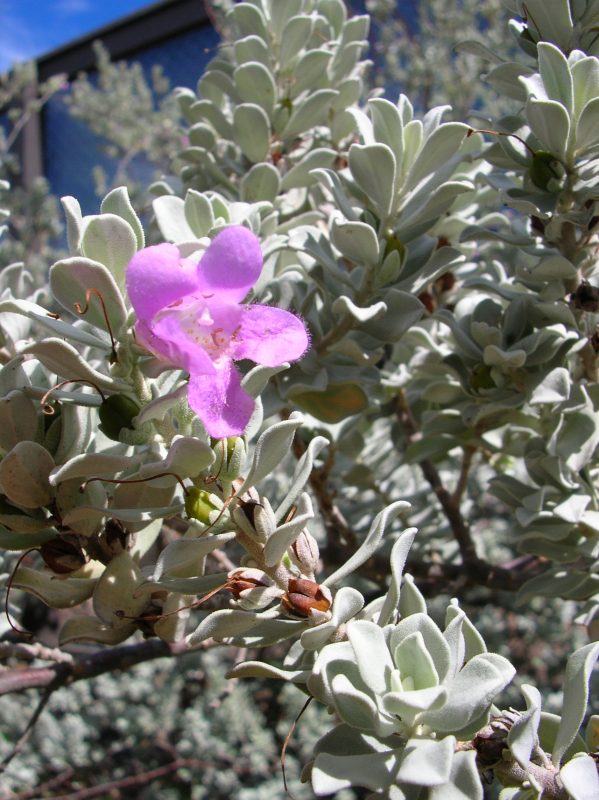
Texas Sage (Leucophyllum frutescens), also known as barometer bush, is a popular evergreen shrub celebrated for its resilience and stunning lavender flowers. This shrub reaches heights of 3 to 5 feet and exhibits soft, gray-green leaves that shimmer in the sunlight, providing a unique contrast in landscaping designs. One of the most remarkable features of Texas Sage is its ability to bloom profusely after rainfall, making it not only a lovely visual element but also a functional indicator of moisture changes in the environment.
Texas Sage thrives in full sun and requires minimal water once established, showcasing excellent drought tolerance. It adapts well to various soil types, including rocky and sandy substrates. This makes it an ideal candidate for xeriscape landscaping, where low water usage is a priority. Its attractive flowers, which typically bloom in late spring and summer, attract a variety of pollinators, including bees and butterflies, enhancing biodiversity in your garden.
When integrating Texas Sage into your landscaping, consider using it as a hedge or foundation plant for a natural privacy screen. Its compact form and colorful blooms can also serve as a backdrop for other flowering plants, creating a layered landscape. Texas Sage’s hardy nature and beautiful floral display make it a longstanding favorite among homeowners seeking to enrich their outdoor spaces with low-maintenance yet stunning foliage.
Perennial Verbena

Perennial Verbena (Verbena bonariensis) is a stunning addition to any desert garden, renowned for its long-lasting blooms and unique growth habit. This perennial plant typically grows between 2 to 4 feet tall, featuring slender, upright stems adorned with clusters of small, vibrant purple flowers. Blooming from late spring through fall, Perennial Verbena draws in a vast array of butterflies and bees, making it a wonderful choice for environmentally conscious gardeners looking to attract pollinators.
One of the key advantages of Perennial Verbena is its adaptability to various environments. While it thrives in full sun and well-drained soils, it can tolerate drought conditions once established. This resilience makes it a perfect fit for water-conserving landscapes. The plant’s airy structure allows it to withstand strong winds, making Perennial Verbena an excellent option for gardens in exposed locations.
In landscape design, Perennial Verbena can create a striking visual impact when used in mass plantings, where its height and color can provide a stunning contrast to shorter groundcovers or succulents. Additionally, its loose growth habit allows for a relaxed, informal feel, making it perfect for cottage-style gardens or naturalistic landscapes. When grouped with other drought-tolerant plants, Perennial Verbena contributes to a rich tapestry of texture and color that can keep a garden lively year-round.
Desert Peach
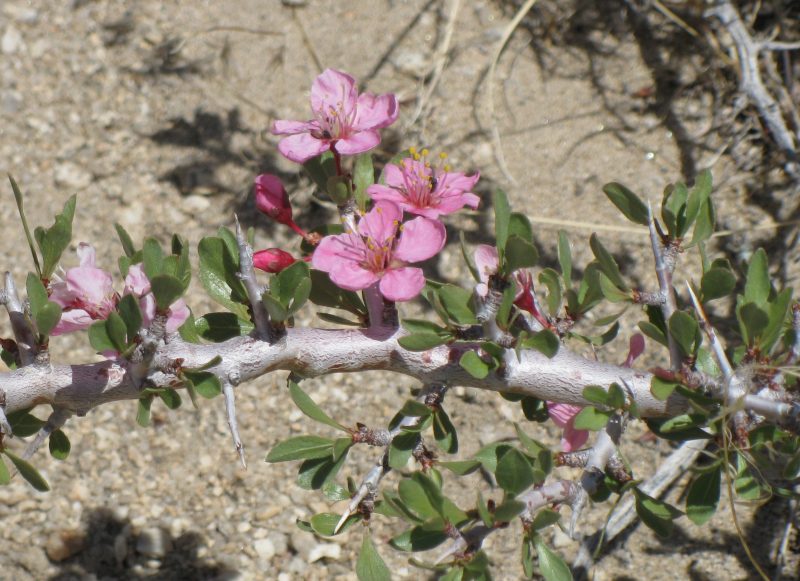
Desert Peach (Prunus andersonii) is a deciduous shrub that adds grace and charm to desert landscapes with its delicate pink flowers and soft, fuzzy leaves. Typically reaching heights of 3 to 6 feet, Desert Peach produces clusters of stunning blossoms in the spring, creating a breathtaking display that heralds the arrival of warmer weather. The flowers not only beautify the garden but also attract local wildlife, including bees and butterflies, contributing to a flourishing ecosystem.
This plant is well-adapted to arid environments, thriving in sandy or rocky soils with excellent drainage. Desert Peach exhibits a remarkable tolerance for drought once established, making it an ideal choice for low-water home landscaping. It has a unique ability to thrive in areas that experience extreme temperature fluctuations, adding to its robustness as a garden staple.
When planting Desert Peach in your landscaping design, consider its placement near pathways or seating areas, where the delightful fragrance of its blooms can be fully appreciated. It pairs beautifully with other desert plants and shrubs, helping to create a diverse and colorful garden environment. Additionally, its relatively compact size lends itself well to smaller gardens or urban landscaping, making it a versatile option for enhancing outdoor spaces.
Poodle Dog Bush
Poodle Dog Bush (Eriodictyon parryi) is a distinctive perennial shrub native to the southwestern United States, known for its unique, fluffy appearance resembling a poodle’s fur, hence the name. This remarkable shrub typically grows to about 3 to 5 feet tall and spreads between 3 to 6 feet wide, providing a striking visual element in any arid landscape. Its elongated, silver-green leaves are coated with fine hairs, giving them a velvety texture. In late spring, Poodle Dog Bush bursts into bloom, producing clusters of small blue to lavender flowers that attract a variety of pollinators.
Aside from its aesthetic appeal, the Poodle Dog Bush is well adapted to dry conditions. It thrives in well-drained soils and requires little irrigation once established, making it an excellent option for xeriscaping and low-maintenance gardens. A remarkable attribute of this bush is its ability to thrive in sandy or rocky substrates, where many other plants might falter. However, caution is advised during establishment, as the plant can be sensitive to overwatering.
In landscaping design, Poodle Dog Bush can serve multiple functions. Its lush foliage and beautiful blooms are perfect for creating a natural border or hedging, while its unique appearance can make it a focal point among other desert plants. Planting Poodle Dog Bush alongside other drought-resistant species enhances the overall aesthetic and ecological function of your garden. Additionally, this shrub is known for its fragrant leaves, which release a sweet aroma when crushed, adding a sensory dimension to your outdoor space.
Desert Star
Desert Star (Monoptilon bellidiforme), also known as Desert Starflower, is a charming perennial that offers a unique option for desert gardens. Growing to a modest height of about 6 to 12 inches, this low-growing plant features delicate, daisy-like flowers that bloom in a striking white or pale yellow, often highlighted with a subtle blue-purple tint at the center. The blooms appear in the late spring and continue through early summer, adding a touch of brightness to arid landscapes.
Desert Star is particularly well-suited to sandy or rocky soils and thrives in full sun. Its tolerance for drought makes it an excellent choice for low-water gardening, requiring little attention once established. One of the advantages of Desert Star is its compact growth habit, which allows it to fill in bare spots in your garden effectively. This makes it a great candidate for ground cover or underplanting around taller desert plants, creating a lush, layered look in landscaping.
In addition to its aesthetic appeal, Desert Star plays a crucial role in supporting local wildlife. The nectar-rich flowers attract bees, butterflies, and other pollinators, contributing to the biodiversity of your garden. Planting Desert Star in clusters can create a stunning visual impact, and when combined with other native plants, it allows for a diverse and colorful desert habitat. This little plant’s combination of beauty, resilience, and ecological value makes it an excellent addition to any desert garden.
Pencil Plant
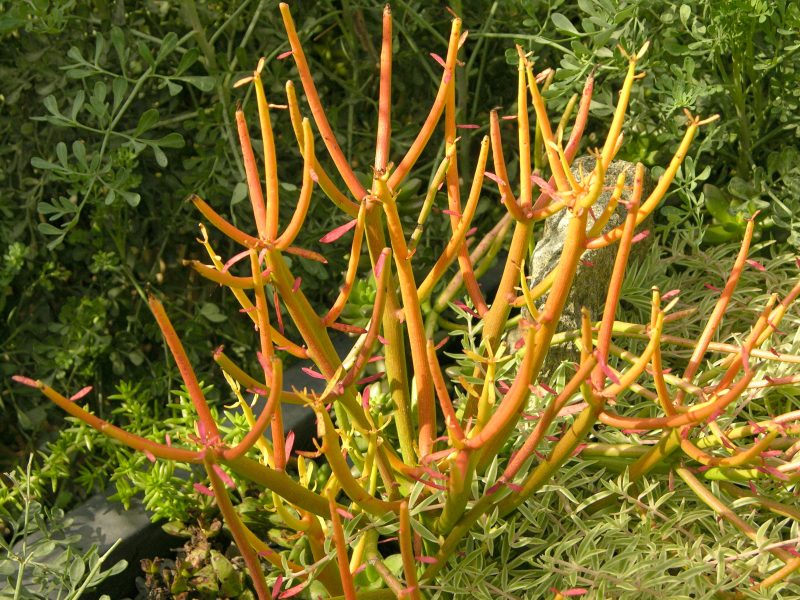
Pencil Plant (Euphorbia tirucalli), also known as milk bush or firestick plant, is a unique succulent that adds striking architectural interest to desert landscapes. This plant is characterized by its thin, upright stems that resemble green pencils, which can reach heights of 6 to 10 feet if left unpruned. The Pencil Plant can also produce clusters of small yellow flowers. In certain conditions, its stems may develop a brilliant reddish or orange hue, particularly when exposed to direct sunlight, creating a stunning visual contrast in the garden.
One of the noteworthy traits of Pencil Plant is its exceptional drought tolerance. It requires minimal water and thrives in well-drained soils, making it an ideal choice for low-maintenance landscaping. As a succulent, it efficiently stores water in its stems, allowing it to survive prolonged periods of drought. However, it is important to note that Pencil Plant can be sensitive to frost and should be protected in colder climates.
In landscaping, Pencil Plant can serve as a striking focal point or a captivating background element. Its dramatic vertical growth habit works well in modern or minimalist designs, while its unique form can add visual intrigue to more traditional landscapes. Pencil Plant pairs well with a variety of desert plants and succulents, creating an eye-catching display when used in combination with colorful flowering plants. Just ensure to handle it with care, as the sap is milky and can be irritating to the skin.
Bougainvillea
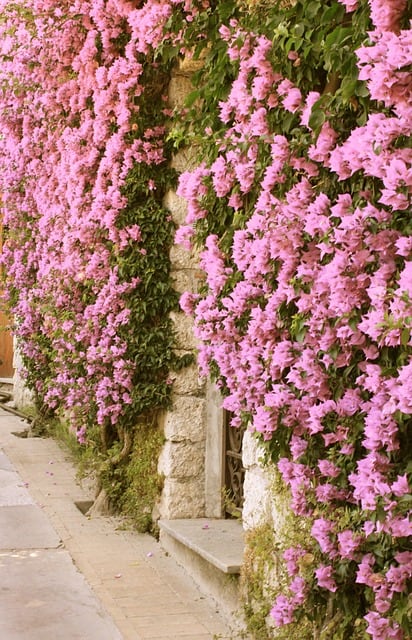
Bougainvillea is a celebrated tropical vine that has become a favorite among desert gardeners for its vibrant, showy bracts and ability to thrive in dry, sunny conditions. While native to South America, this plant has found a welcoming home in arid environments around the world. Bougainvillea is known for its rapid growth and can reach heights of 3 to 40 feet, depending on the variety and support structures provided, making it an ideal candidate for covering fences, arbors, and trellises with an explosion of color.
What sets Bougainvillea apart is its spectacular display of bright pink, purple, red, and orange bracts that often surround small, inconspicuous white flowers. The color intensity and duration of bloom, which can last from spring through fall, depend significantly on the variety and growing conditions. This plant thrives in well-drained, poor soil and requires minimal irrigation, making it environmentally friendly and sustainable for xeriscaping.
In landscaping, Bougainvillea can be employed in various ways to add vibrancy and texture. Its climbing nature allows it to create stunning vertical gardens when trained on walls or lattice structures. Additionally, it can be planted as a ground cover where it will spill over edges and soften the landscape. Bougainvillea is not only visually striking but also provides essential habitat for pollinators, making it an integral part of a biodiverse garden.
Living Stone
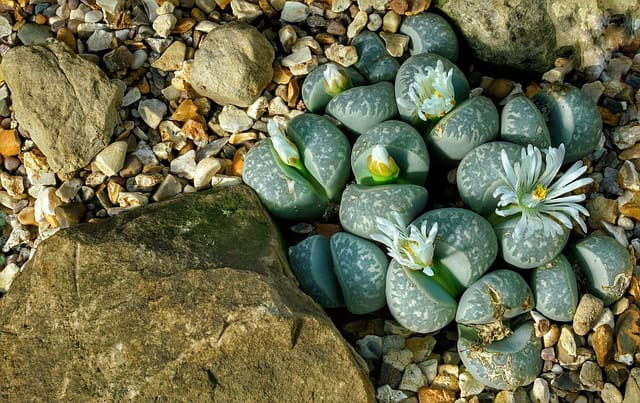
Living Stone (Lithops spp.) is a captivating succulent native to the arid regions of southern Africa. Renowned for its unique appearance, Living Stones are small plants that mimic the look of stones and pebbles, making them a charming addition to any desert landscape. Typically only 1 to 3 inches in diameter, these low-growing succulents feature a pair of thick, fleshy leaves that appear separated, creating an illusion of a rock in their natural habitat. In late summer, Living Stones produce bright flowers that can be yellow, white, or orange, providing a delightful surprise amidst their stony appearance.
These remarkable plants are exceptionally drought-tolerant, as they are adapted to survive in environments where water is scarce. They thrive in well-draining soil and require very little water, making them perfect for low-maintenance gardens. However, it is crucial to ensure that they are not overwatered, as this can lead to root rot.
When incorporating Living Stone into desert landscaping, consider using them in rock gardens or as part of a succulent display. Their unique shape adds visual interest and provides a conversation piece for visitors. Grouping them with other low-growing succulents or contrasting them against gravel or sand creates a stunning textural palette. Additionally, Living Stones require minimal care, allowing busy homeowners to enjoy their beauty without extensive upkeep.
California buckwheat
California buckwheat (Eriogonum fasciculatum var. wiilmattae), also known as the California buckwheat, is a remarkable native shrub that thrives in desert conditions, making it an excellent option for sustainable landscaping. This plant grows about 2 to 3 feet tall and features clusters of small, delicate white to pink flowers that bloom in the spring and summer. Its gray-green leaves provide an elegant contrast to the bright blossoms, attracting a variety of pollinators, including butterflies and bees.
Cape Blanco is particularly well-suited for low-water gardens, as it flourishes in well-drained soils and requires minimal irrigation once established. Its adaptability to harsh conditions makes it an ideal choice for landscapes that endure hot summers and cold winters. Cape Blanco is resistant to many pests and diseases, further enhancing its low-maintenance qualities.
In desert landscaping, Cape Blanco serves various functional and aesthetic purposes. It can be used as a ground cover, providing a lush, green carpet that stabilizes soil and prevents erosion. When planted in groups, Cape Blanco creates a beautiful display of blooms that can soften rock gardens or enhance mixed borders with a touch of color and texture. Its drought tolerance and ability to thrive in poor soils contribute to a sustainable landscape design, making it a practical choice for environmentally conscious gardeners.
Crown of Thorns
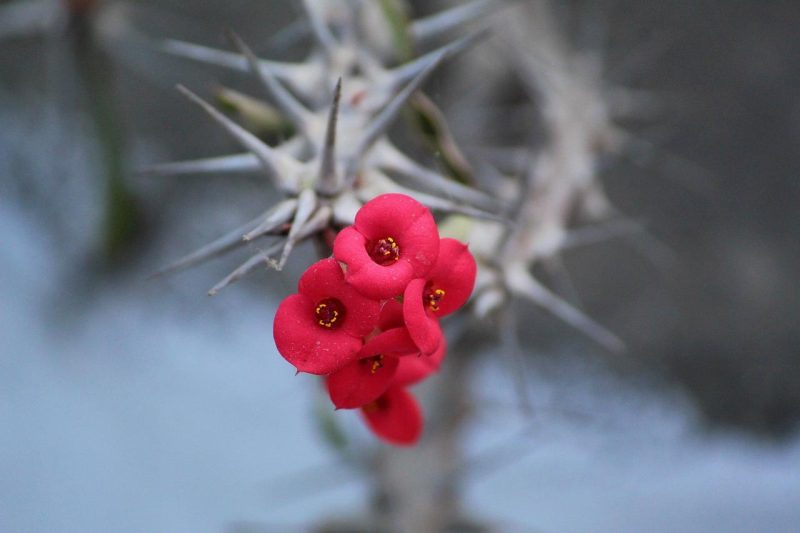
Crown of Thorns (Euphorbia milii) is a stunning succulent that stands out for its striking appearance and resilience in hot, dry climates. This plant is characterized by its thick, green stems covered with sharp spines and clusters of small, colorful bracts that can range from bright reds and pinks to yellows and whites. The addition of this vibrant color to your garden makes it an eye-catching focal point, particularly against the backdrop of desolate landscapes.
Crown of Thorns thrives in full sun and well-drained soil, making it exceptionally suited for areas with low moisture. With minimal irrigation needs, it is ideal for xeriscaping and can survive short periods of drought. This plant also features a long flowering season, blooming continuously throughout the warmer months, which adds ongoing interest and beauty to your landscape.
In landscaping design, Crown of Thorns can serve both decorative and functional purposes. Its thorny structure makes it an excellent choice for informal hedges or borders, acting as a natural barrier against intruders. Additionally, its colorful blooms can create striking contrasts alongside other succulents or drought-tolerant shrubs. Care should be taken when handling the plant, as its milky sap can be an irritant; so, gloves are advisable during plant maintenance.
Indian Paintbrush
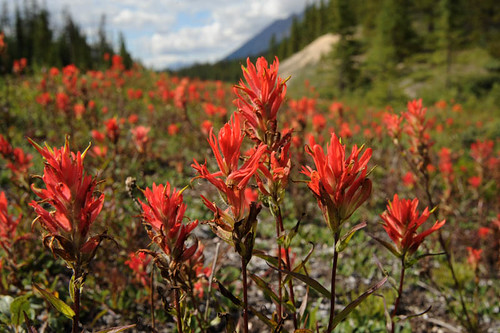
Indian Paintbrush (Castilleja spp.) is a captivating wildflower that adds a splash of vibrant color to desert landscapes. Native to the western United States, this perennial herb typically features bright red, orange, or even yellow tubular flowers that resemble paintbrushes dipped in vivid pigments. Blooming in the spring and summer, Indian Paintbrush creates a stunning contrast against the stark backdrop of desert soils and rocks.
The beauty of Indian Paintbrush lies not only in its striking colors but also in its unique growth habit. This plant is hemiparasitic, meaning it derives some nutrients and water from the roots of neighboring plants while also photosynthesizing its own food. This unique relationship allows Indian Paintbrush to thrive in nutrient-poor soils commonly found in desert habitats.
In terms of landscaping, Indian Paintbrush can be an excellent choice for naturalistic gardens, rock gardens, or meadows. When planted in groups or drifts, these flowers create an enchanting display that brightens any outdoor space. Pairing Indian Paintbrush with other native desert plants enhances the visual impact and supports local wildlife, including pollinators like bees and butterflies. It is important to note that Indian Paintbrush may require some additional moisture during establishment, making it a fantastic companion for plants that also thrive in similar environments.
Pink Muhly Grass
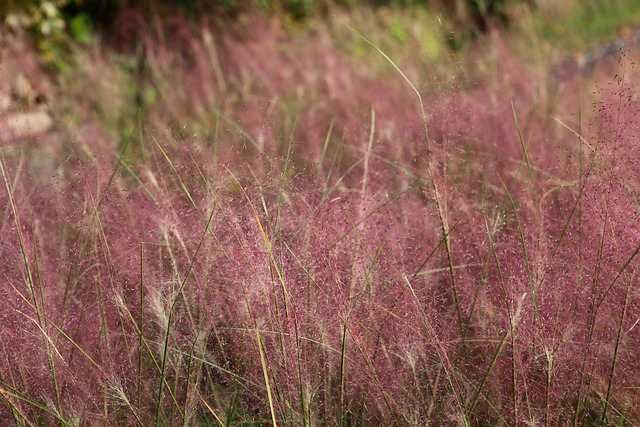
Pink Muhly Grass (Muhlenbergia capillaris) is a decorative grass that brings a delicate, airy quality to desert landscaping. Recognized for its fine-textured foliage and cloud-like plumes, this grass reaches heights of 2 to 4 feet and produces fluffy, pink-purple flower spikes during the late summer and fall. As the flowers sway gently in the breeze, they create a captivating visual spectacle that adds movement and softness to the landscape.
This grass is well adapted to arid conditions, thriving in well-drained soils and full sun. Its drought tolerance makes it an excellent candidate for low-water gardens, and it requires minimal maintenance over time. One of the post-bloom features of Pink Muhly Grass is its impressive seed heads, which maintain aesthetic appeal throughout the winter months, providing visual interest even in dormancy.
In landscape design, Pink Muhly Grass makes a bold statement when used in mass plantings, serving as a stunning backdrop to other desert plants and succulents. It can also be used effectively as a border plant, adding texture and softness to hardscapes or creating visual separation between different areas of the garden. Furthermore, its ability to attract wildlife—particularly birds seeking shelter and seeds—enhances the biodiversity of your space, making it a crucial component in promoting a thriving desert ecosystem.
Bastard Toadflax
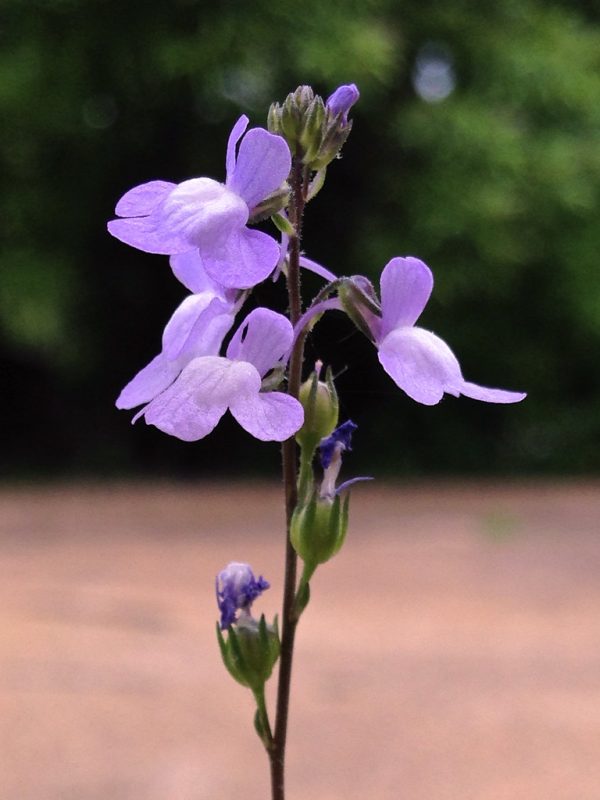
Bastard Toadflax (Nuttallanthus canadensis), also known as toadflax or butter-and-eggs, is a perennial wildflower known for its bright yellow blooms and low-growing habit. This herbaceous plant typically measures between 12 to 18 inches in height, making it an ideal candidate for ground cover or complementing taller plants in a mixed border. The flowers, which bloom from spring to early summer, appear in dense clusters, attracting pollinators like bees and butterflies with their vibrant color.
Bastard Toadflax is well-suited for arid conditions and can tolerate a range of soil types, provided they are well-drained. This plant thrives in full sun and is drought-resistant once established, requiring minimal maintenance and irrigation. Its adaptability makes it suitable for rock gardens, wildflower meadows, or as part of a xeriscaped landscape, where it can create a colorful display without demanding water.
In landscaping applications, Bastard Toadflax can be utilized effectively as a low border along pathways or as a filler between larger plants, providing a natural look and softening hard edges. Its early bloom time can also extend the flowering season of your garden, as it complements other late-blooming plants. Additionally, this hardy plant is known for its self-seeding capabilities, allowing it to spread naturally and create a self-sustaining environment that requires little further intervention.
Mormon Tea

Mormon Tea (Ephedra viridis) is a fascinating evergreen shrub with a unique appearance, characterized by its jointed, green stems that resemble bamboo rather than traditional leafy plants. This desert plant is native to the southwestern United States and thrives in arid deserts, making it an ideal addition to water-wise landscapes. Mormon Tea reaches a height of 2 to 4 feet and is often found growing in sandy or rocky soils, where it requires very little water.
One of the notable features of Mormon Tea is its use in traditional herbal medicine, where it has been utilized for centuries for its diuretic properties. The stems of this plant can be harvested and brewed into a tea, providing both cultural significance and practical use. However, it’s important to note that Mormon Tea should be consumed with care, as high doses of its primary chemical compound, ephedrine, can lead to adverse side effects.
When incorporating Mormon Tea into landscaping, consider its structural growth and the way its stems contrast with other softer foliage. It can serve effectively as a focal point in xeriscaped gardens, providing texture and interest throughout the year. Additionally, since it is a dioecious plant (having male and female varieties), planting both sexes will allow for the pollination of flowers, although they are not particularly showy compared to other flowering plants. Mormon Tea is also low-maintenance and resistant to pests and diseases, making it a valuable addition to a desert garden.
Jumping Cholla
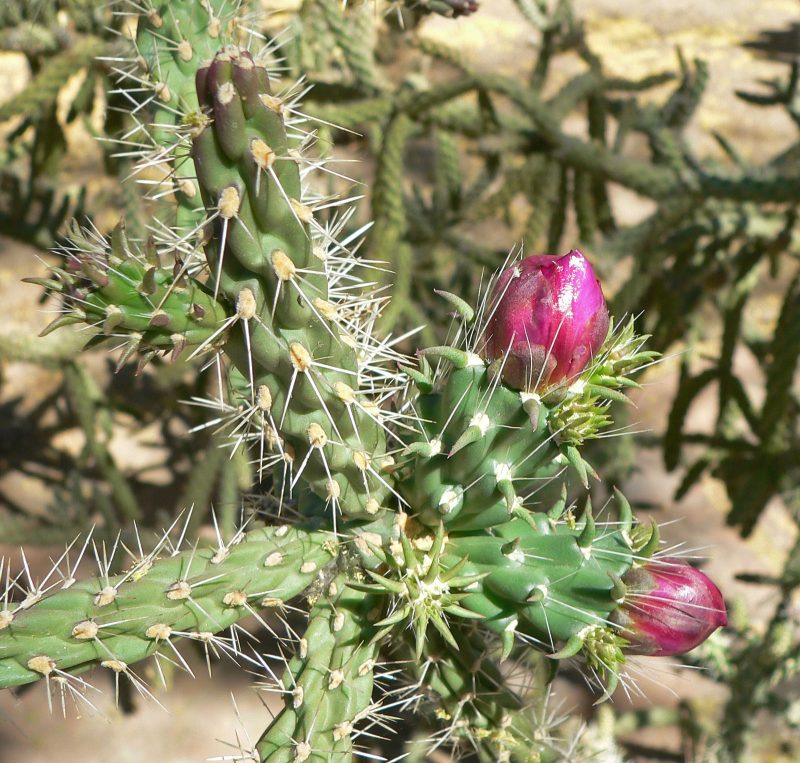
Jumping Cholla (Cylindropuntia fulgida) is an iconic cactus native to the Sonoran Desert, known for its distinctive cylindrical shape and peculiar ability to “jump” off the parent plant. Its segmented cylindrical stems can detach easily when brushed against, hence the name “jumping cholla.” This cactus typically grows 3 to 6 feet tall and features spines that can deliver a painful sting, a notable defense mechanism that enhances its survival in harsh desert conditions.
Jumping Cholla blooms in the spring, producing showy yellow or green flowers that attract birds and pollinators. The fruits that develop after flowering are an important food source for wildlife. In traditional cultures, the pads (or joints) of this cactus were used for food and medicinal purposes, showcasing its versatility beyond aesthetics.
In landscaping, Jumping Cholla can be utilized as an eye-catching specimen plant or grouped in clusters for a dramatic effect. Its unusual form and vibrant blooms make it a conversation piece in any garden. However, caution is advised when placing this cactus, as its spines can be a hazard for pets and children. It is best planted in areas where it can be appreciated from a distance or in features designed to highlight cacti without direct accessibility.
Despite its sharp spines, Jumping Cholla offers benefits in the landscape, including providing shelter for small birds and insects. Its drought-resilient nature makes it a vital piece for sustainable gardening, and it pairs well with other desert plants to create a vibrant tapestry of colors and textures in your garden.
Vervain
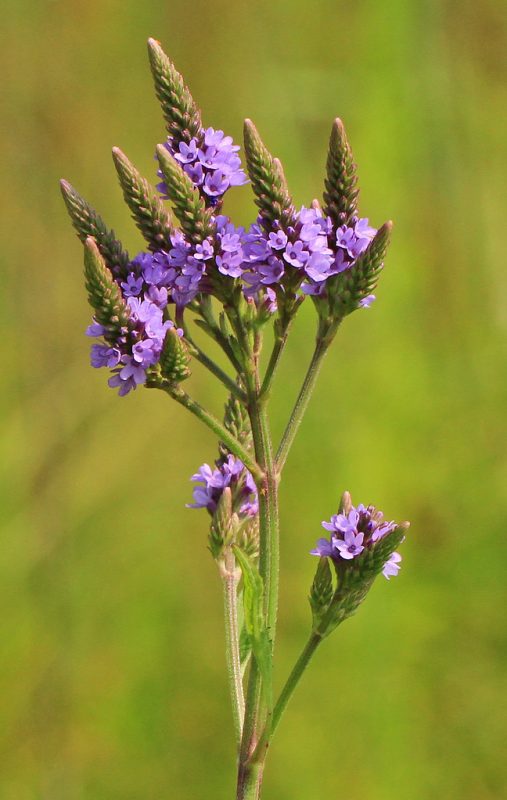
Vervain (Verbena spp.) is a vibrant flowering plant that thrives in various climates, including arid desert regions. Known for its clusters of small, colorful flowers that bloom in shades of purple, blue, pink, and white, Vervain adds a cheerful splash of color to garden spaces. This perennial herb is typically low-growing, reaching heights of 1 to 3 feet, making it an excellent choice for ground cover or as a border plant.
Vervain is particularly valued for its drought tolerance and adaptability to poor soils, thriving in full sun and requiring minimal water once established. Its landscaping potential is extraordinary, as it attracts pollinators, including bees and butterflies, making it a perfect addition to a wildlife-friendly garden. Additionally, Vervain is often used as a companion plant, helping to deter pests while enriching the biodiversity of your garden.
In design, Vervain can be interplanted with succulents, grasses, and low shrubs to create a dynamic, layered appearance. Its long blooming season, which stretches from late spring through fall, ensures your garden remains colorful and lively. For added interest, consider planting Vervain in pathways or alongside stones, where its cheerful blooms can spill over and soften hardscapes.
Galleta Grass
Galleta Grass (Hilaria jamesii) is a perennial grass native to the western United States and recognized for its fine, dense clumps that provide texture and movement in desert landscapes. Reaching heights of 18 to 30 inches, Galleta Grass is known for its adaptability to sandy, rocky, or moderately alkaline soils. It is especially drought-tolerant, making it an ideal choice for low-water landscaping or xeriscaping projects.
One of the noteworthy qualities of Galleta Grass is its resilience against foot traffic, which makes it suitable for areas with some degree of human activity. It develops a robust root system that not only stabilizes the soil but also helps reduce erosion—an essential function in desert environments prone to dry washes and windblown sand.
In landscaping applications, Galleta Grass can be utilized as a ground cover to fill empty spaces while providing habitats for various small wildlife. Its graceful appearance makes it suitable for accentuating rock gardens or contrasting against boulders. Furthermore, during late summer and fall, its flower spikes turn a beautiful golden hue, adding seasonal interest and contributing to the overall aesthetic appeal of the landscape. Planting Galleta Grass alongside other native plants can create a harmonious, ecologically balanced environment that thrives in arid conditions.
Big Sagebrush

Big Sagebrush (Artemisia tridentata) is a quintessential shrub of North American deserts, often serving as the backbone of the sagebrush ecosystem. This larger shrub can grow 3 to 10 feet tall and is characterized by its silvery-green foliage that emits a fragrant aroma when brushed against. The leaves are deeply lobed, giving them a distinctive appearance, and during the late summer and fall, it produces small, inconspicuous yellow flowers that provide nectar for various pollinators.
Big Sagebrush is exceptionally well-adapted to dry environments, showcasing a remarkable ability to survive with minimal rainfall. Its expansive root system allows it to tap into moisture deep below the surface, making it an ideal choice for sustainable landscaping that conserves water. Additionally, Big Sagebrush is incredibly important for wildlife; it provides habitat and food for many desert species, including birds, rodents, and larger mammals.
In terms of landscaping, Big Sagebrush can offer structure and height to desert gardens, making it an impactful focal point. Its resilience allows it to be planted in areas that may be challenging for other plants. Furthermore, it pairs beautifully with a range of desert flora, including cacti, succulents, and wildflowers, creating a vibrant display of colors and textures. The unique aroma of Sagebrush can also add a sensory dimension to your garden, making it a distinct experience for visitors.
Yellow Bells
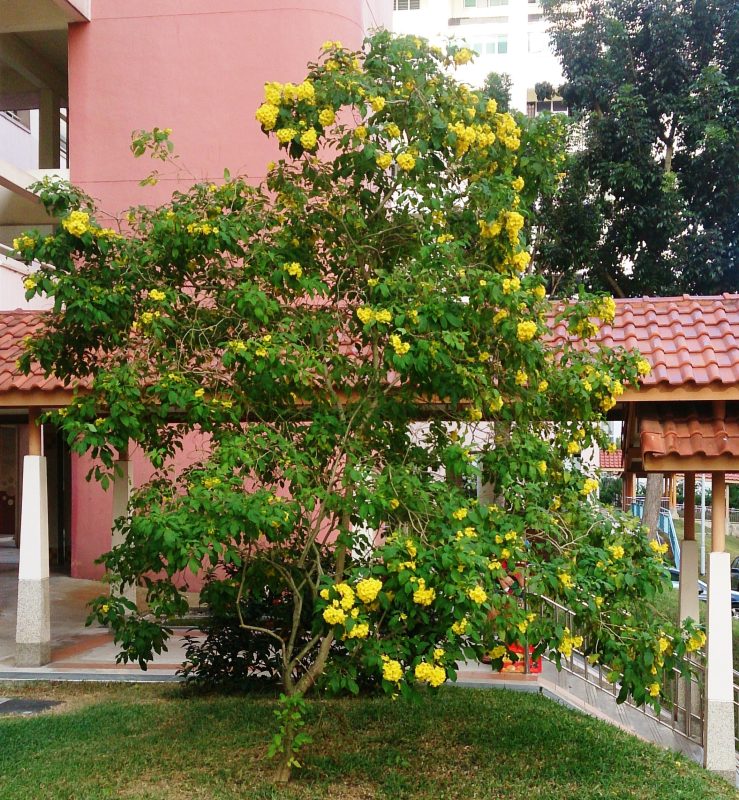
Yellow Bells (Tecoma stans) is a native flowering shrub that brings a bright burst of yellow color to desert landscapes. Known for its vibrant trumpet-shaped flowers, which bloom profusely throughout the summer months, Yellow Bells can reach heights between 3 to 10 feet, depending on growing conditions and pruning practices. This plant’s ability to attract hummingbirds and butterflies makes it an excellent choice for wildlife-friendly gardens, providing an essential food source for these pollinators.
This shrub is particularly well-suited for arid environments due to its drought tolerance once established. Yellow Bells prefers full sun and well-drained soils, thriving in the heat and challenging conditions common to desert landscapes. With its robust nature, it can also withstand light frosts, adding to its versatility.
In terms of landscaping appeal, Yellow Bells can be used as a colorful focal point, planted in groups for a dramatic effect, or as a natural hedge to provide privacy and shelter. Its lively blooms can add vibrancy to patios and pathways, while its green foliage provides a lush backdrop for other desert plants and succulents. For those looking to create layered plantings, pairing Yellow Bells with contrasting plants like desert sage or various cacti can enhance the overall garden design, ensuring that your home landscape is both practical and aesthetically pleasing.
Desert Palm Tree
Desert Palm Trees (Washingtonia filifera), often referred to as the California Fan Palm, evoke a sense of tropical paradise while thriving in dry conditions. This majestic tree can grow up to 75 feet tall, making it an impressive specimen in any landscape. With its fan-shaped fronds that provide dappled shade and its rugged trunk, the Desert Palm transforms any barren spot into a lively focal point, bringing an element of grandeur to home gardens.
These palms are highly tolerant of drought and can withstand extreme heat, making them perfect candidates for desert landscaping. They prefer well-drained soil and full sunlight but can adapt to various soil types, offering versatility in planting locations. The Desert Palm is not only resilient but also low-maintenance, requiring minimal care once established—making it ideal for home gardeners seeking low-water solutions.
Landscape designs incorporating Desert Palm Trees can vary from tropical-style gardens to modern minimalist layouts. When planted in groups, they create an inspiring, dramatic effect, perfectly suited for entranceways or patios. Additionally, these palms can provide shade for other desert plants, enhancing biodiversity in your garden. Their long lifespan and unique aesthetic make them an enduring investment in any landscape design.
Cooper’s Hardy Ice Plant
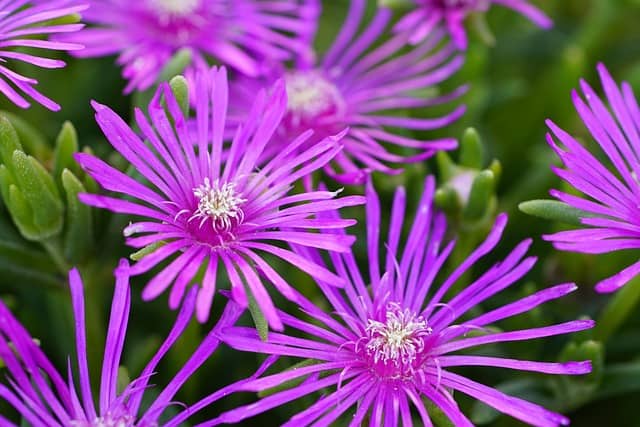
Cooper’s Hardy Ice Plant (Delosperma cooperi) is a succulent ground cover that thrives in rocky, low-nutrient soils common to desert environments. Notable for its vibrant magenta flowers that bloom from spring through fall, this hardy plant spreads rapidly, creating a colorful carpet of blooms that can transform any arid patch into a vibrant tapestry. The foliage remains green and succulent throughout the growing season, providing a lush appearance even when other plants may begin to show signs of drought stress.
This ice plant is highly drought-tolerant and resilient against harsh sun exposure, making it an ideal choice for xeriscaping initiatives. Its ability to thrive in poor, well-drained soils means it can fill in difficult spaces where other plants may struggle, providing unique opportunities for creative landscaping.
In terms of design, Cooper’s Hardy Ice Plant works wonderfully in rock gardens, along pathways, or as erosion control on slopes due to its spreading nature. Its profuse blooms create a stunning visual impact, particularly against contrasting colors and textures of other desert flora. Combining this hardy ground cover with taller native plants or ornamental grasses can create an engaging layered landscape that showcases both height and color.
When planting Cooper’s Hardy Ice Plant, consider mixing it with different varieties of succulents or low-water flowering plants to enhance visual interest and ensure year-round charm in your desert garden.
Indian Rice Grass
Indian Rice Grass (Achnatherum hymenoides), a perennial bunchgrass indigenous to the Great Basin and surrounding regions, is celebrated for its adaptability and utility in home landscaping. Typically growing to a height of 1 to 2 feet, this grass is well-known for its attractive, fine-textured leaves and delicate flower spikelets that appear from late spring to summer, creating a soft, airy feel in the garden. The flower heads are often a striking golden color, adding warmth and brightness to the landscape.
This grass is particularly drought-tolerant, making it an excellent choice for xeriscaping. Indian Rice Grass thrives in sandy or rocky soils and is best suited for full sun, although it can tolerate partial shade. One of its standout benefits is its extensive root system, which helps prevent soil erosion—a vital aspect for maintaining healthy desert ecosystems.
In landscaping, Indian Rice Grass can be used to create naturalistic prairie-style gardens or as a backdrop for flowering plants. Planting it in clusters can help establish a cohesive look while encouraging biodiversity by attracting pollinators and wildlife. Additionally, this grass is known for providing habitat and food for birds and small mammals, reinforcing the ecological value of your garden space. Its easy-care nature and graceful beauty make Indian Rice Grass an ideal choice for adding texture and sustainability to desert landscapes.
Rubber Rabbitbrush
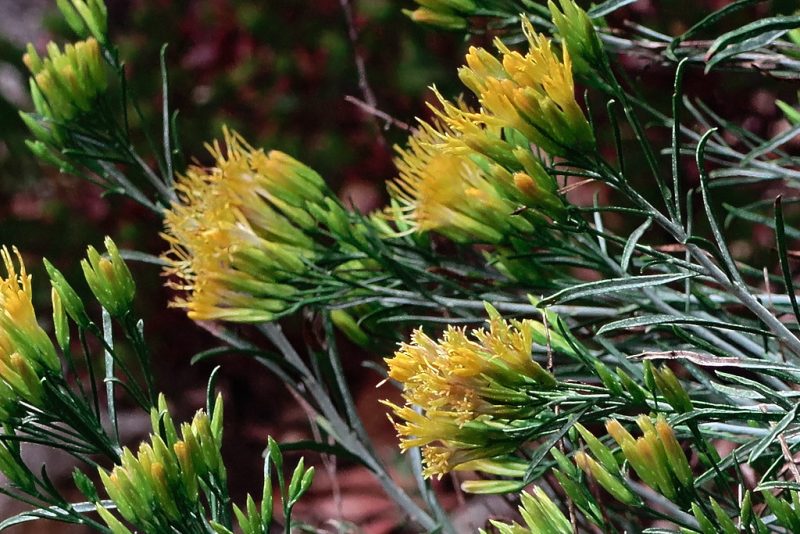
Rubber Rabbitbrush (Ericameria nauseosa) is a striking shrub commonly found in the western United States, known particularly for its vibrant yellow blooms that appear in late summer and fall. This hardy plant can reach heights of 3 to 7 feet and is characterized by its slender, upright growth habit and aromatic, gray-green foliage. The flowers attract a variety of pollinators, including bees and butterflies, enriching the biodiversity of your garden during a time when many other plants have stopped blooming.
Beyond its beauty, Rubber Rabbitbrush is valuable for its adaptability to dry conditions, thriving in poor, well-drained soils with minimal water requirements once established. Its innate resilience to drought makes it a perfect candidate for water-wise landscaping. The plant’s ability to support wildlife encourages a thriving ecosystem; besides pollinators, its seeds are a food source for birds and mammals.
In terms of landscape design, Rubber Rabbitbrush can be used effectively as a focal point or as part of a mixed border with other drought-tolerant plants. Its striking color contrasts beautifully with the greens and silvers of other desert flora, making it an eye-catching addition. For a more natural look, consider planting it in clusters alongside native grasses or ground covers. The texture and height of Rubber Rabbitbrush can create an engaging layered effect while minimizing maintenance needs and enhancing the overall ecological health of your garden.
Great Basin Wildrye
Great Basin Wildrye (Leymus cinereus) is a robust perennial grass that thrives in the arid conditions of western North America. Known for its tall, upright growth, this grass can reach heights of 2 to 4 feet, making it an impactful landscape plant that adds vertical interest. The grass features long, narrow leaves and distinct seed heads that can sway gracefully in the breeze, bringing movement to your garden design.
Great Basin Wildrye is well-adapted to drought conditions and is particularly suited for sandy or loamy soils with good drainage. It is excellent for erosion control and stabilization along slopes or in areas prone to runoff. Its extensive root system helps retain moisture and improve soil structure, making it a valuable ally for sustainable landscaping practices.
In landscaping, Great Basin Wildrye serves multiple purposes. Its height makes it suitable as a backdrop for shorter flowering plants, creating a beautiful contrast of colors and textures. Additionally, it can be used effectively in restoration projects, helping to restore native habitats and improve ecological diversity. When planted in clusters, Great Basin Wildrye can form attractive, flowing drifts that mimic natural grasslands, adding a sense of continuity and harmony to your landscape.
Cheatgrass
Cheatgrass (Bromus tectorum), though often regarded as an invasive species, can play a beneficial role in certain landscaping contexts when managed appropriately. This winter annual grass germinates in the fall, providing early green growth that is a critical source of forage for wildlife during the colder months. It typically reaches heights of 1 to 2 feet and produces noticeable wind-dispersed seeds in the spring.
In desert landscaping, Cheatgrass can help prevent soil erosion, stabilizing sandy soils and promoting growth in disturbed areas. Its ability to thrive in various soil types and its rapid establishment make it a candidate for rehabilitation projects where soil improvement is necessary. Homeowners may actually harness its growth for greater ecological balance, particularly in combination with native perennials that will outcompete it for nutrients and light in the long term.
While Cheatgrass can provide temporary ground cover, it’s essential to monitor its growth closely. In a home garden, this grass works best when integrated with other desert plants that are deeper-rooted, allowing them to flourish once the Cheatgrass dries out in the heat of summer. To maximize the aesthetic appeal, consider blending it into a wildflower garden or incorporating it alongside flowering perennial plants that will create a diverse ecosystem, benefiting both your garden’s appearance and local wildlife.
Blackbrush

Blackbrush (Coleogyne ramosissima) is a key shrub of the Mojave and Sonoran Deserts, known for its durability and unique aesthetic. Reaching heights of 3 to 10 feet, this dense, sprawling shrub has thin, wiry branches and small, dark green leaves that give it a distinctive appearance. Its dark, tangled form can serve as an excellent privacy screen or windbreak, making it functional for many home landscaping needs.
Blackbrush is exceptionally drought-tolerant and can withstand extreme temperatures, making it a robust option for low-water use gardens. This plant thrives in rocky or sandy soils, often forming large stands that can help stabilize the soil and provide habitats for birds and small mammals. Its ability to anchor the soil helps combat erosion and promotes overall watershed health, which is particularly important in desert regions.
Landscaping with Blackbrush can enhance the natural desert aesthetic of your garden. Its dark silhouette makes it a striking backdrop for flowering plants and succulents, while its dense foliage provides nesting sites for birds. For a more naturalistic look, plant Blackbrush alongside other native desert plants such as Desert Marigold or Yucca. In addition to its beauty, the ecological benefits of this shrub make it a valuable addition to any desert landscaping project.
Cushion Buckwheat
Cushion Buckwheat (Eriogonum ovalifolium) is a charming, low-growing perennial that adapts beautifully to desert landscapes. Typically spreading to around 1 foot in height and 2 feet in diameter, this hardy plant is perfect for ground cover, forming robust cushions of gray-green foliage. In spring and summer, Cushion Buckwheat bursts into bloom with clusters of small, yellow to white flowers that attract pollinators and create delightful patches of color.
This plant is exceptionally drought-tolerant, thriving in poor, well-draining soils, making it ideal for xeriscape gardens. Its compact growth habit allows it to seamlessly fill in empty spaces and prevent weeds, while the dense foliage provides shelter for small wildlife. Cushion Buckwheat’s low maintenance requirements, combined with its beauty, make it a popular choice for homeowners looking to create sustainable, eco-friendly landscapes.
In landscaping, Cushion Buckwheat can be used effectively in rock gardens, slopes, or along pathways, where its low profile won’t obstruct views but will add texture and color. Planting it in combination with other drought-resistant plants, such as Desert Sage or various succulents, can create a vibrant tapestry of life. Furthermore, its flowering period is prolific, and its attractive seed heads can persist into winter, providing visual interest even during the colder months.
Gilia
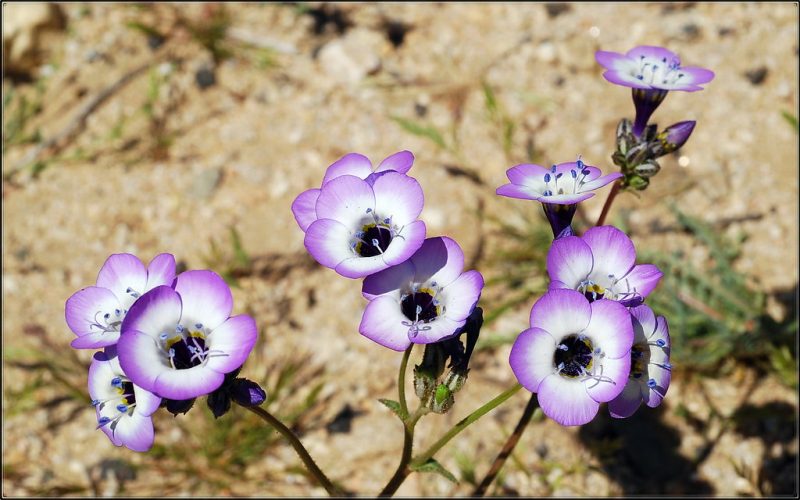
Gilia is a captivating genus of plants that showcases over 30 species, many of which are native to the desert regions of the western United States. Known for their distinctive flowers, Gilia plants can range from prostrate ground covers to upright wildflowers, typically thriving in nutrient-poor sandy or rocky soil. The most popular species for landscaping is Gilia tricolor, appreciated for its delicate, tubular flowers that can appear in shades of blue, purple, pink, and white, often featuring a vibrant yellow throat.
This annual wildflower is well-suited to xeriscaping, needing little water once established, and attracts a variety of pollinators, including bees and hummingbirds. Its colorful blooms may appear as early as spring and last into late summer, bringing delight and vibrant color to the garden during extended periods of bloom.
In terms of landscaping design, Gilia works beautifully when planted in clusters, making a striking visual impact in wildflower gardens or as accents among desert grasses and other low-maintenance perennials. Due to its shorter stature, it pairs well with taller species, adding depth and layering to the landscape. Additionally, combining it with other native plants ensures a dynamic garden that provides nectar sources to pollinators while creating a tapestry of color and texture.
Evening Primrose
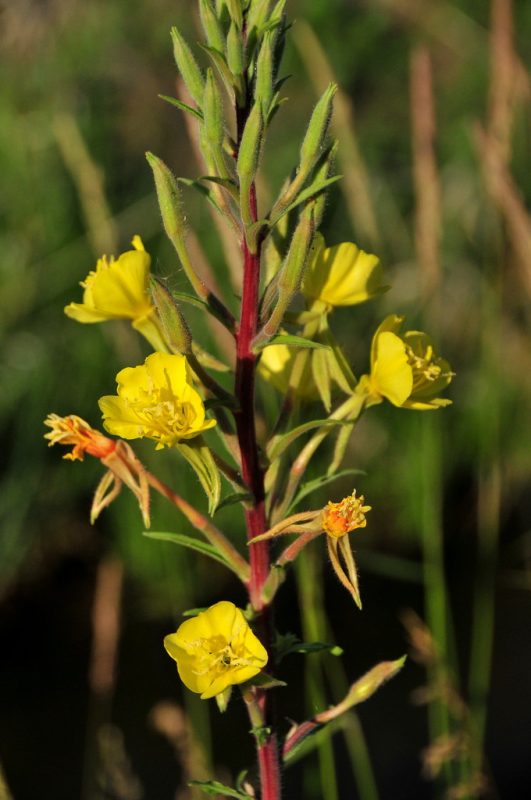
Evening Primrose (Oenothera spp.), particularly the species Oenothera biennis, is a stunning plant known for its fragrant, fragrant blooms that open at dusk. This hardy perennial grows well in various conditions and can reach heights between 2 to 5 feet, showcasing large, yellow, cup-shaped flowers that attract moths and nighttime pollinators. Its blooms are not only beautiful but also exude a sweet scent that enriches the evening landscape, making it an excellent choice for gardens that offer evening enjoyment.
Evening Primrose prefers well-draining soil and full sun but can tolerate some shade. Its ability to withstand drought conditions makes it an ideal candidate for desert landscaping, capable of surviving long periods between watering once established. The plant’s foliage can remain green and lush even in harsh conditions, providing an attractive visual element throughout the year.
In landscaping, Evening Primrose can create stunning contrasts when paired with other perennials and desert plants. When grouped in borders or naturalized settings, they can form a stunning splash of color against the muted tones of desert sand and rocks. Their late-day bloom cycle makes them perfect for planting near patios or evening gathering spots in the garden, allowing homeowners to enjoy their fragrance and beauty as night falls.
Winterfat
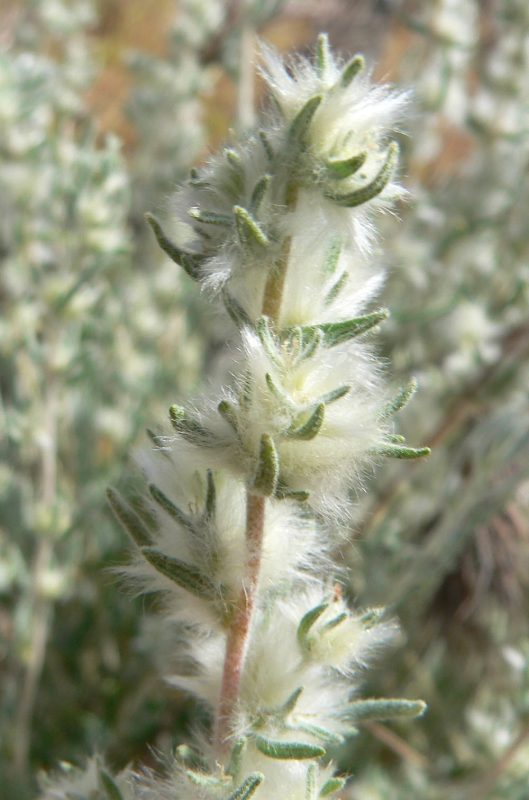
Winterfat (Krascheninnikovia lanata) is an exceptionally hardy shrub native to the arid soils of the western United States, known for its remarkable tolerance to drought and cold. This perennial plant typically grows between 1 to 3 feet in height and features a bushy, compact form studded with gray-green leaves that provide a soft texture and a subtle contrast to brighter flowering plants in your landscape.
One of Winterfat’s unique qualities is its ability to provide food and shelter for wildlife. Its seeds are a preferred food source for numerous birds, while its dense foliage offers cover for small mammals and insects, contributing to a balanced ecosystem within your garden. Winterfat is also valued for its soil stabilization properties, helping to prevent erosion in sandy soils and promoting moisture retention.
In desert landscaping, Winterfat offers both aesthetic and functional benefits. Its muted colors allow it to blend seamlessly with other native plants, making it an excellent spacer between more vibrant species. Designers often use Winterfat in combination with ornamental grasses or shorter flowering plants to create visually appealing layers in the landscape. Furthermore, its low-maintenance nature ensures that the plant remains resilient and thriving with minimal intervention, making it a practical choice for homeowners seeking a sustainable garden.
Sego Lily

Sego Lily (Calochortus nuttallii) is a herbaceous perennial that captivates with its stunning, star-shaped flowers, which bloom in early to mid-spring. This elegant plant generally stands about 1 to 2 feet tall and features slender stems that bear delicate, white or yellow blossoms, often adorned with vibrant purple or maroon markings. Native to the western United States, Sego Lily thrives in dry, sandy, or rocky soils and is ideally suited for low-water and drought-tolerant gardens.
One of the remarkable aspects of Sego Lily is its bulbous root system, which allows the plant to store moisture and survive dry spells. It is relatively low maintenance and prefers full sun but can tolerate partial shade, making it a versatile addition to various landscapes. Additionally, it is a great choice for naturalizing, as it can spread over time to create lovely drifts of color on your property.
In landscaping, Sego Lily performs beautifully when planted in groups or mixed with other wildflowers and native grasses, providing visual interest and a splash of color in your garden. Its early spring blooms can attract pollinators, including bees and butterflies, contributing to the vibrant ecosystem of your outdoor space. The Sego Lily is not just aesthetically pleasing; it’s also rich in cultural significance and history, having been an important food source for Indigenous peoples. Choosing this plant for your landscape enriches your garden while honoring its historical roots.
Antelope Bitterbrush
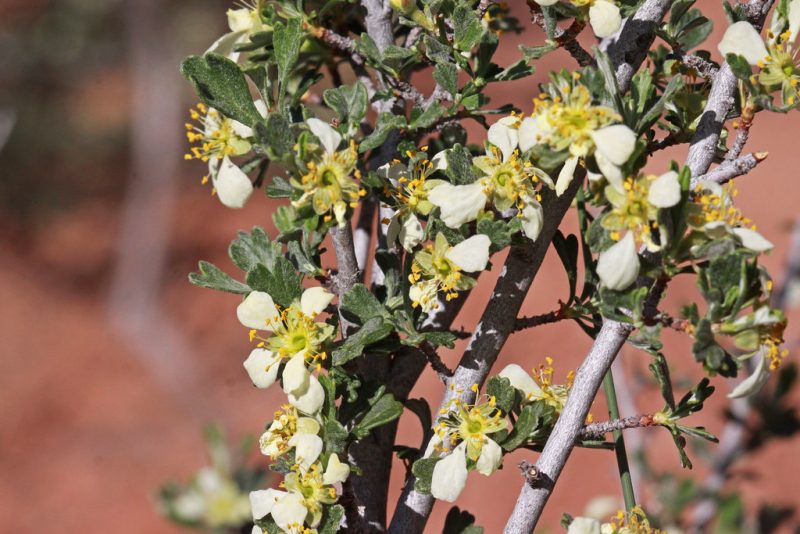
Antelope Bitterbrush (Purshia tridentata) is a drought-tolerant, woody shrub native to the western United States, known for its resilience and ecological importance. This perennial shrub can grow up to 6 feet tall and features trifoliate leaves that turn a stunning golden hue in the fall. Antelope Bitterbrush is especially valued for its striking yellow flowers that bloom in the spring, which provide nectar to numerous pollinators, including bees and butterflies.
One of the most noteworthy aspects of Antelope Bitterbrush is its deep taproot, which enables it to access moisture from deeper soil layers, making it drought-resistant. The shrub also plays an essential role in the ecosystem by stabilizing sandy and rocky soils, preventing erosion and promoting soil health. Additionally, its seeds are a critical food source for many wildlife species, including small mammals and birds, enhancing biodiversity in your garden.
In landscaping, Antelope Bitterbrush can be integrated into native plant gardens or used as a focal point in larger desert landscapes. Its striking colors and dense foliage provide an excellent backdrop for flowering plants, and its height can create privacy or visual interest in a garden setting. Pairing it with low-growing ground covers or other drought-resistant perennials can create a delightful contrast that enhances the overall design while promoting ecological balance.
Desert Willow

Desert Willow (Chilopsis linearis) is a deciduous tree native to the desert regions of the southwestern United States and northern Mexico. This stunning tree typically grows between 15 to 30 feet tall, featuring long, slender leaves and beautiful trumpet-shaped flowers that can vary in color from white to pink and lavender. The blossoms, which appear in late spring and summer, are particularly appealing to hummingbirds and bees, making Desert Willow a favorite among gardeners who appreciate both aesthetics and wildlife gardening.
This tree thrives in full sun and well-draining soils, and its deep root system makes it highly drought-resistant once established. Desert Willow also has the added value of being a fast-growing species, allowing homeowners to quickly enjoy its beauty and shade. Its ability to tolerate heat and arid conditions makes it an ideal choice for desert landscaping, where it can provide relief from the sun while enhancing the garden’s visual appeal.
In terms of landscaping, Desert Willow works well as a standout feature tree in larger yards or as part of a mixed border. Its blossoms bring vibrant color and attract pollinators, which can enrich the overall ecosystem of your garden. Additionally, Desert Willow is often planted near patios or outdoor living areas, as its shade can create comfortable spaces for relaxation. Its graceful form and attractive flowers can complement various design themes, from modern to rustic desert landscapes.
Globemallow
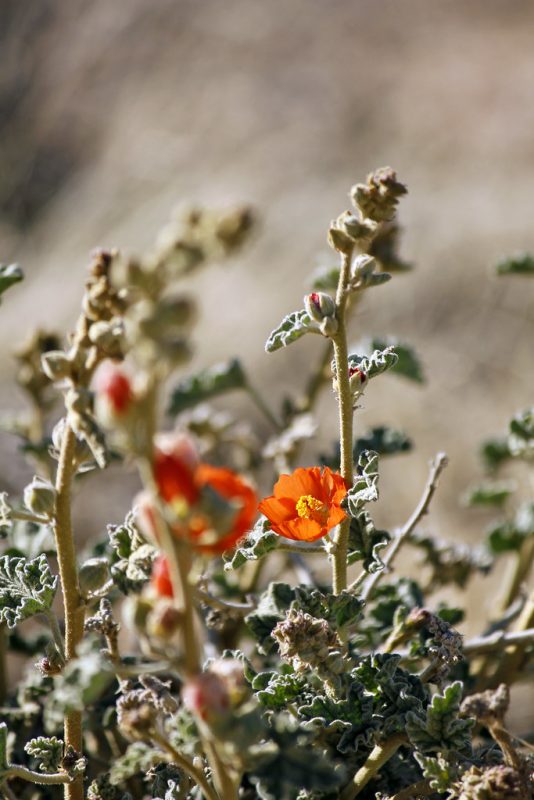
Globemallow (Sphaeralcea spp.) is a perennial wildflower recognized for its stunning, bright orange to pink blossoms that bloom from spring through summer. This adaptable plant typically grows 1 to 3 feet tall and features soft, fuzzy leaves that contribute to its overall visual appeal. With over 20 species of Globemallow found in the western United States, this flowering plant thrives in poor, well-draining soils and is highly resistant to drought, making it an ideal choice for low-water landscaping.
Globemallow has a unique ability to attract a variety of pollinators, including bees, butterflies, and hummingbirds, providing an important nectar source during the hotter months. By incorporating this plant into your home garden, you not only enhance the visual impact but also contribute to the thriving ecosystem of your outdoor space.
In landscaping, Globemallow shines brightly when planted in groups, creating bold displays of color against the muted tones of the desert. It pairs well with other hardy natives, such as Desert Lavender or Sand Verbena, to create vibrant and diverse plantings. Furthermore, its flowers can be a beautiful accent in rock gardens, along pathways, or as a border, where they can attract pollinators and enhance the natural beauty of your landscape.
Utah Juniper
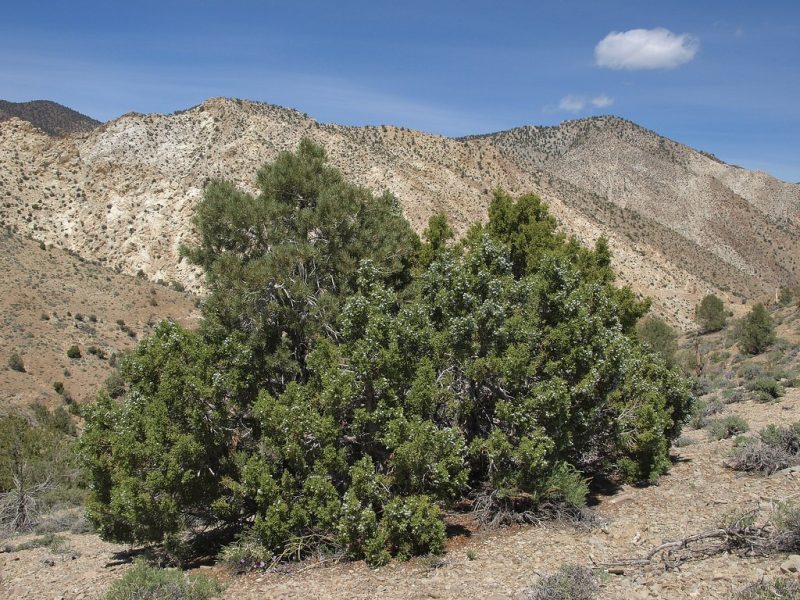
Utah Juniper (Juniperus osteosperma) is a resilient evergreen tree that thrives in the arid conditions of the southwestern United States, primarily found in Utah, Nevada, and parts of Arizona. This medium-sized tree typically reaches heights of 15 to 30 feet, featuring a distinctive, rugged bark and a dense canopy of bluish-green foliage. Its drought resistance and ability to withstand harsh weather make it an excellent choice for desert landscaping.
The Utah Juniper produces small, berry-like cones that not only add interest but also serve as a vital food source for birds and other wildlife. The tree’s dense growth habit provides shelter for local fauna, making it an excellent element for biodiversity in your garden. In addition, its sturdy branches can serve as a natural privacy screen, making it a functional choice for homeowners seeking a more secluded outdoor environment.
In terms of landscaping, Utah Juniper is versatile, fitting seamlessly into various design styles. It can be used as a focal point, integrated into a rock garden, or planted in groups to create a layered effect. Its adaptability to different soil types allows for a variety of planting options, whether in sandy soils or rocky terrain. For a more natural look, it pairs beautifully with other native plants, such as Indian Ricegrass or Bitterbrush, enhancing the overall health and appearance of your desert garden.
Desert Candle
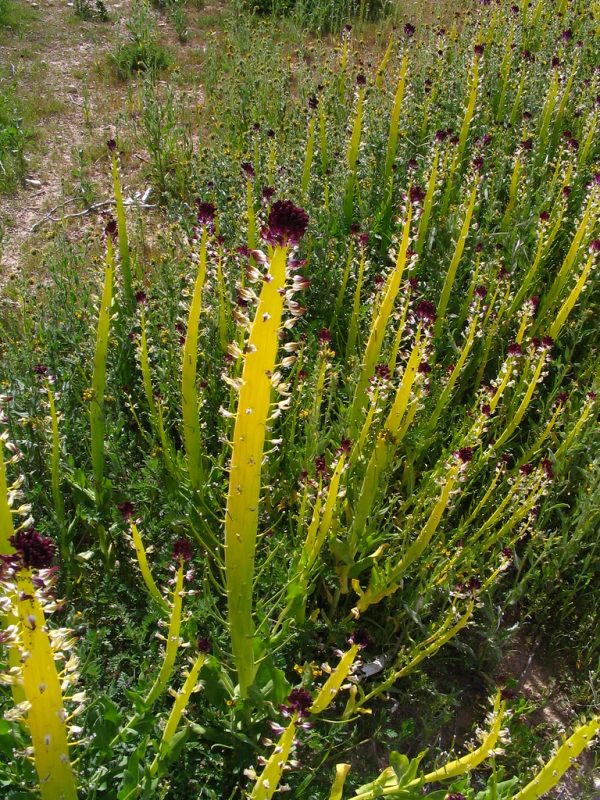
Desert Candle (Eremocrinum alisonii) is a native succulent plant that stands out in any landscape with its tall, cylindrical flower stalks. This fascinating perennial typically grows to 2 to 4 feet in height and features tufted rosettes of narrow, strap-like leaves that store moisture, allowing the plant to thrive in arid conditions. The show-stopping blooms emerge in spring and summer, producing clusters of white to pale yellow flowers that can reach impressive heights and attract pollinators.
Adapted to survive in rocky, well-draining soils, the Desert Candle is highly tolerant of drought and requires minimal upkeep once established. This makes it an ideal choice for homeowners looking for low-maintenance, hardy plants that won’t require frequent watering or care. Its unique floral structure adds a striking architectural element to the landscape, drawing attention and interest.
In terms of landscaping design, Desert Candle works beautifully as an accent plant in garden beds or in mixed arrangements with other succulents and drought-tolerant plants. Due to its height, it can create visual drama among lower-growing plants, making it a fantastic choice for layering within a garden. Additionally, its flowering period can extend the bloom time in your garden, providing seasonal interest and reinforcing local pollinator populations.
Alkali Mariposa Lily
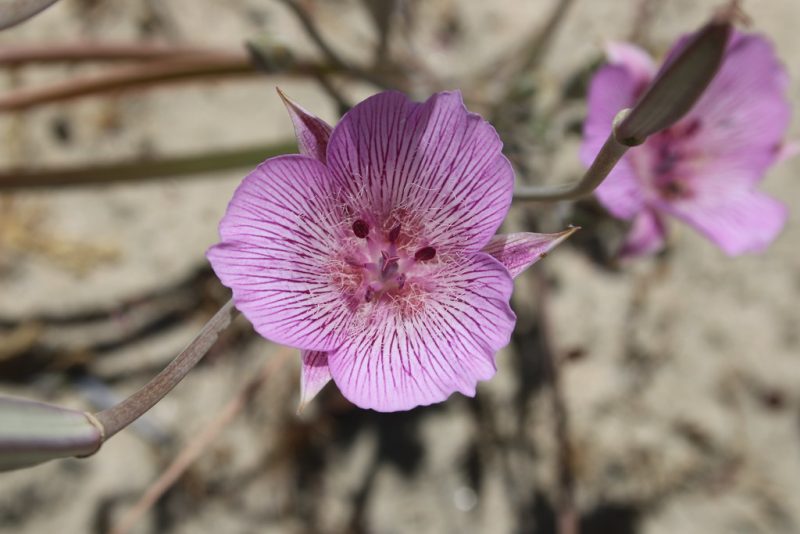
Alkali Mariposa Lily (Calochortus nuttallii var. alkali) is a remarkable perennial wildflower native to the saline and alkaline soils of the western United States. Known for its delicate, cup-shaped flowers, which bloom in vibrant shades of white, yellow, and lavender, this lily typically grows between 1 to 2 feet tall. Flowering occurs in late spring to early summer, and its blooms are often adorned with intricate markings that add to their allure.
This resilient plant has adapted to survive in harsh soil conditions where many other plants might struggle. Its ability to thrive in areas with poor nutrient content makes it an excellent choice for those looking to create low-maintenance, drought-resistant gardens. Alkali Mariposa Lily also serves as a critical food source for pollinators, particularly bees, and butterflies, enhancing the ecological value of any landscape.
In landscaping, Alkali Mariposa Lily can brighten up rock gardens, gravel beds, or any area where drainage is a concern. Planting them in groups creates a stunning display of color and texture, while their early blooms provide a beautiful contrast to the remaining greenery in the summer months. Combining this lily with other native plants like Desert Globemallow or Evening Primrose can lead to a dynamic and thriving garden ecosystem, showcasing the beauty and resilience of desert flora.
Queen of the Night
Queen of the Night (Peniocereus greggii) is a captivating cactus famed for its magnificent, large white flowers that bloom only at night, making it a truly enchanting sight. This species, native to the southwestern United States and parts of Mexico, is noted for its long, slender stems that can reach heights of 4 to 5 feet. The flowers, often measuring up to a foot in diameter, exude a sweet fragrance that attracts nocturnal pollinators, particularly moths.
One of the exceptional qualities of the Queen of the Night is its unique flowering cycle; the blooms typically open after sunset and close by dawn, creating a fleeting yet spectacular spectacle. This characteristic gives it a special place in desert landscaping, as it adds an element of mystery and romance to evening gatherings outdoors. Cultivating this plant can also turn your garden into a living theater for nighttime wildlife interactions.
When designing landscapes, incorporating the Queen of the Night can be a striking addition among other cacti and succulents. Its tall prominent form makes it an excellent focal point in a xeriscape garden. Pairing it with low-growing ground covers or native shrubs provides a pleasing contrast, while its nocturnal blooms can be enjoyed near outdoor seating areas or patios, creating an inviting ambiance for evening relaxation. As a bonus, the plant is relatively low-maintenance, needing minimal water once established.
Hildmann’s Cereus
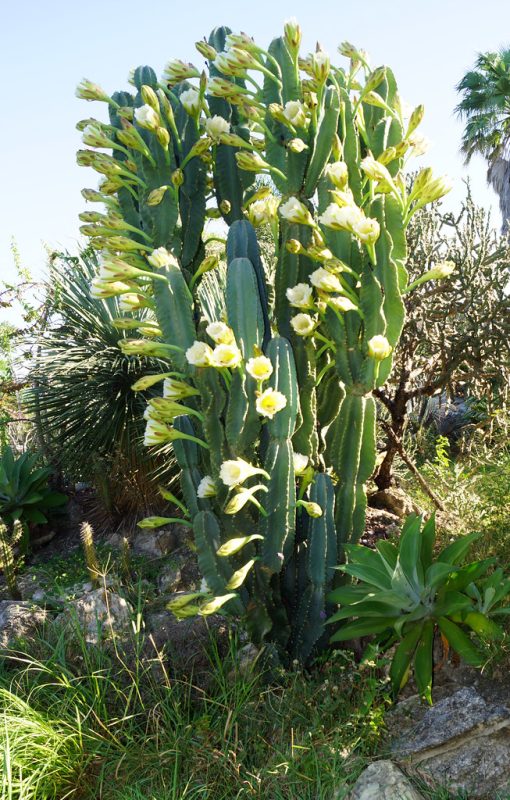
Hildmann’s Cereus (Cereus hildmannianus) is a fascinating species of cactus that adds an exotic element to desert landscaping. Distinguished by its tall, tree-like stature, Hildmann’s Cereus can grow between 6 to 15 feet tall with upright, ribbed stems. This cactus features spines that are generally soft and less intimidating than those of many other species, making it an appealing choice for gardeners who want to maintain a user-friendly landscape.
Hildmann’s Cereus is particularly notable for its striking nocturnal flowers, which bloom in summer and are typically white or creamy in appearance. These large flowers are often fragrant and can attract a variety of pollinators, including bats and moths that are drawn to their scent during the evening hours. This duality of beauty and utility makes Hildmann’s Cereus a true asset for attracting wildlife to your garden.
In terms of landscaping design, Hildmann’s Cereus is perfect for creating vertical interest in your garden. Its height allows it to stand out amid lower-growing plants, making it a strong focal point. It thrives in full sun and well-drained soils, making it suitable for various xeriscape applications. Additionally, planting Hildmann’s Cereus beside smaller flowering succulents or ground covers can create a stunning contrast that highlights the plant’s beauty while fostering biodiversity.
Giant Claret Cup
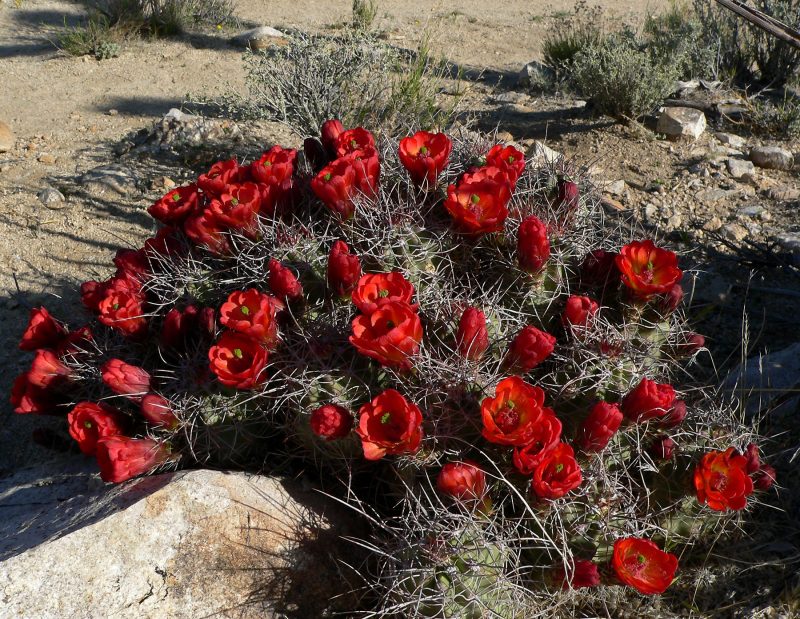
Giant Claret Cup (Echinocereus triglochidiatus) is a spectacular cactus that boasts an unforgettable appearance, often becoming a centerpiece in desert landscaping. This species is known for its stout, cylindrical stems which can grow up to 3 feet tall and feature prominent ribs decorated with bright red flowers in the spring. The blooms are not only dazzling but also attract a variety of pollinators, including bees and hummingbirds, making it an excellent choice for promoting biodiversity in your garden.
One of the defining features of the Giant Claret Cup is its ability to thrive in rocky, well-draining soils, requiring minimal water once established. This makes it a perfect specimen for xeriscaping, where conservation of water is paramount. The vibrant flowers, complemented by its striking green stems, create a bold contrast against the muted tones of gravel or desert soil, making it an aesthetically pleasing addition to your garden.
In landscape design, the Giant Claret Cup can be used to create focal points or vibrant borders in garden beds and is particularly stunning when planted in groups. Positioning this cactus in a location that receives full sun enhances its blooming potential while allowing its colors to shine. Combining it with other drought-tolerant plants, such as succulents or low-growing ground covers, can create an inviting and diverse visual palette.
Paperbag Bush
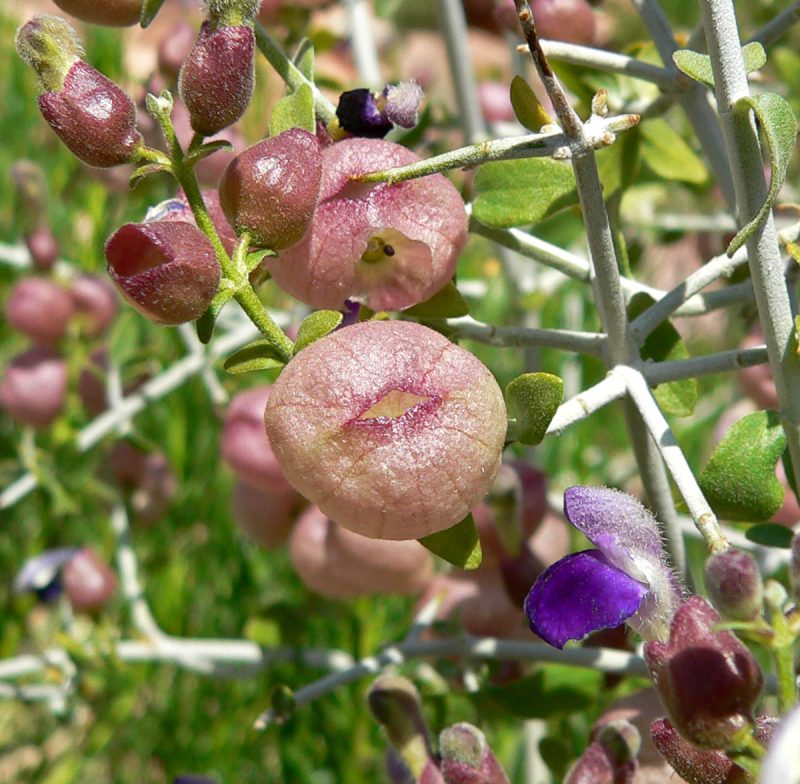
CC BY-SA 3.0
Paperbag Bush (Salazaria mexicana) is a hardy, evergreen shrub that thrives in the arid conditions of the southwestern United States and northern Mexico. It can grow from 2 to 4 feet tall, with a sprawling growth habit that creates a bushy appearance. The plant derives its whimsical name from the unique, papery texture of its leaves, which provide a distinctive visual interest and texture when landscaping.
This resilient shrub has exceptional drought tolerance, requiring little irrigation once established, making it an ideal candidate for low-maintenance gardens. Paperbag Bush produces small, inconspicuous white or yellow flowers that bloom in the spring and summer, attracting various pollinators, including bees, while providing food to local wildlife.
In landscaping applications, Paperbag Bush can be used as a unique ground cover or a noise buffer thanks to its dense foliage. Its intriguing leaf texture can add depth to desert gardens, especially when paired with other drought-resistant species. This plant is excellent for creating layered effects in gardens, offering both texture and habitat for beneficial insects. Additionally, it holds immense potential for erosion control in sandy soils, making it a functional addition to any desert landscape.
Mojave Monkeyflower

Mojave Monkeyflower (Diplacus mohavensis) is a delightful flowering perennial widely adored for its cheerful blooms. This hardy plant typically grows to about 1 to 2 feet in height and showcases bright yellow tubular flowers adorned with orange or red markings. These vibrant blooms emerge in the spring and attract a host of pollinators, particularly hummingbirds, enhancing the ecological value of your garden.
Adapted to thrive in poor, well-draining soils, the Mojave Monkeyflower is incredibly drought-resistant once established. It prefers full sun but can tolerate partial shade, adding versatility to its garden placement. Its lush green foliage provides a lovely backdrop for the striking flowers, making it a stylish choice for a variety of landscaping projects.
In landscaping design, the Mojave Monkeyflower serves well in mass plantings or as borders along walkways and pathways, providing a pop of color that can brighten up any garden. When mixed with other native plants and succulents, it can create a vibrant tapestry of colors and textures. This plant is also excellent for container gardening, where its striking blooms can be easily showcased on patios or balconies, while its resilience makes it an ideal choice for low-maintenance gardens.
Fairy Duster
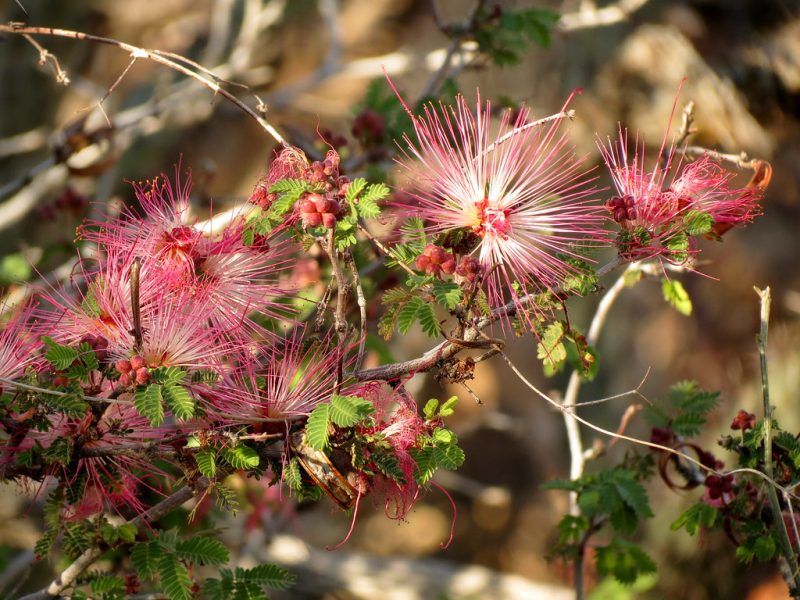
The Fairy Duster (Calliandra eriophylla) is a charming, low-growing shrub native to the southwestern United States and northern Mexico. Reaching heights of 2 to 3 feet, it produces fluffy, bright pink blooms that resemble fairy dust, hence its whimsical name. Flowering typically occurs in late spring and summer, attracting a diverse array of pollinators, particularly bees and butterflies. This plant is not only visually appealing but also plays a vital role in supporting local ecosystems.
Fairy Duster is exceptionally well-adapted to desert climates, thriving in sandy or rocky soils with excellent drainage. Once established, it requires very little water, making it an excellent choice for xeriscaping and low-maintenance gardens. Its finely divided foliage contributes to its airy appearance, allowing light to filter through, which is particularly lovely when combined with other plants.
In landscaping applications, the Fairy Duster excels as an accent plant in rock gardens or as part of diverse shrub borders. Its compact size makes it suitable for smaller garden spaces, while its vibrant blossoms provide seasonal color and texture. When grouped with other drought-tolerant species, such as Desert Marigold or Red Yucca, Fairy Duster enhances the overall design, adding to the vibrant tapestry of a well-planned desert garden.
Chuparosa
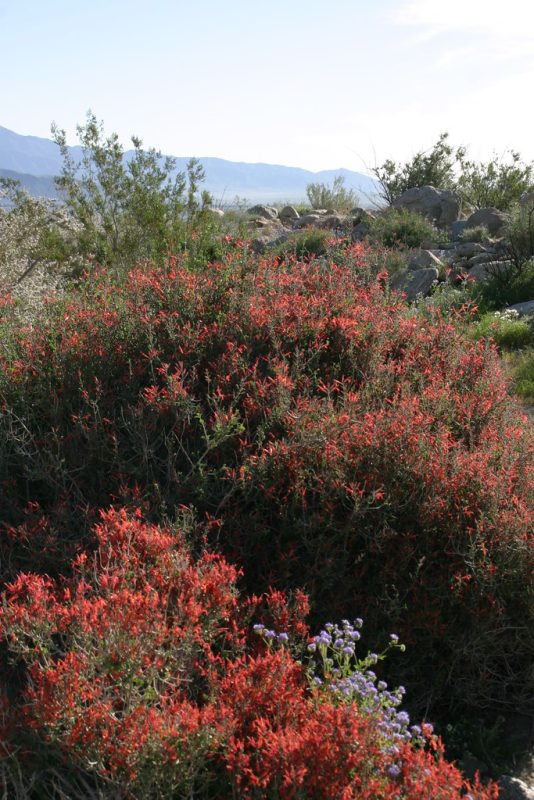
Chuparosa (Justicia californica) is a striking native shrub that adds a burst of color to desert landscapes. Known for its tubular red or orange flowers that bloom from late winter through spring, Chuparosa is an incredible attractor of hummingbirds, making it a wonderful addition for bird lovers. This medium-sized shrub grows between 3 to 5 feet tall and has a sprawling growth habit, offering generous coverage while remaining relatively low maintenance.
Chuparosa thrives in well-draining soils and can handle the intense sunlight of desert environments. Once established, it is highly drought-resistant, which contributes to its reliability in xeriscape gardens. The plant often forms dense clumps, providing excellent habitat for beneficial insects and birds. Pairing the Chuparosa with other native plants can create a multi-layered habitat, enhancing the biodiversity of your garden.
When incorporated into landscaping, Chuparosa serves beautifully as a backdrop for smaller flowering plants, or even as a standalone specimen. Its vibrant colors create an eye-catching focal point in any garden, especially when contrasting against the muted tones of the desert landscape. With its ability to attract wildlife, this shrub not only enriches gardens aesthetically but also plays an essential role in supporting local ecosystems.
Orchid Tree
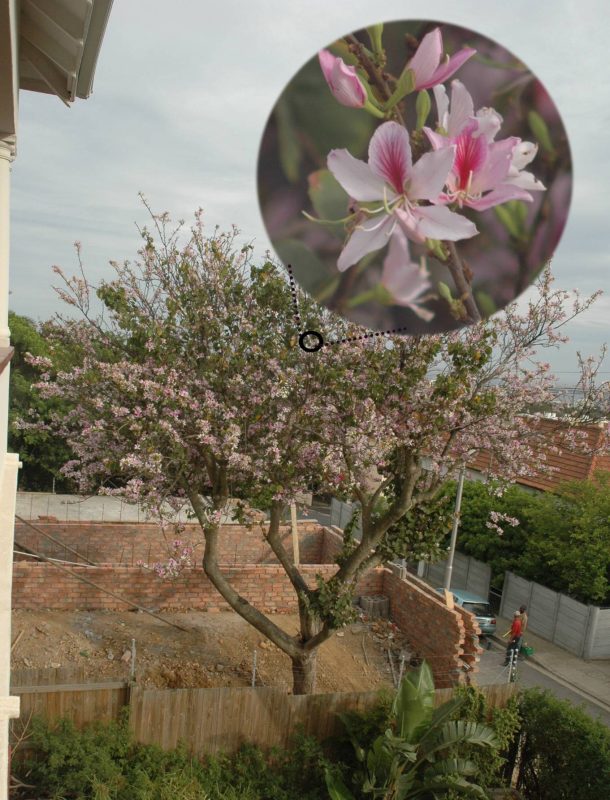
The Orchid Tree (Bauhinia variegata) is a magnificent flowering tree known for its striking orchid-like blossoms and broad, inviting canopy. This deciduous tree can reach heights of up to 30 feet and features large, attractive leaves that add a tropical feel to desert gardens. Its flowers, which can be white, pink, or purple, bloom throughout the spring and summer, making it a standout in any landscape.
Although the Orchid Tree is not a native to the desert region, it is well-adapted to arid climates and can thrive in well-draining soils. It is characterized by its ability to tolerate drought once established, requiring moderate watering during peak growth periods. This beautiful tree not only provides shade but also attracts a wide variety of pollinators, including bees and butterflies, who are drawn to its fragrant blooms.
When used in landscaping, the Orchid Tree serves as an ideal specimen for enhancing outdoor spaces. It can provide shade for patios and garden areas, making it perfect for relaxation spots in hot climates. Given its size and striking flowers, it makes for an excellent focal point in larger landscapes, often served as the centerpiece around which other garden elements are designed. Planting it with understory plants like Desert Globemallow or the fragrant Desert Lavender can create a lush, appealing garden that celebrates the beauty of the desert.
Coyote Melon
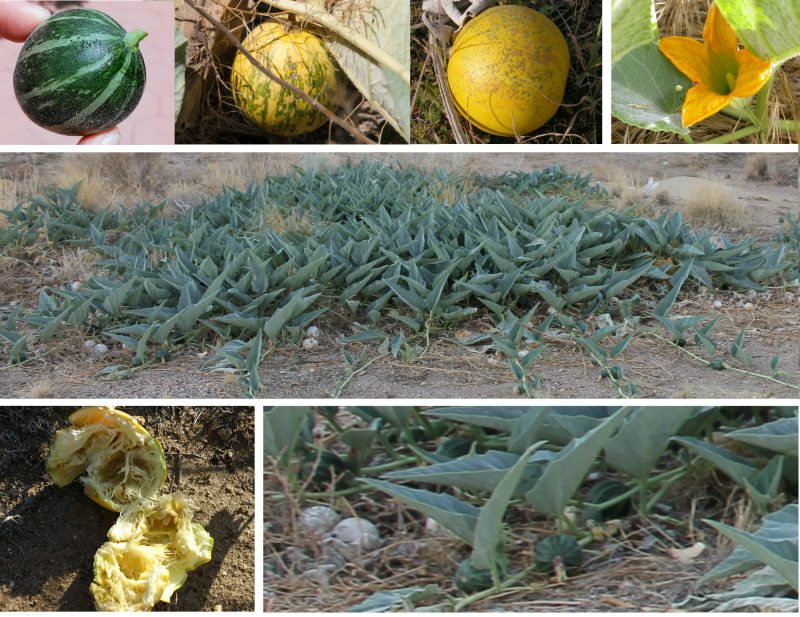
Coyote Melon (Cucurbita foetidissima) is not only visually striking but also holds a special place in the history and ecology of desert regions. Commonly known as the wild gourd, it features distinctive lobed leaves and sprawling vines. The plant produces small, round melons that, while often considered inedible due to their bitter taste, are a crucial food source for various wildlife, including birds and mammals.
This plant’s adaptability to its environment makes it suitable for homes with ample space for sprawling growth. Coyote Melon can be planted as a ground cover, effectively suppressing weeds while providing intriguing texture and cover for small critters. Its yellow flowers, opening during the warmer months, attract pollinators, making it a great addition to a garden seeking to foster biodiversity.
When incorporating Coyote Melon into your landscaping, consider its need for full sun and well-draining soil. It can be a fantastic addition to areas where you want to encourage wildlife or as part of an educational garden, showcasing plants that provide for local fauna. Given its ability to thrive in poor soil conditions, this plant can be a perfect companion to other drought-tolerant species, creating an ecosystem that promotes both beauty and biodiversity.


